

How to Write a SWOT Analysis for a Business Plan
- March 21, 2024
- Business Plan , How to Write

Navigating the complexities of business requires a clear understanding of your strategic position, and a SWOT analysis is an essential tool to help you achieve this clarity. It’s a straightforward method that breaks down into Strengths, Weaknesses, Opportunities, and Threats, providing a snapshot of where your business stands and guiding your future strategic moves.
With this guide, you’ll learn how to leverage your advantages, address challenges, seize new opportunities, and guard against potential threats. Let’s dive into the process together and set a strong foundation for your business’s strategic planning. Let’s dive in!
What is a SWOT Analysis?
A SWOT analysis is a strategic planning tool used to identify and understand the Strengths, Weaknesses, Opportunities, and Threats related to business competition or project planning. This method helps organizations in assessing both internal and external factors that could impact their objectives.
- Strengths : Positive attributes internal to the organization and within its control. Strengths are resources and capabilities that can be used as a basis for developing a competitive advantage.
- Weaknesses : Factors that are within an organization’s control but detract from its ability to attain the desired goal. These are areas the business needs to improve to remain competitive.
- Opportunities : External chances to improve performance in the environment. Opportunities reflect the potential you can leverage to grow your business or project.
- Threats : External challenges to the business’s performance or project’s success. Threats might stem from various sources, such as economic downturns, increased competition, or changes in regulatory landscapes.
Why Use a SWOT Analysis?
We use a SWOT analysis for several important reasons in business and strategic planning:
- Strategic Overview : It provides a concise and comprehensive overview of the current strategic position of the business or project. By examining internal and external factors, stakeholders can get a clear picture of their situation.
- Decision Making : SWOT analysis aids in decision-making by highlighting the strengths to leverage, weaknesses to address, opportunities to pursue, and threats to mitigate. It helps in prioritizing actions based on the analysis.
- Opportunity Identification : SWOT analysis is instrumental in identifying new opportunities for growth and expansion. Opportunities might come from market trends , economic shifts, or changes in technology.
- Risk Management : By identifying threats, organizations can develop strategies to address or mitigate these risks before they become significant issues. It’s a proactive approach to managing potential external challenges.
- Resource Allocation : Understanding the organization’s strengths and weaknesses helps in the effective allocation of resources. Resources can be directed to areas where they are needed most or where they will have the highest impact.
- Competitive Advantage : It helps businesses identify unique features and capabilities that give them a competitive edge in the market. Recognizing these strengths can guide marketing strategies and business development.
How to Write a SWOT Analysis
Writing a strength in a SWOT analysis involves identifying and articulating the internal attributes and resources of a business or project that contribute to its success and competitive advantage. Here’s how to effectively write a strength in a SWOT analysis:
- Identify Internal Positive Attributes : Focus on internal factors that are within the control of the business. These can include resources, skills, or other advantages relative to competitors. Consider areas like strong brand reputation, proprietary technology, skilled workforce, financial resources, strategic location, and efficient processes.
- Be Specific and Relevant : General statements like “we have a good team” are less helpful than specific ones like “our team includes industry-recognized experts in X field.” The more precise you are, the more actionable your analysis will be. Ensure that the strengths are directly relevant to achieving the business’s goals and objectives.
- Use Quantifiable Data When Possible : Whenever you can, back up your strengths with quantifiable data. For example, “a customer satisfaction rate of 95%” or “a 20% lower production cost than industry average” provides concrete evidence of your strengths.
- Compare to Competitors : Strengths are often relative to the competition. Identify areas where your business outperforms competitors or fills a gap in the market. This might involve superior product quality, a unique service model, or a more extensive distribution network.
Example: Instead of simply stating “Experienced management team” as a strength, you could write: “Our management team has over 50 years of combined experience in the tech industry, including a track record of successful product launches and market expansions. This depth of experience provides us with strategic insights and operational expertise that have consistently resulted in market share growth and above-industry-average profitability.”
Writing a weakness in a SWOT analysis involves acknowledging and detailing the internal factors that limit or challenge your business or project’s ability to achieve its goals. Here’s a structured approach to effectively articulate weaknesses in a SWOT analysis:
- Identify Internal Limitations : Focus on internal attributes that are within the control of the organization but currently act as disadvantages. Weaknesses might include insufficient resources, lack of expertise, outdated technology, poor location, limited product range, or inefficiencies in processes.
- Be Specific and Honest : It’s important to be honest and specific about your organization’s weaknesses. Vague statements won’t help in addressing these issues. For instance, rather than saying “we need to improve our marketing,” specify “our current marketing strategy does not effectively reach our target demographic of 18-25-year-olds on digital platforms.”
- Use Internal Comparisons and Feedback : Compare your performance, processes, and resources against your own past performance or industry benchmarks. Utilize customer feedback, employee insights, and performance data to identify areas of weakness.
- Keep it Constructive : While it’s crucial to be honest about weaknesses, frame them in a way that focuses on potential for improvement. Consider each weakness as an area for development and growth.
Example: Instead of a broad statement like “Inadequate online presence,” a more effective description would be: “Our business currently lacks a robust online presence, reflected in our outdated website and minimal engagement on key social media platforms. This limits our ability to attract younger demographics who predominantly discover and interact with brands online. Improving our online visibility and engagement could enhance brand awareness and customer acquisition.”
Opportunities
Writing opportunities in a SWOT analysis involves identifying and articulating external factors that your business or project could exploit to its advantage. Opportunities are elements in the environment that, if leveraged effectively, could provide a pathway for growth, improvement, or competitive advantage. Here’s how to systematically approach writing opportunities in your SWOT analysis:
- Spot External Trends : Focus on the trends and changes outside your organization that could be beneficial. These might include technological advancements, shifts in consumer behavior, market gaps, regulatory changes, or economic trends.
- Be Relevant and Actionable : Ensure that the opportunities you identify are relevant to your business and actionable. They should align with your business’s strengths and capabilities, allowing you to take practical steps toward capitalizing on them.
- Use Market Research : Base your identification of opportunities on solid market research. Understand your target market , industry trends, and the competitive landscape to pinpoint where the real opportunities lie.
- Detail Potential Benefits : Clearly articulate how each opportunity could benefit your business. Whether it’s entering a new market, launching a new product line, or adopting new technology, explain the potential impact on your business growth and success.
Example: Rather than vaguely stating “New market segments,” a more strategic description of an opportunity could be: “With increasing consumer interest in sustainable living, there’s a growing market segment for eco-friendly products. Our business’s strong commitment to sustainability and existing lineup of environmentally friendly products positions us well to capture this emerging market. Expanding our product range to include more items that cater to eco-conscious consumers can tap into this trend, potentially opening up new revenue streams and enhancing our brand’s reputation as a leader in sustainability.”
Writing threats in a SWOT analysis involves identifying external challenges that could pose risks to your business or project’s success. These are factors outside your control that have the potential to harm your operations, financial performance, or strategic positioning. Addressing threats effectively in a SWOT analysis requires a focused approach:
- Identify External Challenges : Start by pinpointing the external factors that could negatively impact your business. This can include new competitors entering the market, changes in consumer preferences, technological advancements that render your product less desirable, regulatory changes, or economic downturns.
- Be Precise and Realistic : Clearly define each threat in specific terms, avoiding vague descriptions. Being realistic about the level of risk each threat poses is crucial; not every external challenge is a dire threat, but understanding the potential impact is key for strategic planning.
- Assess the Impact : For each threat identified, evaluate how it could impact your business. Consider the worst-case scenario and more likely outcomes to gauge the potential severity of the threat. This helps in prioritizing which threats need immediate attention and strategic response.
- Use Reliable Sources : Base your identification of threats on solid, reliable information. This might include industry reports, economic forecasts, and news sources that provide insights into market dynamics and external conditions.
- Consider Your Weaknesses : Link potential threats to your identified weaknesses. Understanding how external threats could exploit your vulnerabilities offers valuable insights for fortifying your business against these challenges.
Example: Instead of broadly stating “Economic uncertainty,” a more actionable description of a threat would be: “The looming economic downturn poses a significant threat to discretionary consumer spending. Given our business’s reliance on non-essential luxury products, a reduction in consumer spending could directly impact sales. This economic uncertainty requires us to diversify our product offerings and identify more value-oriented options to maintain customer engagement and spending during tighter economic conditions.”
Related Posts

Pro One Janitorial Franchise Costs $9K – $76K (2024 Fees & Profits)
- June 25, 2024

Dance Studio Business Plan PDF Example
- June 17, 2024
- Business Plan

Carpet and Upholstery Cleaning Business Plan PDF Example
Privacy overview.
| Cookie | Duration | Description |
|---|---|---|
| BIGipServerwww_ou_edu_cms_servers | session | This cookie is associated with a computer network load balancer by the website host to ensure requests are routed to the correct endpoint and required sessions are managed. |
| cookielawinfo-checkbox-advertisement | 1 year | Set by the GDPR Cookie Consent plugin, this cookie is used to record the user consent for the cookies in the "Advertisement" category . |
| cookielawinfo-checkbox-analytics | 11 months | This cookie is set by GDPR Cookie Consent plugin. The cookie is used to store the user consent for the cookies in the category "Analytics". |
| cookielawinfo-checkbox-functional | 11 months | The cookie is set by GDPR cookie consent to record the user consent for the cookies in the category "Functional". |
| cookielawinfo-checkbox-necessary | 11 months | This cookie is set by GDPR Cookie Consent plugin. The cookies is used to store the user consent for the cookies in the category "Necessary". |
| cookielawinfo-checkbox-others | 11 months | This cookie is set by GDPR Cookie Consent plugin. The cookie is used to store the user consent for the cookies in the category "Other. |
| cookielawinfo-checkbox-performance | 11 months | This cookie is set by GDPR Cookie Consent plugin. The cookie is used to store the user consent for the cookies in the category "Performance". |
| CookieLawInfoConsent | 1 year | Records the default button state of the corresponding category & the status of CCPA. It works only in coordination with the primary cookie. |
| elementor | never | This cookie is used by the website's WordPress theme. It allows the website owner to implement or change the website's content in real-time. |
| viewed_cookie_policy | 11 months | The cookie is set by the GDPR Cookie Consent plugin and is used to store whether or not user has consented to the use of cookies. It does not store any personal data. |
| Cookie | Duration | Description |
|---|---|---|
| __cf_bm | 30 minutes | This cookie, set by Cloudflare, is used to support Cloudflare Bot Management. |
| language | session | This cookie is used to store the language preference of the user. |
| Cookie | Duration | Description |
|---|---|---|
| _ga | 2 years | The _ga cookie, installed by Google Analytics, calculates visitor, session and campaign data and also keeps track of site usage for the site's analytics report. The cookie stores information anonymously and assigns a randomly generated number to recognize unique visitors. |
| _ga_QP2X5FY328 | 2 years | This cookie is installed by Google Analytics. |
| _gat_UA-189374473-1 | 1 minute | A variation of the _gat cookie set by Google Analytics and Google Tag Manager to allow website owners to track visitor behaviour and measure site performance. The pattern element in the name contains the unique identity number of the account or website it relates to. |
| _gid | 1 day | Installed by Google Analytics, _gid cookie stores information on how visitors use a website, while also creating an analytics report of the website's performance. Some of the data that are collected include the number of visitors, their source, and the pages they visit anonymously. |
| browser_id | 5 years | This cookie is used for identifying the visitor browser on re-visit to the website. |
| WMF-Last-Access | 1 month 18 hours 11 minutes | This cookie is used to calculate unique devices accessing the website. |
SWOT Analysis: How To Do One [With Template & Examples]
Published: October 05, 2023
As your business grows, you need a roadmap to help navigate the obstacles, challenges, opportunities, and projects that come your way. Enter: the SWOT analysis.

This framework can help you develop a plan to determine your priorities, maximize opportunities, and minimize roadblocks as you scale your organization. Below, let’s go over exactly what a SWOT analysis is, a few SWOT analysis examples, and how to conduct one for your business.
![business plan e analisi swot → Download Now: Market Research Templates [Free Kit]](https://no-cache.hubspot.com/cta/default/53/6ba52ce7-bb69-4b63-965b-4ea21ba905da.png)
When you’re done reading, you’ll have all the inspiration and tactical advice you need to tackle a SWOT analysis for your business.
What is a SWOT analysis? Importance of a SWOT Analysis How to Write a Good SWOT Analysis SWOT Analysis Examples How to Act on a SWOT Analysis
What is a SWOT analysis?
A SWOT analysis is a strategic planning technique that puts your business in perspective using the following lenses: Strengths, Weaknesses, Opportunities, and Threats. Using a SWOT analysis helps you identify ways your business can improve and maximize opportunities, while simultaneously determining negative factors that might hinder your chances of success.
While it may seem simple on the surface, a SWOT analysis allows you to make unbiased evaluations on:
- Your business or brand.
- Market positioning.
- A new project or initiative.
- A specific campaign or channel.
Practically anything that requires strategic planning, internal or external, can have the SWOT framework applied to it, helping you avoid unnecessary errors down the road from lack of insight.

Free SWOT Analysis Template
A free SWOT analysis template, plus other helpful market research resources.
Opportunities
Download free.
All fields are required.
You're all set!
Click this link to access this resource at any time.
Importance of a SWOT Analysis
You’ve noticed by now that SWOT stands for Strengths, Weaknesses, Opportunities, and Threats. The framework seems simple enough that you’d be tempted to forgo using it at all, relying instead on your intuition to take these things into account.
But you shouldn’t. Doing a SWOT analysis is important. Here’s why.
SWOT gives you the chance to worry and to dream.
A SWOT analysis is an important step in your strategic process because it gives you the opportunity to explore both the potential risks and the exciting possibilities that lie ahead. You’re giving yourself the space to dream, evaluate, and worry before taking action. Your insights then turn into assets as you create the roadmap for your initiative.
For instance, when you consider the weaknesses and threats that your business may face, you can address any concerns or challenges and strategize on how to mitigate those risks. At the same time, you can identify strengths and opportunities, which can inspire innovative ideas and help you dream big. Both are equally important.
SWOT forces you to define your variables.
Instead of diving head first into planning and execution, you’re taking inventory of all your assets and roadblocks. This process will help you develop strategies that leverage your strengths and opportunities while addressing and mitigating the impact of weaknesses and threats.
As a result, you'll gain a comprehensive understanding of your current situation and create a more specific and effective roadmap. Plus, a SWOT analysis is inherently proactive. That means you'll be better equipped to make informed decisions, allocate resources effectively, and set realistic goals.
SWOT allows you to account for mitigating factors.
As you identify weaknesses and threats, you’re better able to account for them in your roadmap, improving your chances of success.
Moreover, accounting for mitigating factors allows you to allocate your resources wisely and make informed decisions that lead to sustainable growth. With a SWOT analysis as a guide, you can confidently face challenges and seize opportunities.
SWOT helps you keep a written record.
As your organization grows and changes, you’ll be able to strike things off your old SWOTs and make additions. You can look back at where you came from and look ahead at what’s to come.
In other words, SWOT analyses serve as a tangible history of your progress and provide a reference point for future decision-making. With each update, your SWOT analysis becomes a living document that guides your strategic thinking and helps you stay agile and adaptable in an ever-changing business landscape.
By maintaining this written record, you foster a culture of continuous improvement and empower your team to make data-driven decisions and stay aligned with your long-term vision.
Parts of a SWOT Analysis
Conducting a SWOT analysis will help you strategize effectively, unlock valuable insights, and make informed decisions. But what exactly does a SWOT analysis include?
Let’s explore each component: Strengths, Weaknesses, Opportunities, and Threats.

Your strengths are the unique advantages and internal capabilities that give your company a competitive edge in the market. A strong brand reputation, innovative products or services, or exceptional customer service are just a few examples. By identifying and capitalizing on your strengths, you can foster customer loyalty and build a solid foundation for growth.

No business is flawless. Weaknesses are areas where you may face challenges or fall short of your potential. It could be outdated processes, skill gaps within the team, or inadequate resources. By acknowledging these weaknesses, you can establish targeted initiatives for improvement, upskill your team, adopt new technologies, and enhance your overall operational efficiency.

Opportunities are external factors that can contribute to your company's progress. These may include emerging markets, technological advancements, changes in consumer behavior, or gaps in the market that your company can fill. By seizing these opportunities, you can expand your market reach, diversify your product offerings, forge strategic partnerships, or even venture into untapped territories.

Threats are external factors that are beyond your control and pose challenges to your business. Increased competition, economic volatility, evolving regulatory landscapes, or even changing market trends are examples of threats. By proactively assessing and addressing them, you can develop contingency plans, adjust your strategies, and minimize their impact on your operations.
In a SWOT analysis, you’ll have to take both internal and external factors into account. We’ll cover those next.
.png)
Free Market Research Kit
5 Research and Planning Templates + a Free Guide on How to Use Them in Your Market Research
- SWOT Analysis Template
- Survey Template
- Focus Group Template
SWOT Analysis Internal and External Factors
A SWOT analysis typically has internal (i.e., within your organization) and external (i.e., outside your organization) factors at play. Here's a breakdown of each.
Internal Factors
Internal factors refer to the characteristics and resources within your organization that directly influence its operations and performance. These factors are completely within your organization's control, so they can be modified, improved, or capitalized upon.
In a SWOT analysis, strengths and weaknesses are categorized as internal factors. Let’s look at a few examples.
- Brand reputation
- Unique expertise
- Loyal customer base
- Talented workforce
- Efficient processes
- Proprietary technology
- Outdated technology
- Inadequate resources
- Poor financial health
- Inefficient processes
- Skill gaps within the team
External Factors
External factors are elements outside the organization's control that have an impact on its operations, market position, and success. These factors arise from the industry climate and the broader business environment. You typically have no control over external factors, but you can respond to them.
In a SWOT analysis, opportunities and threats are categorized as external factors. Let’s look at a few examples.
- Emerging markets
- Changing consumer trends
- Technological advancements
- Positive shifts in regulations
- New gaps in the market you could fill
- Intense competition
- Economic downturns
- Disruptive technologies
- Changing regulations
- Negative shifts in consumer behavior
Remember, a well-rounded SWOT analysis empowers you to capitalize on strengths, address weaknesses, seize opportunities, and navigate threats — all while making informed decisions for the future.
Now, let’s take a look at how you can write a good SWOT analysis for yourself or for stakeholders.
How do you write a good SWOT analysis?
There are several steps you’ll want to take when evaluating your business and conducting a strategic SWOT analysis.
1. Download HubSpot's SWOT Analysis Template.
There’s no need to start from scratch for your analysis. Instead, start by downloading a free, editable template from HubSpot. Feel free to use the model yourself, or create your own as it suits your needs.

3. Identify your objective.
Before you start writing things down, you’ll need to figure out what you’re evaluating with your SWOT analysis.
Be specific about what you want to analyze. Otherwise, your SWOT analysis may end up being too broad, and you’ll get analysis paralysis as you are making your evaluations.
If you’re creating a new social media program, you’ll want to conduct an analysis to inform your content creation strategy. If you’re launching a new product, you’ll want to understand its potential positioning in the space. If you’re considering a brand redesign, you’ll want to consider existing and future brand conceptions.
All of these are examples of good reasons to conduct a SWOT analysis. By identifying your objective, you’ll be able to tailor your evaluation to get more actionable insights.
4. Identify your strengths.
“Strengths” refers to what you are currently doing well. Think about the factors that are going in your favor as well as the things you offer that your competitors just can’t beat.
For example, let’s say you want to use a SWOT analysis to evaluate your new social media strategy.
If you’re looking at a new social media program, perhaps you want to evaluate how your brand is perceived by the public. Is it easily recognizable and well-known? Even if it’s not popular with a widespread group, is it well-received by a specific audience?
Next, think about your process: Is it effective or innovative? Is there good communication between marketing and sales?
Finally, evaluate your social media message, and in particular, how it differs from the rest of the industry. I’m willing to bet you can make a lengthy list of some major strengths of your social media strategy over your competitors, so try to dive into your strengths from there.
5. Identify your weaknesses.
In contrast to your strengths, what are the roadblocks hindering you from reaching your goals? What do your competitors offer that continues to be a thorn in your side?
This section isn’t about dwelling on negative aspects. Rather, it’s critical to foresee any potential obstacles that could mitigate your success.
When identifying weaknesses, consider what areas of your business are the least profitable, where you lack certain resources, or what costs you the most time and money. Take input from employees in different departments, as they’ll likely see weaknesses you hadn’t considered.
If you’re examining a new social media strategy, you might start by asking yourself these questions: First, if I were a consumer, what would prevent me from buying this product, or engaging with this business? What would make me click away from the screen?
Second, what do I foresee as the biggest hindrance to my employees’ productivity, or their ability to get the job done efficiently? What derails their social media efforts?
6. Consider your opportunities.
This is your chance to dream big. What are some opportunities for your social media strategy you hope, but don’t necessarily expect, to reach?
For instance, maybe you’re hoping your Facebook ads will attract a new, larger demographic. Maybe you’re hoping your YouTube video gets 10,000 views and increases sales by 10%.
Whatever the case, it’s important to include potential opportunities in your SWOT analysis. Ask yourself these questions:
- What technologies do I want my business to use to make it more effective?
- What new target audience do I want to reach?
- How can the business stand out more in the current industry?
- Is there something our customers complain about that we could fix?
The opportunities category goes hand-in-hand with the weaknesses category. Once you’ve made a list of weaknesses, it should be easy to create a list of potential opportunities that could arise if you eliminate your weaknesses.
7. Contemplate your threats.
It’s likely, especially if you’re prone to worry, you already have a good list of threats in your head.
If not, gather your employees and brainstorm. Start with these questions:
- What obstacles might prevent us from reaching our goals?
- What’s going on in the industry, or with our competitors, that might mitigate our success?
- Is there new technology out there that could conflict with our product?
Writing down your threats helps you evaluate them objectively.
For instance, maybe you list your threats in terms of least and most likely to occur and divide and conquer each. If one of your biggest threats is your competitor’s popular Instagram account, you could work with your marketing department to create content that showcases your product’s unique features.
SWOT Analysis Chart

Download a free SWOT analysis chart included in HubSpot’s free market research kit .
A SWOT analysis doesn’t have to be fancy. Our SWOT analysis chart provides a clear and structured framework for capturing and organizing your internal strengths and weaknesses, and external opportunities and threats. It's the perfect visual aid to make sense of the wealth of information gathered during your analysis.
(Plus, you can always customize and paste it into a document you plan to share with stakeholders.)
But remember: Filling out the SWOT chart is just one step in the process. Combine it with our entire market research kit , and you'll have all the tools necessary to help your organization navigate new opportunities and threats.
SWOT Analysis Examples
The template above helps get you started on your own SWOT analysis.
But, if you’re anything like me, it’s not enough to see a template. To fully understand a concept, you need to see how it plays out in the real world.
These SWOT examples are not exhaustive. However, they are a great starting point to inspire you as you do your own SWOT analysis.
Apple’s SWOT analysis
Here’s how we’d conduct a SWOT analysis on Apple.

First off, strengths. While Apple has many strengths, let’s identify the top three:
- Brand recognition.
- Innovative products.
- Ease of use.
Apple’s brand is undeniably strong, and its business is considered the most valuable in the world . Since it’s easily recognized, Apple can produce new products and almost ensure a certain degree of success by virtue of the brand name itself.
Apple’s highly innovative products are often at the forefront of the industry. One thing that sets Apple apart from the competition is its product inter-connectivity.
For instance, an Apple user can easily sync their iPhone and iPad together. They can access all of their photos, contacts, apps, and more no matter which device they are using.
Lastly, customers enjoy how easy it is to use Apple’s products. With a sleek and simple design, each product is developed so that most people can quickly learn how to use them.
Next, let’s look at three of Apple’s weaknesses.
- High prices
- Closed ecosystem
- Lack of experimentation
While the high prices don’t deter Apple’s middle- and upper-class customer base, they do hinder Apple’s ability to reach a lower-class demographic.
Apple also suffers from its own exclusivity. Apple controls all its services and products in-house, and while many customers become loyal brand advocates for this reason, it means all burdens fall on Apple employees.
Ultimately, Apple’s tight control over who distributes its products limits its market reach.
Lastly, Apple is held to a high standard when it comes to creating and distributing products. Apple’s brand carries a high level of prestige. That level of recognition inhibits Apple from taking risks and experimenting freely with new products that could fail.
Now, let’s take a look at opportunities for Apple.
It’s easy to recognize opportunities for improvement, once you consider Apple’s weaknesses. Here’s a list of three we came up with:
- Expand distribution options.
- Create new product lines.
- Technological advancement.
One of Apple’s biggest weaknesses is its distribution network, which, in the name of exclusivity, remains relatively small. If Apple expanded its network and enabled third-party businesses to sell its products, it could reach more people globally, while alleviating some of the stress currently put on in-house employees.
There are also plenty of opportunities for Apple to create new products. Apple could consider creating more affordable products to reach a larger demographic, or spreading out into new industries — Apple self-driving cars, perhaps?
Finally, Apple could continue advancing its products’ technology. Apple can take existing products and refine them, ensuring each product offers as many unique features as possible.
Finally, let’s look at threats to Apple.
Believe it or not, they do exist.
Here are three of Apple’s biggest threats:
- Tough competition.
- International issues.
Apple isn’t the only innovative tech company out there, and it continues to face tough competition from Samsung, Google, and other major forces. In fact, Samsung sold more smartphones than Apple did in Q1 of 2022 , shipping 17 million more units than Apple and holding 24% of the market share.
Many of Apple’s weaknesses hinder Apple’s ability to compete with the tech corporations that have more freedom to experiment, or that don’t operate in a closed ecosystem.
A second threat to Apple is lawsuits. Apple has faced plenty of lawsuits, particularly between Apple and Samsung . These lawsuits interfere with Apple’s reputable image and could steer some customers to purchase elsewhere.
Finally, Apple needs to improve its reach internationally. The company isn’t number one in China and doesn’t have a very positive relationship with the Chinese government. In India, which has one of the largest consumer markets in the world, Apple’s market share is low , and the company has trouble bringing stores to India’s market.
If Apple can’t compete globally the way Samsung or Google can, it risks falling behind in the industry.
Starbucks SWOT Analysis
Now that we’ve explored the nuances involved with a SWOT analysis, let’s fill out a SWOT template using Starbucks as an example.
Here’s how we’d fill out a SWOT template if we were Starbucks:

Download this Template for Free
Restaurant Small Business SWOT Analysis
Some small business marketers may have difficulty relating to the SWOTs of big brands like Apple and Starbucks. Here’s an example of how a dine-in Thai restaurant might visualize each element.
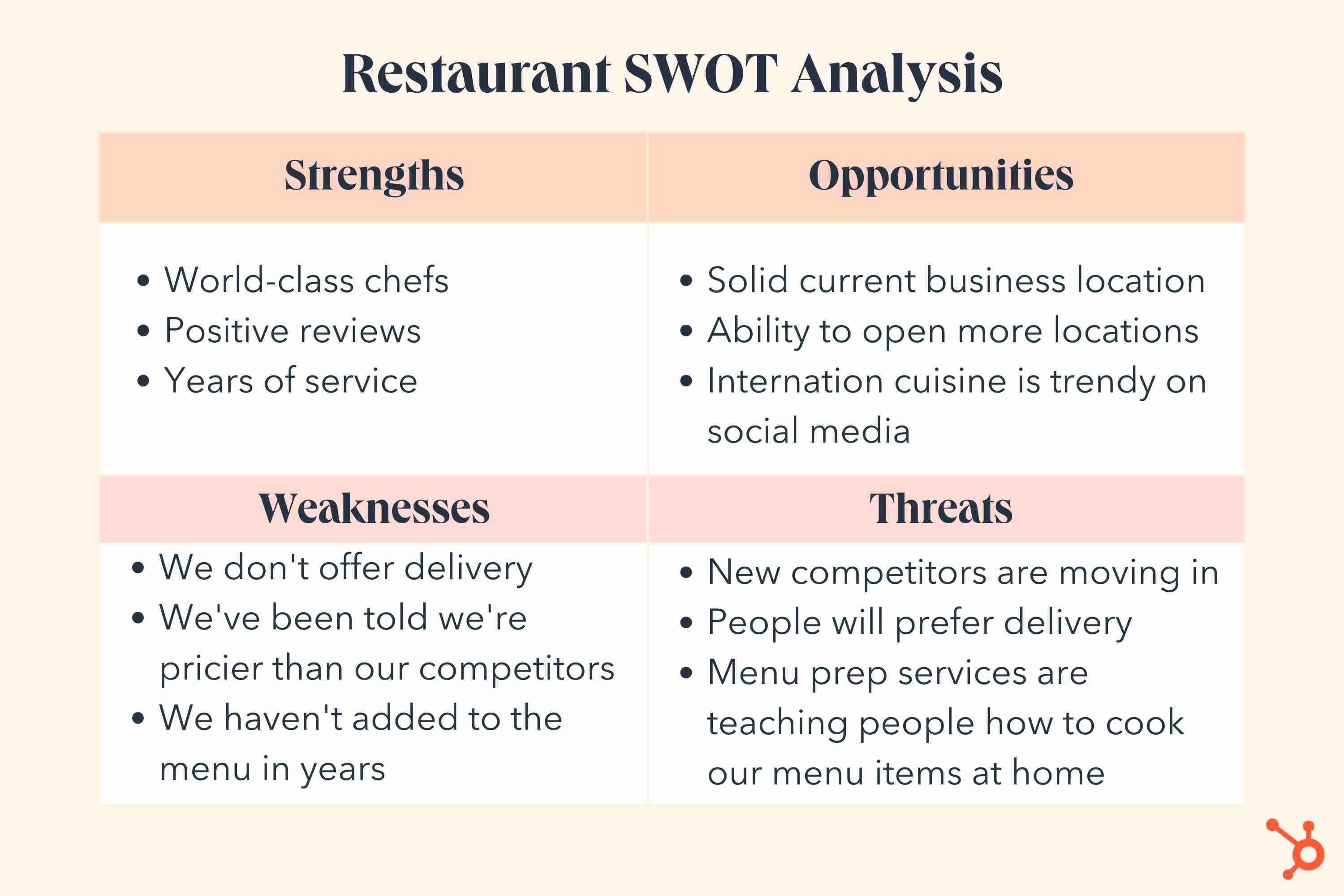
Small restaurants can lean into their culinary expertise and service skills to find opportunities for growth and brand awareness. A SWOT analysis can also help identify weaknesses that can be improved, such as menu variation and pricing.
While a restaurant might not be as worried about high-level lawsuits, a small business might be more concerned about competitors or disruptors that might enter the playing field.
Local Boutique SWOT Analysis
In another small business example, let’s take a look at a SWOT analysis for a local boutique.

This shop might be well known in its neighborhood, but it also might take time to build an online presence or get its products in an online store.
Because of this, some of its strengths and opportunities might relate to physical factors while weaknesses and threats might relate to online situations.
How to Act on a SWOT Analysis
After conducting a SWOT analysis, you may be asking yourself: What’s next?
Putting together a SWOT analysis is only one step. Executing the findings identified by the analysis is just as important — if not more.
Put your insights into action using the following steps.
Take advantage of your strengths.
Use your strengths to pursue opportunities from your analysis.
For example, if we look at the local boutique example above, the strength of having affordable prices can be a value proposition. You can emphasize your affordable prices on social media or launch an online store.
Address your weaknesses.
Back to the boutique example, one of its weaknesses is having a poor social media presence. To mitigate this, the boutique could hire a social media consultant to improve its strategy. They may even tap into the expertise of a social-savvy employee.
Make note of the threats.
Threats are often external factors that can’t be controlled, so it’s best to monitor the threats outlined in your SWOT analysis to be aware of their impacts on your business.
When to Use a SWOT Analysis
While the examples above focus on business strategy in general, you can also use a SWOT analysis to evaluate and predict how a singular product will play out in the market.
Ultimately, a SWOT analysis can measure and tackle both big and small challenges, from deciding whether or not to launch a new product to refining your social media strategy.
Editor's note: This post was originally published in May 2018 and has been updated for comprehensiveness.

Don't forget to share this post!
Related articles.

26 Tools & Resources for Conducting Market Research

What is a Competitive Analysis — and How Do You Conduct One?

Market Research: A How-To Guide and Template

TAM, SAM & SOM: What Do They Mean & How Do You Calculate Them?
![business plan e analisi swot How to Run a Competitor Analysis [Free Guide]](https://www.hubspot.com/hubfs/Google%20Drive%20Integration/how%20to%20do%20a%20competitor%20analysis_122022.jpeg)
How to Run a Competitor Analysis [Free Guide]
![business plan e analisi swot 5 Challenges Marketers Face in Understanding Audiences [New Data + Market Researcher Tips]](https://www.hubspot.com/hubfs/challenges%20marketers%20face%20in%20understanding%20the%20customer%20.png)
5 Challenges Marketers Face in Understanding Audiences [New Data + Market Researcher Tips]

Causal Research: The Complete Guide

Total Addressable Market (TAM): What It Is & How You Can Calculate It

What Is Market Share & How Do You Calculate It?
![business plan e analisi swot 3 Ways Data Privacy Changes Benefit Marketers [New Data]](https://www.hubspot.com/hubfs/how-data-privacy-benefits-marketers_1.webp)
3 Ways Data Privacy Changes Benefit Marketers [New Data]
Download a free SWOT analysis template in our free market research kit.
Marketing software that helps you drive revenue, save time and resources, and measure and optimize your investments — all on one easy-to-use platform
Small Business Trends
Swot analysis guide: powerful examples and a free template.
Table of Contents
What is a SWOT Analysis
For example, a dip in profit margins for a business can be scrutinized using a SWOT analysis. This tool helps identify internal factors, such as inefficient practices or inflated costs, that might be causing this dip. Using the SWOT pillars – strengths, weaknesses, opportunities, and threats – one can derive strategies to rectify the problem and enhance profit margins.
A SWOT analysis serves as a cornerstone for strategic planning, enabling businesses to align their goals with internal capabilities and market realities. Strengths and Weaknesses are introspective elements, helping businesses to capitalize on their unique competencies and address internal shortcomings.
Be sure to watch SmartDraw’s insightful video, ‘What is SWOT? Definition, Examples and How to Do a SWOT Analysis.’ It’s a great addition to our comprehensive SWOT Analysis Guide, reinforcing key concepts and showcasing practical examples. This video enhances your understanding and makes the whole process of performing a SWOT analysis more digestible and engaging.
What is the Goal of a SWOT Analysis?
By understanding the internal and external factors that impact the business, organizations can make informed decisions about allocating resources, pursuing growth opportunities, and minimizing risks.
Pros of SWOT Analysis
Cons of swot analysis, breaking down a swot analysis (strengths, weaknesses, opportunities, and threats).
Writing a good SWOT analysis is crucial for small businesses looking to expand quickly and maintain a competitive edge over emerging competitors. It serves as a strategic planning tool that enables businesses to assess their internal strengths and weaknesses, as well as external opportunities and threats.
This could include external environment factors such as pricing, competition, lowered demand, and more. It can also include internal weaknesses that negatively affect the business, such as a lack of budget, small teams, etc.
Opportunities
The threats part of SWOT analyses can also scare off many. Essentially, the goal here is to look at potential threats that could negatively impact your business. Again, this can include internal issues and external threats that you identify.
By methodically examining these elements, a business can develop strategies that leverage their strong points, improve weaknesses, reinforce opportunities, and guard against external threats.
External and Internal Factors
Internal factors.
It is essential to understand your strengths and weaknesses in these areas to make strategic decisions and strengthen your competitive position.
It enables you to make informed financial decisions, such as allocating funds for research and development, marketing campaigns, or infrastructure improvements.
External Factors
External factors can present opportunities or threats to your business. For example, a growing market or favorable economic conditions can create opportunities for expansion and increased demand for your products or services.
Home Depot Example
Home Depot identified several noteworthy strengths, including high-quality customer service, strong brand recognition, and positive supplier relationships. Conversely, its weaknesses were identified as a constrained supply chain, reliance on the U.S. market, and a business model that could be easily replicated.
How do You do a SWOT Analysis?
The following table breaks down the SWOT analysis that follows into simple steps, making it easy to understand and follow. It serves as a concise, clear guide, making the process less overwhelming and more manageable.
| Steps for SWOT Analysis | Description |
|---|---|
| Step 1: Gather Data | Gather internal and external data about your company or yourself. This data, which includes financial statements, customer feedback, and industry trends, will help you identify your strengths and weaknesses and potential opportunities and threats. |
| Step 2: Brainstorm | Brainstorm around the data, breaking it down into categories of strengths, weaknesses, opportunities, and threats. Be open to all ideas and make an exhaustive list as a foundation for further exploration. |
| Step 3: Analyze Strengths | Objectively analyze the strengths, asking questions about your main advantages, resources, and unique features. The goal is to gain insight into what makes you or your business successful. |
| Step 4: Analyze Weaknesses | After analyzing strengths, move on to weaknesses. Identify areas that could be improved and aspects that require more information for better decision-making. |
| Step 5: Identify Opportunities | Look towards external factors to find potential opportunities for change and growth. Keep up with current events and developments to open your mind to alternative options. |
| Step 6: Analyze Threats | Identify possible external threats such as competition and disruptions. Regular monitoring of outside forces is essential to make informed decisions quickly when needed. |
| Step 7: Construct an Action Plan + Implement Solutions | Using insights from the above steps, construct an action plan with set goals, responsibilities, and timelines. Implement the solutions within your organization to meet your targets efficiently. |
Step 1: Gather Data
Financial statements, employee feedback.
Employee feedback is an essential resource for any company looking to conduct an effective SWOT Analysis. This data can provide insight into the issues facing your business, as well as potential solutions that could be beneficial for the company.
Step 2: Brainstorm
As an illustration, let’s consider a hedge fund that has devised an exclusive trading strategy generating exceptional returns that outperform the market. The fund now faces the task of determining the most effective approach to utilize these outcomes in order to appeal to prospective investors and expand its investor base.
Step 3: Analyze Strengths
The next step is analyzing the strength category by asking questions such as what are your main advantages, what resources do you have access to, or what makes your company stand out in the market. Looking at these inquiries objectively will allow you to gain insight into what makes you or your company successful.
Unique Features
Step 4: analyze weaknesses.
Where can decisions be better informed? Allowing yourself and your team time to think about areas that need attention ensures that possible solutions can be discussed further down the line.
Improvements
Decision-making, step 5: identify opportunities.
In order to find potential opportunities for change and growth look toward external factors such as what new technologies are emerging, what regulations are changing, and whether there are gaps in current products or services providing space for improvement. Keeping up with current events opens your mind up to alternative options.
Step 6: Analyze Threats
Step 7: construct an action plan + implement solutions, swot analysis template.
Now that we’ve gone through some examples in different industries, how do you get started on creating a SWOT analysis of your own? Luckily, this kind of analysis is pretty easy to structure. You can create one using your computer or even just divide a piece of paper into four quadrants and start writing.
SWOT Analysis Examples
When trying to come up with a SWOT analysis for your own business, it’s sometimes easier to see what others in your industry are doing. Before conducting a SWOT analysis for your company, you can look at some examples below to get some inspiration.
SWOT Analysis Example: Small Business
Marketing swot analysis, 3. company swot analysis example, swot analysis example for a restaurant.
Food service businesses tend to have their own unique challenges, so identifying potential strategies is often difficult. However, using a Restaurant SWOT analysis example, you can build off it and create a SWOT analysis for your business that’s reflective of the market.
Acting on Your Results
Swot analysis tips.
A strong SWOT analysis is about diving deep into your business and collating all the information in an organized way. The more you’re able to tap into what makes your business unique and what needs to improve, the more actionable your SWOT analysis will be.
Don’t be Afraid
Ask for feedback, be systematic.
Sometimes, the easiest way to fill out a SWOT analysis is to have a system. That can mean going through internal issues across each quadrant first and then moving to external factors. Or you can choose to do two quadrants at a time, such as strengths and opportunities if that is easier.
Create Timelines
Learn business abbreviations and acronyms, the takeaways.
By conducting a thorough SWOT analysis, businesses can gain valuable insights into their current position and make informed decisions to drive success and growth.
| You might be using an unsupported or outdated browser. To get the best possible experience please use the latest version of Chrome, Firefox, Safari, or Microsoft Edge to view this website. |
What Is A SWOT Analysis? Download Our Free Template

Updated: May 28, 2024, 9:59pm

A SWOT analysis is a framework used in a business’s strategic planning to evaluate its competitive positioning in the marketplace. The analysis looks at four key characteristics that are typically used to compare how competitive the business can be within its industry. A proper SWOT analysis can give you a fact-based analysis to make decisions from, or it could spark your creativity for new products or directions.
Featured Partners
From $8 monthly per user
Zoom, LinkedIn, Adobe, Salesforce and more

On monday.com's Website
Yes, for one user and two editors
$9 per user per month
Google Drive, Slack, Tableau, Miro, Zapier and more

On Smartsheet's Website
Yes, for unlimited members
$7 per month
Slack, Microsoft Outlook, HubSpot, Salesforce, Timely, Google Drive and more

On ClickUp's Website
The Four Points of SWOT
The four points of a proper SWOT analysis are Strengths, Weaknesses, Opportunities and Threats. Strengths and Weaknesses focus internally on the business being evaluated, while Opportunities and Threats look at competition and things going on externally. Let’s look at the four points in more detail to determine how you can correctly evaluate each one.
- Strengths. Your Strengths are internal positives about your company that you can control and that often provide you with a competitive advantage. Some examples might be the quality of your product, the effectiveness of your processes, your access to physical or team assets or other competitive advantages.
- Weaknesses. A Weakness is an adverse internal attribute about your company that negatively takes away from your Strengths. Some examples might include knowledge gaps on your team, a low-quality product, a lack of money or other tangible assets, bad locations and more.
- Opportunities. An Opportunity is an external factor that provides promise or is likely to contribute to your potential success. Some examples might include the growth rate in your industry, specific laws or policies that will benefit the need for your product, positive customer feedback or technology advancements.
- Threats. A Threat is an external factor that you have no control over, which could negatively impact your success. These are typically acknowledged so that you can provide a plan to overcome each one. Some examples include potential future competitors, costs of supply, upcoming market trends, negative technology changes and upcoming regulations or laws.
The key to a strong SWOT analysis is accuracy in your research across all four points. Once you have the right information, you need to display it in an efficient and appealing way so that the data can easily be shared across your organization, with potential investors or with whoever might benefit the most from receiving it.
Downloadable SWOT Template
A SWOT analysis is usually presented in a grid form that provides the most important information from the analysis in each of the four points or areas. We have created a downloadable template that you can use to easily make your own SWOT analysis and include it as part of your next presentation or proposal. If preferred, you can also make a copy in Google Docs.
Download Free Template
How To Do an Effective SWOT Analysis
Every SWOT analysis is somewhat unique to each business but, ultimately, there is a straightforward process that can work for everyone. For example, you’ll have to complete all four points for a proper SWOT analysis but the research and method of getting the information could vary. The depth of each point might also vary depending on the age of your business, and the competition or opportunity in your industry.
The three steps to complete a proper SWOT analysis are:
- Gather the right stakeholders together. You need to involve more than yourself when going through a SWOT analysis. Key leaders and decision makers in your organization should be involved in going through the exercise. If you’re starting a business, you should include all who are involved in the business at this point in time.
- Brainstorm and capture SWOT data. The second step is to go through the process of identifying the information related to each of the four points. Everyone should do this independently as well as collectively.
- Analyze the data. Take all of the information collected through the brainstorming and come to an agreement on what factors should be represented in each of the main points. Then you can plug your information into the SWOT analysis template above and use this to strategically plan for future growth.
Questions To Aide Your Research for Each SWOT Point
When conducting the SWOT analysis, the most important part is making sure you’re as inclusive as possible with the analysis of each point. We’ve compiled a list of questions that you can use to start working through each point in your SWOT analysis so that you don’t leave anything off your list.
| STRENGTHS | WEAKNESSES |
|---|---|
| OPPORTUNITIES | THREATS |
|---|---|
Use-case Examples
You can use a SWOT analysis for a number of activities, from deciding whether to invest in a business to helping an individual perform better at a non-profit. The use of SWOT is industry agnostic, as long as there are both internal and external factors that relate to the team, business or person being evaluated.
Some use-case examples for SWOT analysis include:
- A new business venture. Whenever a new business is launching it is a good idea to create a SWOT analysis to see where your Strengths and shortcomings lie. If you’re looking to raise money, then it will be expected that you’ve completed this analysis.
- Launching a new product. Whenever you’re launching a new product, you can treat it like a new business and complete the SWOT analysis to ensure success. Not doing your research beforehand could lead to targeting the wrong customers or not preparing for the competitive landscape.
- Improving team processes. From time to time, it could be beneficial to evaluate the performance of your team and see where you’re succeeding and what Opportunities exist to improve.
- Product team adding features. Every time a new feature is added to your product, your team can complete a SWOT analysis to see what impact it could have on the competitive landscape.
- Marketing team launching a campaign. Whenever a new target audience or method for reaching them is considered, the marketing team can complete a SWOT analysis to determine its potential.
As you can see, the sky’s the limit for use cases since you can use a SWOT analysis to determine the potential Strengths or roadblocks for just about anything.
Alternatives To SWOT Analysis
Depending on your situation, or your business, you may want to consider an alternative to a SWOT analysis. There are several options that can give you similar results, but these four alternatives are the most popular amongst businesses and teams looking at SWOT.
- SOAR analysis. SOAR stands for Strengths, Opportunities, Aspirations and Results. This is the most positive analysis on the list and is one of the most popular with those who dislike the SWOT analysis. This method requires you to evaluate the “six Is” of collaboration (initiate, inquire, imagine, innovate, inspire and implement).
- SCORE analysis. SCORE stands for Strengths, Challenges, Options, Responses and Effectiveness. Many like the “challenges” point of SCORE because it encompasses Threats, Weaknesses and obstacles in a single point while making all of them more of a positive opportunity. The SCORE methodology also focuses on actions you can take to improve instead of just focusing on the information from the analysis.
- NOISE analysis. NOISE stands for Needs, Opportunities, Improvements, Strengths and exceptions. The needs point focuses on the things your business or team needs to succeed instead of focusing on your shortcomings as things that stand in your way. This approach really trains you to see potential growth instead of roadblocks.
- Gap analysis. Gap is the only analysis on this list that doesn’t stand for anything. A gap analysis looks at where you’re at right now, where you want to go and how you close the gap between the two.
Check out our full guide to cost benefit analysis .
When To Use SWOT
When you need a broad analysis of your business, department, organizational or team potential, you should look no further than the SWOT analysis. It can provide a good overview of all of the major points that add up to potential success and help you draft a road map for potential growth. A SWOT analysis is also a good fit if you just need a quick comparison of your business to the competitive landscape that is out there.
When To Use an Alternative
If you need to dive deeper into specific factors or points of your business or team potential, then you may want to consider another alternative to the SWOT analysis. Alternatively, many pundits think that the word choices in SWOT are either vague or that they promote defeat. If you agree with that before you begin the SWOT analysis, then another option might be best for you so that the end goal of growing your business or team is met without obstacles.
Frequently Asked Questions
Who should complete a swot analysis.
Anyone looking to determine how a business or organization matches up against the competition, if there are both internal and external factors involved, should do a SWOT analysis. While a SWOT analysis is mostly used by new businesses or businesses launching a new product, it can also be used for any other type of organization and even for your local economy .
When should you do a SWOT analysis?
If you want to change your strategic positioning or launch a new product or service, then you should complete a SWOT analysis. Some also complete the exercise if they are just curious about their current positioning in their market or industry.
How do you write a good SWOT analysis?
A good SWOT analysis includes a full analysis of each point (Strengths, Weaknesses, Opportunities, Threats) as well as a clear and concise way of displaying the end results. The three primary steps to writing a good SWOT analysis are:
- Gather the right stakeholders together.
- Brainstorm and capture SWOT data.
- Analyze the data.
What are examples of threats in a SWOT analysis?
Threats are often external influences outside of your control; things that you risk by doing business. Inclement weather is one good example of something that you can’t combat and will have to deal with as it happens. Having a plan in place for dangerous storms will help you be prepared when they inevitably happen. Waiting for permits, supply chain failures and manufacturing errors can all impact your business negatively.
- Best Project Management Software
- Best Construction Project Management Software
- Best Project Portfolio Management Software
- Best Gantt Chart Software
- Best Task Management Software
- Best Free Project Management Software
- Best Enterprise Project Management Software
- Best Kanban Software
- Best Scrum Software
- Asana Review
- Trello Review
- monday.com Review
- Smartsheet Review
- Wrike Review
- Todoist Review
- Basecamp Review
- Confluence Review
- Airtable Review
- ClickUp Review
- Monday vs. Asana
- Clickup vs. Asana
- Asana vs. Trello
- Asana vs. Jira
- Trello vs. Jira
- Monday vs. Trello
- Clickup vs. Trello
- Asana vs. Wrike
- What Is Project Management
- Project Management Methodologies
- 10 Essential Project Management Skills
- SMART Goals: Ultimate Guide
- What is a Gantt Chart?
- What is a Kanban Board?
- What is a RACI Chart?
- What is Gap Analysis?
- Work Breakdown Structure Guide
- Agile vs. Waterfall Methodology
- What is a Stakeholder Analysis
- What Is An OKR?

Best West Virginia Registered Agent Services Of 2024
Best Vermont Registered Agent Services Of 2024

Best Rhode Island Registered Agent Services Of 2024

Best Wisconsin Registered Agent Services Of 2024

Best South Dakota Registered Agent Services Of 2024

B2B Marketing In 2024: The Ultimate Guide
Jeff is a writer, founder, and small business expert that focuses on educating founders on the ins and outs of running their business. From answering your legal questions to providing the right software for your unique situation, he brings his knowledge and diverse background to help answer the questions you have about small business operations.
Cassie is a deputy editor collaborating with teams around the world while living in the beautiful hills of Kentucky. Focusing on bringing growth to small businesses, she is passionate about economic development and has held positions on the boards of directors of two non-profit organizations seeking to revitalize her former railroad town. Prior to joining the team at Forbes Advisor, Cassie was a content operations manager and copywriting manager.

- Search Search Please fill out this field.
What Is SWOT Analysis?
Understanding swot analysis, how to do a swot analysis.
- Common Mistakes
- SWOT Analysis FAQs
The Bottom Line
- Fundamental Analysis
How To Perform a SWOT Analysis
These frameworks are essential to fundamentally analyzing companies
:max_bytes(150000):strip_icc():format(webp)/wk_headshot_aug_2018_02__william_kenton-5bfc261446e0fb005118afc9.jpg)
Ariel Courage is an experienced editor, researcher, and former fact-checker. She has performed editing and fact-checking work for several leading finance publications, including The Motley Fool and Passport to Wall Street.
:max_bytes(150000):strip_icc():format(webp)/ArielCourage-50e270c152b046738d83fb7355117d67.jpg)
SWOT (strengths, weaknesses, opportunities, and threats) analysis is a framework used to evaluate a company's competitive position and to develop strategic planning. SWOT analysis assesses internal and external factors, as well as current and future potential. A SWOT analysis is designed to facilitate a realistic, fact-based, data-driven look at the strengths and weaknesses of an organization, initiatives, or within its industry.
Key Takeaways
- SWOT analysis is a strategic planning technique that provides assessment tools.
- Identifying core strengths, weaknesses, opportunities, and threats leads to fact-based analysis, fresh perspectives, and new ideas.
- A SWOT analysis pulls information from internal sources (strengths or weaknesses of the specific company) and external forces that may have uncontrollable impacts on decisions (opportunities and threats).
- SWOT analysis works best when diverse groups or voices within an organization can provide realistic data points rather than prescribed messaging.
- The findings of a SWOT analysis are often synthesized to support a single objective or decision that a company is facing.
Investopedia / Xiaojie Liu
SWOT analysis is a technique for assessing the performance, competition, risk, and potential of a business, as well as part of a business such as a product line or division, an industry, or other entity.
Using internal and external data , the technique can guide businesses toward strategies more likely to be successful, and away from those in which they have been, or are likely to be, less successful. Independent SWOT analysts, investors, or competitors can also guide them on whether a company, product line, or industry might be strong or weak and why.
SWOT analysis was first used to analyze businesses. Now, it's often used by governments, nonprofits, and individuals, including investors and entrepreneurs. There is seemingly limitless applications to the SWOT analysis.
Components of SWOT Analysis
Investopedia / Julie Bang
Every SWOT analysis will include the following four categories. Though the elements and discoveries within these categories will vary from company to company, a SWOT analysis is not complete without each of these elements:
Strengths describe what an organization excels at and what separates it from the competition : a strong brand, loyal customer base, a strong balance sheet, unique technology, and so on. For example, a hedge fund may have developed a proprietary trading strategy that returns market-beating results. It must then decide how to use those results to attract new investors.
Weaknesses stop an organization from performing at its optimum level. They are areas where the business needs to improve to remain competitive: a weak brand, higher-than-average turnover, high levels of debt, an inadequate supply chain, or lack of capital.
Opportunities
Opportunities refer to favorable external factors that could give an organization a competitive advantage. For example, if a country cuts tariffs, a car manufacturer can export its cars into a new market, increasing sales and market share .
Threats refer to factors that have the potential to harm an organization. For example, a drought is a threat to a wheat-producing company, as it may destroy or reduce the crop yield. Other common threats include things like rising costs for materials, increasing competition, tight labor supply. and so on.
Analysts present a SWOT analysis as a square segmented into four quadrants, each dedicated to an element of SWOT. This visual arrangement provides a quick overview of the company’s position. Although all the points under a particular heading may not be of equal importance, they all should represent key insights into the balance of opportunities and threats, advantages and disadvantages, and so forth.
The SWOT table is often laid out with the internal factors on the top row and the external factors on the bottom row. In addition, the items on the left side of the table are more positive/favorable aspects, while the items on the right are more concerning/negative elements.
A SWOT analysis can be broken into several steps with actionable items before and after analyzing the four components. In general, a SWOT analysis will involve the following steps.
Step 1: Determine Your Objective
A SWOT analysis can be broad, though more value will likely be generated if the analysis is pointed directly at an objective. For example, the objective of a SWOT analysis may focused only on whether or not to perform a new product rollout . With an objective in mind, a company will have guidance on what they hope to achieve at the end of the process. In this example, the SWOT analysis should help determine whether or not the product should be introduced.
Step 2: Gather Resources
Every SWOT analysis will vary, and a company may need different data sets to support pulling together different SWOT analysis tables. A company should begin by understanding what information it has access to, what data limitations it faces, and how reliable its external data sources are.
In addition to data, a company should understand the right combination of personnel to have involved in the analysis. Some staff may be more connected with external forces, while various staff within the manufacturing or sales departments may have a better grasp of what is going on internally. Having a broad set of perspectives is also more likely to yield diverse, value-adding contributions.
Step 3: Compile Ideas
For each of the four components of the SWOT analysis, the group of people assigned to performing the analysis should begin listing ideas within each category. Examples of questions to ask or consider for each group are in the table below.
Internal Factors
What occurs within the company serves as a great source of information for the strengths and weaknesses categories of the SWOT analysis. Examples of internal factors include financial and human resources , tangible and intangible (brand name) assets, and operational efficiencies.
Potential questions to list internal factors are:
- (Strength) What are we doing well?
- (Strength) What is our strongest asset?
- (Weakness) What are our detractors?
- (Weakness) What are our lowest-performing product lines?
External Factors
What happens outside of the company is equally as important to the success of a company as internal factors. External influences, such as monetary policies , market changes, and access to suppliers, are categories to pull from to create a list of opportunities and weaknesses.
Potential questions to list external factors are:
- (Opportunity) What trends are evident in the marketplace?
- (Opportunity) What demographics are we not targeting?
- (Threat) How many competitors exist, and what is their market share?
- (Threat) Are there new regulations that potentially could harm our operations or products?
| 1. What is our competitive advantage? 2. What resources do we have? 3. What products are performing well? | 1. Where can we improve? 2. What products are underperforming? 3. Where are we lacking resources? |
| 1. What new technology can we use? 2. Can we expand our operations? 3. What new segments can we test? | 1. What regulations are changing? 2. What are competitors doing? 3. How are consumer trends changing? |
Companies may consider performing this step as a "white-boarding" or "sticky note" session. The idea is there is no right or wrong answer; all participants should be encouraged to share whatever thoughts they have. These ideas can later be discarded; in the meantime, the goal should be to come up with as many items as possible to invoke creativity and inspiration in others.
Step 4: Refine Findings
With the list of ideas within each category, it is now time to clean-up the ideas. By refining the thoughts that everyone had, a company can focus on only the best ideas or largest risks to the company. This stage may require substantial debate among analysis participants, including bringing in upper management to help rank priorities.
Step 5: Develop the Strategy
Armed with the ranked list of strengths, weaknesses, opportunities, and threats, it is time to convert the SWOT analysis into a strategic plan. Members of the analysis team take the bulleted list of items within each category and create a synthesized plan that provides guidance on the original objective.
For example, the company debating whether to release a new product may have identified that it is the market leader for its existing product and there is the opportunity to expand to new markets. However, increased material costs, strained distribution lines, the need for additional staff, and unpredictable product demand may outweigh the strengths and opportunities. The analysis team develops the strategy to revisit the decision in six months in hopes of costs declining and market demand becoming more transparent.
Use a SWOT analysis to identify challenges affecting your business and opportunities that can enhance it. However, note that it is one of many techniques, not a prescription.
Common Mistakes When Preparing SWOT Analysis
When preparing a SWOT analysis, several common mistakes can undermine its effectiveness. Let's take a look at some ways your SWOT analysis may go awry.
One easy error to make when preparing a SWOT analysis is failing to be objective and honest in the assessment. Companies often tend to overemphasize their strengths while downplaying weaknesses, resulting in an overly optimistic and unrealistic analysis. This bias can lead to missed opportunities for improvement and leave the organization vulnerable to unforeseen threats. As difficult as it may be to be honest in your analysis, the validity of underlying assumptions is the cornerstone of how useful the SWOT analysis will be.
Another significant mistake is conducting the analysis in isolation, without input from diverse key stakeholders . You should try get to input from employees at various levels, customers, suppliers, and industry experts. Each may have a unique view of your company, and each may come up with different items to be listed in each quadrant based on how they specifically interact with the company.
Yet another common pitfall is neglecting to prioritize or weight the factors identified in the SWOT analysis. Not all strengths, weaknesses, opportunities, and threats are equally important or impactful. Failing to distinguish between major and minor factors can lead to misallocation of resources and misguided strategic decisions. It can be easy for the important items to be buried if too many non-material items are identified.
Another frequent error is treating the SWOT analysis as a one-time exercise. You should be prepared to do a SWOT analysis periodically, The business environment is constantly changing, and a SWOT analysis should be regularly updated to remain relevant. In addition, the analysis itself is just the beginning; its true value lies in using the findings to develop and implement strategic actions. You can then check future SWOT analysis to make sure the company is addressing the major points.
Benefits of SWOT Analysis
A SWOT analysis won't solve every major question a company has. However, there's a number of benefits to a SWOT analysis that make strategic decision-making easier.
- A SWOT analysis makes complex problems more manageable. There may be an overwhelming amount of data to analyze and relevant points to consider when making a complex decision. In general, a SWOT analysis that has been prepared by paring down all ideas and ranking bullets by importance will aggregate a large, potentially overwhelming problem into a more digestible report.
- A SWOT analysis requires external consider. Too often, a company may be tempted to only consider internal factors when making decisions. However, there are often items out of the company's control that may influence the outcome of a business decision. A SWOT analysis covers both the internal factors a company can manage and the external factors that may be more difficult to control.
- A SWOT analysis can be applied to almost every business question. The analysis can relate to an organization, team, or individual. It can also analyze a full product line , changes to brand, geographical expansion, or an acquisition. The SWOT analysis is a versatile tool that has many applications.
- A SWOT analysis leverages different data sources. A company will likely use internal information for strengths and weaknesses. The company will also need to gather external information relating to broad markets, competitors, or macroeconomic forces for opportunities and threats. Instead of relying on a single, potentially biased source, a good SWOT analysis compiles various angles.
- A SWOT analysis may not be overly costly to prepare. Some SWOT reports do not need to be overly technical; therefore, many different staff members can contribute to its preparation without training or external consulting.
SWOT Analysis Example
Let's perform a SWOT analysis together by analyzing the strengths, weaknesses, opportunities, and threats of Tesla.
- Strengths: Tesla has a strong position in the EV market because of its strong brand recognition as an industry pioneer. The company's advanced battery technology allows for superior range in its vehicles. Tesla's extensive Supercharger network also provides a significant advantage in terms of charging infrastructure.
- Weaknesses: Tesla has struggled with production capacity limitations, often failing to meet demand and delivery targets. Quality control issues have also been a recurring problem from time to time. Tesla's vehicles are generally priced higher than those of competitors, which may limit market penetration in more price-sensitive regions.
- Opportunities: Tesla stands to benefit from the growing global demand for electric vehicles. The company has opportunities to expand beyond automotive into related fields such as energy storage and solar power, leveraging its battery expertise. The development of autonomous driving technology also presents another significant growth avenue, as Tesla has already begun implementing self-driving cars. Additionally, Tesla has the potential to tap into large, emerging markets like China and India where EV adoption could accelerate where it hasn't already.
- Threats: The competitive landscape for Tesla is intensifying as traditional automakers and new entrants invest heavily in electric vehicle technology. This increased competition could erode Tesla's market share and profit margins. Economic factors such as economic downturns could impact sales of Tesla's primarily luxury-oriented vehicles. The company also faces risks related to supply chain disruptions, particularly for critical materials used in battery production where it may already have manufacturing constraints.
What Are the 4 Steps of SWOT Analysis?
The four steps of SWOT analysis comprise the acronym SWOT: strengths, weaknesses, opportunities, and threats. These four aspects can be broken into two analytical steps. First, a company assesses its internal capabilities and determines its strengths and weaknesses. Then, a company looks outward and evaluates external factors that impact its business. These external factors may create opportunities or threaten existing operations.
How Do You Write a Good SWOT Analysis?
Creating a SWOT analysis involves identifying and analyzing the strengths, weaknesses, opportunities, and threats of a company. It is recommended to first create a list of questions to answer for each element. The questions serve as a guide for completing the SWOT analysis and creating a balanced list. The SWOT framework can be constructed in list format, as free text, or, most commonly, as a 4-cell table, with quadrants dedicated to each element. Strengths and weaknesses are listed first, followed by opportunities and threats.
Why Is SWOT Analysis Used?
A SWOT analysis is used to strategically identify areas of improvement or competitive advantages for a company. In addition to analyzing thing that a company does well, SWOT analysis takes a look at more detrimental, negative elements of a business. Using this information, a company can make smarter decisions to preserve what it does well, capitalize on its strengths, mitigate risk regarding weaknesses, and plan for events that may adversely affect the company in the future.
What Are the Limitations of SWOT Analysis?
While SWOT analysis is a powerful tool, it does have some limitations. It can sometimes oversimplify complex situations and is susceptible to the subjectivity and bias of participants. The analysis also doesn't provide specific guidance on how to address identified issues and can lead to analysis paralysis if not followed by concrete action.
A SWOT analysis is a great way to guide business-strategy meetings. It's powerful to have everyone in the room discuss the company's core strengths and weaknesses, define the opportunities and threats, and brainstorm ideas. Oftentimes, the SWOT analysis you envision before the session changes throughout to reflect factors you were unaware of and would never have captured if not for the group’s input.
A company can use a SWOT for overall business strategy sessions or for a specific segment such as marketing, production, or sales. This way, you can see how the overall strategy developed from the SWOT analysis will filter down to the segments below before committing to it. You can also work in reverse with a segment-specific SWOT analysis that feeds into an overall SWOT analysis.
Although a useful planning tool, SWOT has limitations. It is one of several business planning techniques to consider and should not be used alone. Also, each point listed within the categories is not prioritized the same. SWOT does not account for the differences in weight. Therefore, a deeper analysis is needed, using another planning technique.
Business News Daily. " SWOT Analysis: What It Is and When to Use It ."
Tesla. " Supercharger. "
Reuters. " Tesla Quarterly Deliveries Decline for the First Time in Nearly Four Years. "
Tesla. " Autopilot and Full Self-Driving Capability. "
:max_bytes(150000):strip_icc():format(webp)/pest-analysis.asp-896881e77f6a46588dcc398b45fa3274.jpg)
- Terms of Service
- Editorial Policy
- Privacy Policy
START YOUR ECOMMERCE BUSINESS FOR JUST $1
- Skip to primary navigation
- Skip to main content
A magazine for young entrepreneurs
The best advice in entrepreneurship
Subscribe for exclusive access, swot analysis: definition, examples, and step-by-step guide.

Written by Mary Kate Miller | June 29, 2021
Comments -->

Get real-time frameworks, tools, and inspiration to start and build your business. Subscribe here
A SWOT analysis can help a small business owner or business assess a company’s position to determine the most optimal strategy going forward. This business practice can help you identify what you’re doing well, what you want to do better, and what kinds of obstacles you might encounter along the way.
This guide will walk you through everything you need to know about a SWOT analysis: what it is, how it works, and how to do it. We’ll also include an example and a template to help guide you as you perform your own SWOT analysis.
What Is a SWOT Analysis?
A SWOT analysis is a strategic planning technique that outlines an organization’s strengths, weaknesses, opportunities, and threats. Assessing business competition in this way can help an organization plan strategically and execute more effectively.
The 4 Parts of a SWOT Analysis
Your business’s strengths SWOT section should include anything that your business does differently or better than competitors. Think about your unique value proposition, trends you’ve noticed in positive customer feedback, operational strengths, and company culture. This section is the perfect place to name and celebrate anything you’re already doing well.
Don’t be afraid to toot your own horn (while also remaining objective). Clearly identifying your business’s strengths not only helps you keep your spirits balanced as you address your weaknesses, it will also give you a sense of where to concentrate your resources. It’s easier to build a successful business when you’re working towards something, rather than acting in opposition.
Questions to help you determine your strengths:
- What is your business’s unique value proposition?
- What common compliments do you receive from your customers?
- What does your business do particularly well?
- How do you operate differently from your competitors?
- What gives you an edge on the competition ? (This can include something product-related like “better access to raw materials” or “lower cost of goods,” or it can be an internal strength like “strong company culture” or “employee motivation.”)
- What might your competitors name as your strengths?
Your weaknesses are the areas in which the business has room for improvement. You should include structural weaknesses in this section—those that relate to your systems, procedures, resources, and personnel. This is a great place to look at common feedback from employees (either from exit interviews, anonymous surveys, or other sources) and recurring customer complaints.
Questions to help you determine your weaknesses:
- What areas of your business could stand to improve?
- What are common hiccups in your customer experience ?
- How do you use your resources? Is there room for improvement?
- What improvements are needed in your employee experience?
- What weaknesses might your customers see that you tend to overlook?
- What weaknesses might your competitors think you have?
Opportunities
Your opportunities are the positive, external factors that your business might benefit from… but cannot directly control. That might include market opportunities, consumer purchasing trends, legal or regulatory changes, population changes, the cost of raw materials, and more. For example, businesses that provide accessibility for aging seniors might recognize the forthcoming “silver tsunami” of Baby Boomers entering the target demographic. This would be a clear opportunity to expand their customer base.
Questions to help you determine your opportunities:
- What trends might affect your industry?
- How might the right talent create new opportunities?
- your customers ask for anything you don’t offer (but could)?
- How might population changes affect your business opportunities? (think: generational shifts)
- Is there a need in the industry that you’re not creating, but could?
- Do your competitors have any weaknesses that could be opportunities for you?
- Is there a way to repackage current products to demand a higher price?
- Are there any new, or potential, regulatory or tax changes that might provide a new opportunity?
Your threats are the external factors that have the potential to negatively affect your business. A threat can be specific and competitor-based or more structural. buy clomid online buy clomid online no prescription Examples of structural threats could be supply chain challenges, shifts in market requirements, talent shortages, or changes to social media algorithms (especially if your business heavily relies on social media marketing). You might also face a threat (or threats) from your competitors. This can include the way they operate, how they’re marketing, or the products they offer.
Identifying every external threat your business faces is essential for your business to identify how it must adapt in order to meet and overcome these challenges.
Questions to help you determine threats:
- What happens if a supplier or manufacturer runs out of materials you use?
- What if a natural disaster (like a pandemic) strikes? buy amitriptyline online buy amitriptyline online no prescription
- Is your market shrinking?
- What are your competitors offering? Are they expanding or offering different products?
- How are your competitors marketing?
- What technological threats are you vulnerable to (website security, social media algorithm changes)?
- Are there any businesses that aren’t competitors now but could become competitors in the future?
The Benefits of a SWOT Analysis
SWOT analyses offer a variety of benefits for businesses and personal brands. Here are some of the most common benefits of a SWOT analysis:
- You can use it to determine a strategic plan.
- You can use it to drive an innovative, informed marketing plan.
- It can help you identify external opportunities.
- It can help you identify external threats.
- It can reveal environmental factors that might affect your business, either positively or negatively.
- You can develop a plan for how to tackle internal weaknesses.
How to Do a SWOT Analysis
You can approach SWOT analyses in multiple ways. You can conduct a personal SWOT analysis for yourself as an individual, you can perform a marketing SWOT analysis to determine a competitive advantage in your marketing , or you can use a SWOT analysis as a part of broader strategic planning.
Whatever your end goal for a SWOT analysis, follow these steps.
1. Create a SWOT Matrix
Use a SWOT template or create your own. You can create your SWOT framework on the computer or on a whiteboard—if you choose to do the latter, be sure that someone is in charge of recording the responses so that you don’t lose key insights (you can also take a picture at the end of the SWOT session).
2. Assemble Key Stakeholders
A SWOT analysis is most effective when it collects a variety of perspectives. Gathering key stakeholders with various perspectives will help you see more than you would have seen alone. Marketing leaders might be able to give you a more specific sense of the opportunities and threats related to your content marketing efforts. Your people team is closest to all personnel changes and feedback, so they’ll have the clearest sense of an organization’s strengths and what is driving employee retention (or challenging it). Sales leaders can help translate opportunities into a cohesive business strategy.
It’s simple: when it comes to a SWOT analysis, more heads are better than one.
3. Brainstorm Around Your Companies’ Strengths, Weaknesses, Opportunities, and Threats
Go through each field of the SWOT diagram, spending some time with each one. Ask the group the guiding questions to ensure you’re developing a comprehensive picture of the internal and external environment. There are no bad ideas in brainstorming. You’re just trying to get thoughts flowing. Something that feels like a “bad idea” might lead to discovering a potential threat you’d never thought of before or nuanced analysis of how you stack up to your nearest competitor. The key here is to keep the brainstorm going.
4. Record Relevant Thoughts in Their Respective Sections
As you brainstorm, record points and ideas when they are relevant. At the end of the session, your SWOT analysis should leave you with a clear sense of the organization’s strengths and company’s weaknesses that you can use to guide your strategy formulation.
5. Edit Your List
Revisit the SWOT diagram at a later time and edit it, culling out anything you don’t really need. You can also polish up some of the key insights gleaned in the brainstorming session. This is especially important if you plan to use your SWOT analysis as a more formal document that might be disseminated broadly.
6. Create a More Formal Version (Optional)
The final step, if you choose to do it, is to take your SWOT takeaways and put them together in a polished document that you can share.
A SWOT Analysis Example
It can be easier to understand how to approach a SWOT analysis if you’ve seen a SWOT analysis example. For the sake of this example, we will imagine a hypothetical company and what its SWOT analysis might look like.
The Business
An Instagram-friendly fitness business offering virtual workouts.
- The business is not limited to a specific geographic area.
- The company offers great benefits so employees tend to stay.
- Workouts look really good, so they market well on social media (particularly Instagram).
- The app experience can be glitchy.
- High customer churn rate.
- Competitors let you filter classes by the instructor. Ours doesn’t offer that.
- There is growing interest in our type of workout.
- As a result of the pandemic, consumers are more interested in at-home workouts.
- We could start offering retail products and branded workout equipment like our competitors do.
- Our app is vulnerable to hacking.
- If Instagram changes its algorithm, we may become wholly dependent on paid ads instead of organic posts.
A SWOT Analysis Template
Use this template to create your own SWOT analysis.
Strengths Section: What Your Company Does Well
Weaknesses section: what your company could improve, opportunities section: external factors you could use to your advantage, threats section: external factors that could harm your business, owning the hard truths of a swot analysis.
A SWOT analysis can bring up a lot of hard truths. It’s difficult to confront your company’s weaknesses and sometimes looking at threats can make them feel like the existential kind. Overcome these obstacles and give yourself the fortitude to confront business challenges head on with the Mental Toughness mini-course. The best part? It’s free.

About Mary Kate Miller
Mary Kate Miller writes about small business, real estate, and finance. In addition to writing for Foundr, her work has been published by The Washington Post, Teen Vogue, Bustle, and more. She lives in Chicago.
Related Posts

Customer Engagement: The Secret to Long-Term Success

Giveaway Ideas: 4 Tried and Tested Approaches from a 7-Figure Ecommerce Expert

How to List Products on Amazon: Everything You Need to Know

Is Selling On Amazon Worth it? Get Your Questions Answered

Amazon FBA Fees: How to Calculate What FBA Will Cost You

The Complete Guide to Getting Clients for Your Consulting Business

What’s the Most Profitable Business to Start in 2024?

9 Best Businesses You Can Start with No Money

8 Businesses That Make Money Right Away (In 1-3 Months or Less)

How Much To Unapologetically Charge For Public Speaking

Write the Perfect Consulting Proposal: Tools, Examples, and a Template

How to Create an Online Course That Sells in 2024

I Used this Product Launch Checklist to Start 5 Ecom Brands

How to Get Sponsored: From 0 to $50,000 in 4 Weeks

How Shay Mitchell Is Disrupting a $17B Industry
FREE TRAINING FROM LEGIT FOUNDERS
Actionable Strategies for Starting & Growing Any Business.
Don't Miss Out! Get Instant Access to foundr+ for Just $1!
1000+ lessons. customized learning. 30,000+ strong community..

July 4th Sale: 60% off LivePlan Premium

0 results have been found for “”
Return to blog home
What Is a SWOT Analysis and How to Do It Right (With Examples)
Posted february 2, 2021 by noah parsons.

A SWOT analysis is an incredibly simple, yet powerful tool to help you develop your business strategy, whether you’re building a startup or guiding an existing company.
What is a SWOT Analysis?
SWOT stands for Strengths, Weaknesses, Opportunities, and Threats.
Strengths and weaknesses are internal to your company—things that you have some control over and can change. Examples include who is on your team, your patents and intellectual property, and your location.
Opportunities and threats are external—things that are going on outside your company, in the larger market. You can take advantage of opportunities and protect against threats, but you can’t change them. Examples include competitors, prices of raw materials, and customer shopping trends.
A SWOT analysis organizes your top strengths, weaknesses, opportunities, and threats into an organized list and is usually presented in a simple two-by-two grid. Go ahead and download our free template if you just want to dive right in and get started.

Why do a SWOT Analysis?
When you take the time to do a SWOT analysis, you’ll be armed with a solid strategy for prioritizing the work that you need to do to grow your business.
You may think that you already know everything that you need to do to succeed, but a SWOT analysis will force you to look at your business in new ways and from new directions. You’ll look at your strengths and weaknesses, and how you can leverage those to take advantage of the opportunities and threats that exist in your market.
Who should do a SWOT Analysis?
For a SWOT analysis to be effective, company founders and leaders need to be deeply involved. This isn’t a task that can be delegated to others.
But, company leadership shouldn’t do the work on their own , either. For best results, you’ll want to gather a group of people who have different perspectives on the company. Select people who can represent different aspects of your company, from sales and customer service to marketing and product development. Everyone should have a seat at the table.
Innovative companies even look outside their own internal ranks when they perform a SWOT analysis and get input from customers to add their unique voice to the mix.
If you’re starting or running a business on your own, you can still do a SWOT analysis. Recruit additional points of view from friends who know a little about your business, your accountant, or even vendors and suppliers. The key is to have different points of view.
Existing businesses can use a SWOT analysis to assess their current situation and determine a strategy to move forward . But, remember that things are constantly changing and you’ll want to reassess your strategy, starting with a new SWOT analysis every six to 12 months.
For startups, a SWOT analysis is part of the business planning process. It’ll help codify a strategy so that you start off on the right foot and know the direction that you plan to go.
How to do a SWOT analysis the right way
As I mentioned above, you want to gather a team of people together to work on a SWOT analysis. You don’t need an all-day retreat to get it done, though. One or two hours should be more than plenty.
1. Gather the right people
Gather people from different parts of your company and make sure that you have representatives from every department and team. You’ll find that different groups within your company will have entirely different perspectives that will be critical to making your SWOT analysis successful.
2. Throw your ideas at the wall
Doing a SWOT analysis is similar to brainstorming meetings, and there are right and wrong ways to run them. I suggest giving everyone a pad of sticky-notes and have everyone quietly generate ideas on their own to start things off. This prevents groupthink and ensures that all voices are heard.
After five to 10 minutes of private brainstorming, put all the sticky-notes up on the wall and group similar ideas together. Allow anyone to add additional notes at this point if someone else’s idea sparks a new thought.
3. Rank the ideas
Once all of the ideas are organized, it’s time to rank the ideas. I like using a voting system where everyone gets five or ten “votes” that they can distribute in any way they like. Sticky dots in different colors are useful for this portion of the exercise.
Based on the voting exercise, you should have a prioritized list of ideas. Of course, the list is now up for discussion and debate, and someone in the room should be able to make the final call on the priority. This is usually the CEO, but it could be delegated to someone else in charge of business strategy.
You’ll want to follow this process of generating ideas for each of the four quadrants of your SWOT analysis: Strengths, Weaknesses, Opportunities, and Threats.
Questions that can help inspire your analysis
Here are a few questions that you can ask your team when you’re building your SWOT analysis. These questions can help explain each section and spark creative thinking.
Strengths are internal, positive attributes of your company. These are things that are within your control.
- What business processes are successful?
- What assets do you have in your teams? (ie. knowledge, education, network, skills, and reputation)
- What physical assets do you have, such as customers, equipment, technology, cash, and patents?
- What competitive advantages do you have over your competition?
Weaknesses are negative factors that detract from your strengths. These are things that you might need to improve on to be competitive.
- Are there things that your business needs to be competitive?
- What business processes need improvement?
- Are there tangible assets that your company needs, such as money or equipment?
- Are there gaps on your team?
- Is your location ideal for your success?
Opportunities
Opportunities are external factors in your business environment that are likely to contribute to your success.
- Is your market growing and are there trends that will encourage people to buy more of what you are selling?
- Are there upcoming events that your company may be able to take advantage of to grow the business?
- Are there upcoming changes to regulations that might impact your company positively?
- If your business is up and running, do customers think highly of you?
Threats are external factors that you have no control over. You may want to consider putting in place contingency plans for dealing with them if they occur.
- Do you have potential competitors who may enter your market?
- Will suppliers always be able to supply the raw materials you need at the prices you need?
- Could future developments in technology change how you do business?
- Is consumer behavior changing in a way that could negatively impact your business?
- Are there market trend s that could become a threat?
SWOT Analysis example
To help you get a better sense of what at SWOT example actually looks like, we’re going to look at UPer Crust Pies, a specialty meat and fruit pie cafe in Michigan’s Upper Peninsula. They sell hot, ready-to-go pies and frozen take-home options, as well as an assortment of fresh salads and beverages.
The company is planning to open its first location in downtown Yubetchatown and is very focused on developing a business model that will make it easy to expand quickly and that opens up the possibility of franchising. Here’s what their SWOT analysis might look like:
SWOT analysis for UPer Crust Pies

How to use your SWOT Analysis
With your SWOT analysis complete, you’re ready to convert it into a real strategy. After all, the exercise is about producing a strategy that you can work on during the next few months.
The first step is to look at your strengths and figure out how you can use those strengths to take advantage of your opportunities. Then, look at how your strengths can combat the threats that are in the market . Use this analysis to produce a list of actions that you can take.
With your action list in hand, look at your company calendar and start placing goals (or milestones) on it. What do you want to accomplish in each calendar quarter (or month) moving forward?
You’ll also want to do this by analyzing how external opportunities might help you combat your own, internal weaknesses. Can you also minimize those weaknesses so you can avoid the threats that you identified?
Again, you’ll have an action list that you’ll want to prioritize and schedule.

UPer Crust Pies — Potential strategies for growth
Back to the UPer Crust Pies example: Based on their SWOT analysis, here are a few potential strategies for growth to help you think through how to translate your SWOT into actionable goals.
- Investigate investors. UPer Crust Pies might investigate its options for obtaining capital.
- Create a marketing plan. Because UPer Crust Pies wants to execute a specific marketing strategy—targeting working families by emphasizing that their dinner option is both healthy and convenient—the company should develop a marketing plan.
- Plan a grand opening. A key piece of that marketing plan will be the store’s grand opening, and the promotional strategies necessary to get UPer Crust Pies’ target market in the door.
Next steps with your SWOT Analysis
With your goals and actions in hand, you’ll be a long way toward completing a strategic plan for your business. I like to use the Lean Planning methodology for strategic plans as well as regular business planning. The actions that you generate from your SWOT analysis will fit right into the milestones portion of your Lean Plan and will give you a concrete foundation that you can grow your business from. You can download our free Lean Plan template to help you get started.
If you have additional ideas for how a SWOT analysis can help your business and how it fits into your regular business planning, I’d love to hear from you. You can find me on Twitter @noahparsons .
Editor’s note: This article was originally published in 2018 and updated for 2021.
Like this post? Share with a friend!
Noah Parsons
Posted in management , growth & metrics, join over 1 million entrepreneurs who found success with liveplan, like this content sign up to receive more.
Subscribe for tips and guidance to help you grow a better, smarter business.
You're all set!
Exciting business insights and growth strategies will be coming your way each month.
We care about your privacy. See our privacy policy .

- Innovative Prompts
- Strategies Packs
- Skills Packs
- SOPs Toolkits
- Business Ideas
- Super Guides
- Innovation Report
- Canvas Examples
- Presentations
- Spreadsheets
- Discounted Bundles
- Search for:
No products in the cart.
Return to shop
How to do a SWOT Analysis in 7 Steps (with Examples & Template)

A SWOT analysis is a strategic planning tool that an organization can use to thoroughly evaluate a business or product. SWOT is an acronym that stands for strengths, weaknesses, opportunities, and threats.
It allows businesses to evaluate their company’s competitive advantage and the flaws of its current business model and create strategies to capitalize on or reduce these observations.
In this article, we’ll discuss the key steps on how to do a SWOT analysis and give several brief examples highlighting the strategy being utilized in different situations.
How To do a SWOT Analysis?
One of the best things about performing a SWOT analysis is that it can be learned quite quickly and mastered with just a few attempts. Even though each framework is individualized, here are the basic steps involved in building a standard SWOT analysis .

Step 1: Determine Your Objective
Before embarking on a SWOT, it is vital to define your objectives. This could include things such as developing a comprehensive schematic of the business model and organization as well as the interactions between the various components, determining the competitive advantage and weaknesses of a new product before its rollout, or determining the feasibility of a new policy.
Step 2: Gather the Necessary Resources
During this stage, it is crucial to determine the resources that would be necessary for you to carry out the exercise, note which of these are accessible, gather these materials, verify the authenticity and reliability of this data, and what limitations you face in terms of data gathering and accuracy. It is also important to ensure that this data is gathered from different sources, perspectives, and levels of the organization to enable you to create a holistic SWOT analysis.
Step 3: Craft a List of Inferences Using the Data
After obtaining data from a wide range of sources, analyze these facts into helpful information and use them to form evidence-based observ–ations. For example, a business that has maintained a strong growth trajectory and a healthy balance sheet over the years can be said to have positive fiscal indicators.
This stage should be akin to a brainstorming session, with members from different divisions within the organization as well as external parties, being allowed to contribute significantly. At this stage, the focus is more on getting as many points as possible, rather than the relevancy or credibility of these inferences.
Step 4: Compile This Information Into the Relevant Sections
After making several key points such as the one above, each of these inferences should be arranged in the relevant sections (namely strengths, weaknesses, opportunities, and threats) using the general principles outlined in the article.
Step 5: Refine These Ideas
Here, the ideas which have been obtained are further refined and can be prioritized according to relevance and importance. Points that are less credible or only minimally important can as well be discarded, allowing you to craft a more concise schematic.
Step 6: Draw the SWOT Analysis Table
The final step is crafting a swot analysis table. This involves creating a matrix and dividing it into four sections. The internal factors (strengths and weaknesses) are listed above, with the strengths on the left and the weaknesses on the right. On the other hand, the external factors (opportunities and threats) are listed below, with opportunities on the left and threats on the right. Simply list your key points under the appropriate sections to complete the SWOT analysis.
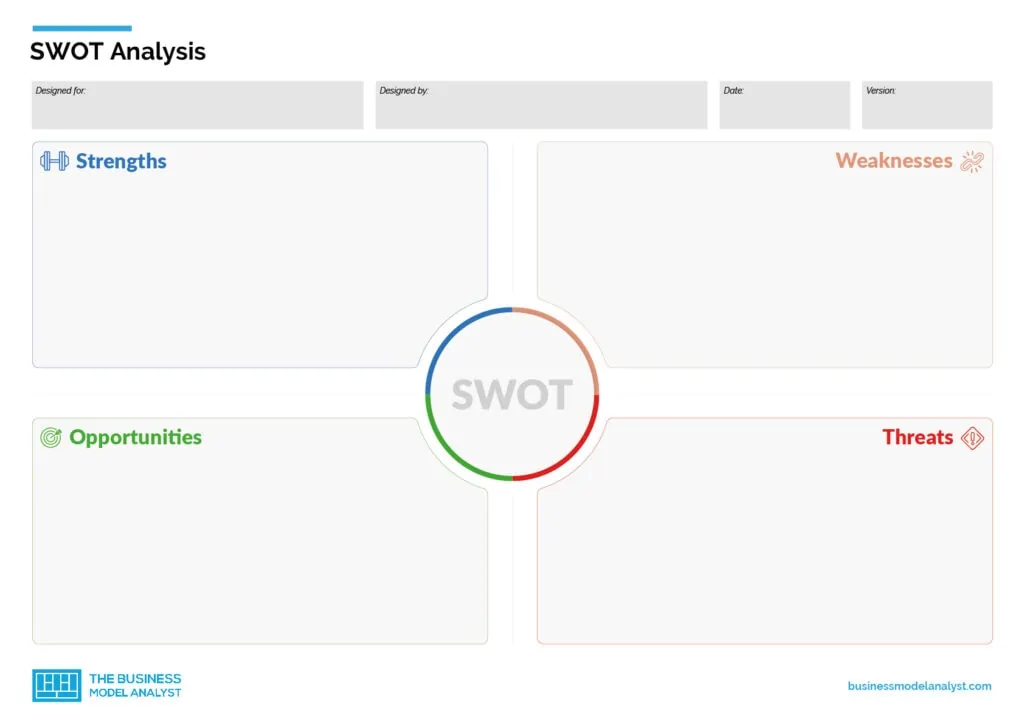
Download FREE!
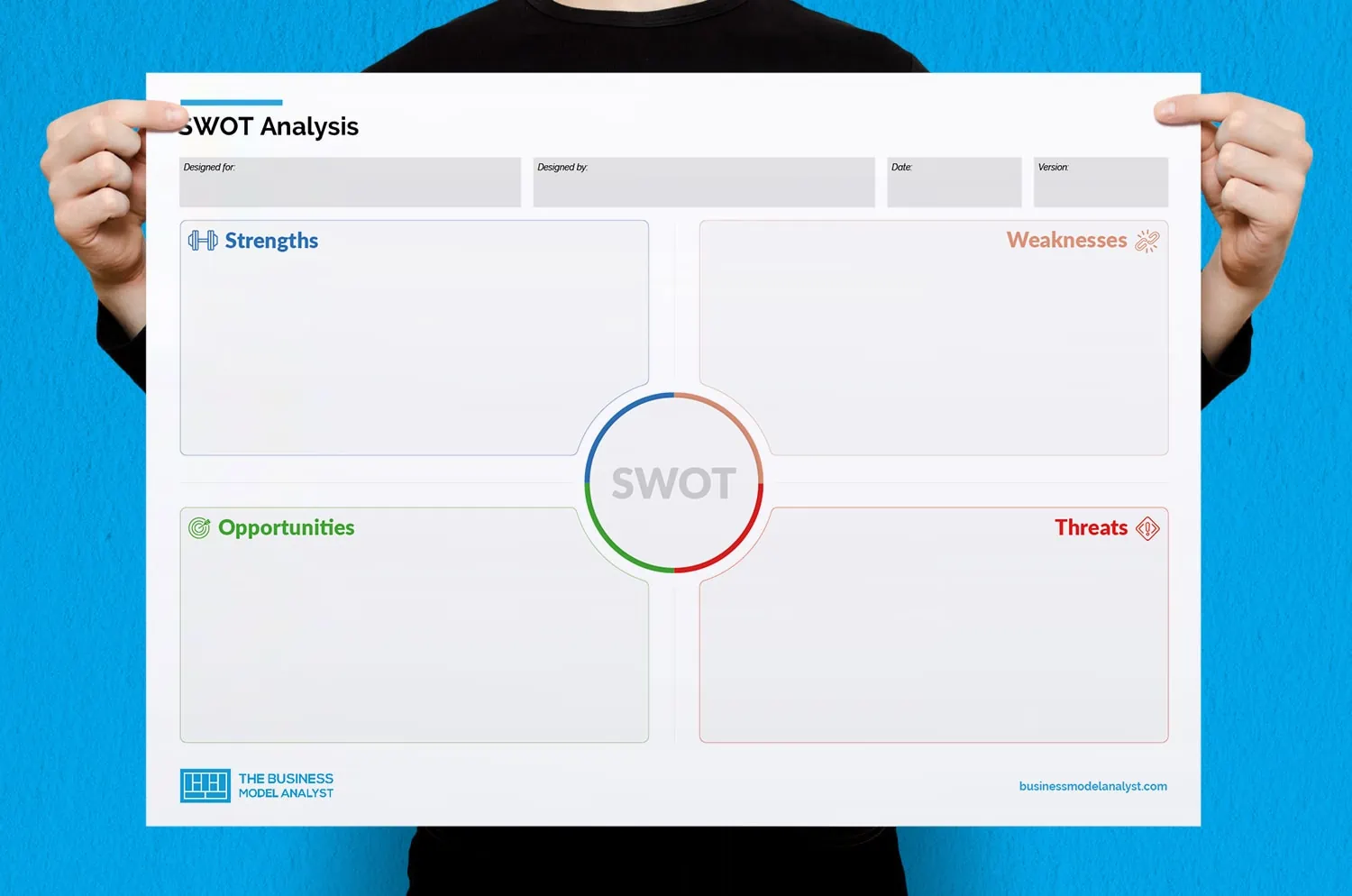
To download SWOT Analysis Template PDF today just enter your email address!
Step 7: Craft Your Strategy
This is not technically a part of the SWOT analysis technique; however, it is important to remember that the entire point of creating this analytic framework was to carry out a strategic management plan. This means that the business will set out a series of plans to meet the objectives which it has previously outlined, as well as create some reliable metrics or milestones which enable it to measure its progress toward achieving these goals.
SWOT Analysis Examples
To better understand how a SWOT analysis is created, let’s take a look at some examples of SWOT analysis. We’ll analyze three examples, the multinational activewear brand Nike , a hypothetical mom-and-pop diner called Joe’s Brooklyn Burgers, and another hypothetical scenario involving a new product rollout.
Large Company SWOT Analysis — Nike SWOT Analysis
From their iconic “swoosh” logo to their equally iconic range of footwear, Nike, Inc. is one of the most easily recognizable activewear brands in the world. While probably best known for its range of iconic footwear, most notably the Air Jordan brand of sneakers, Nike, Inc. is also a leading brand in other sports gear, such as activewear, sports equipment, and wearable fitness tech.
The Nike business model is famous for finding the perfect balance between fashion and functionality when it comes to their products, making them quite popular among both athletes and non-athletes alike. Let’s take a look through this Nike SWOT analysis , which was designed by our platform to figure out how the brand came to dominate the sportswear market.
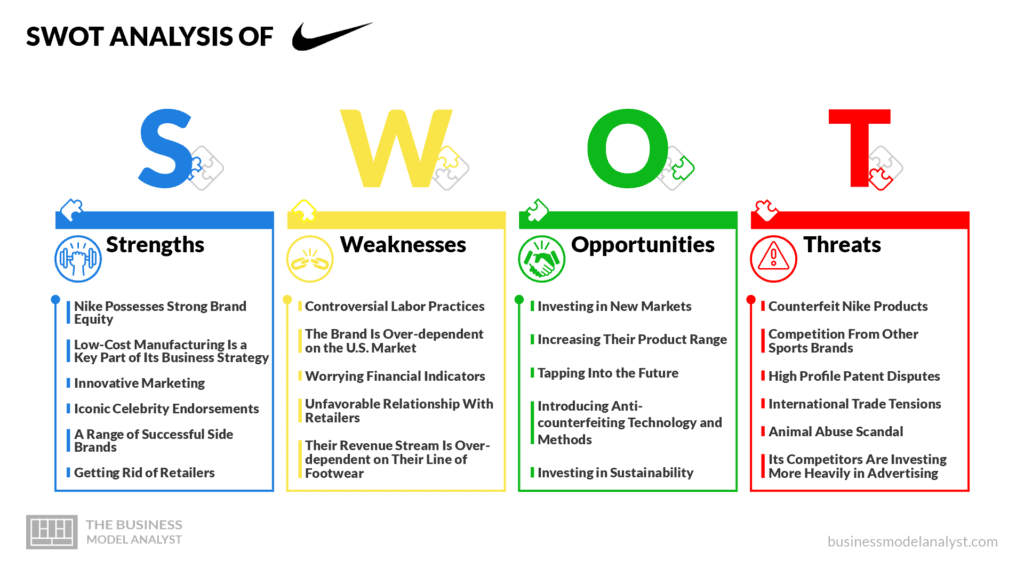
- Solid brand equity: The brand has one of the most recognizable identities in the business world. Also, it commands solid brand equity (the commercial value of the public’s perception of its products or services). This is because the brand has cultivated a reputation associated with innovation, quality, and social justice;
- Low-cost manufacturing is a key part of its business model: Nike has invested heavily in low-cost manufacturing by outsourcing its manufacturing process to countries that have a favorable wage structure and investing in innovative technologies. This keeps costs low and profit margins high;
- Innovative marketing strategies: Through the smart use of celebrity endorsements, iconic marketing campaigns, effective use of social media, and iconic imagery like the Nike “swoosh” logo, the brand has aligned itself with positive associations such as innovation, stylishness, maximum performance, winning, and self-empowerment;
- Increasing direct-to-consumer sales: Nike has increased direct-to-consumer sales by cutting ties with its major retailers and investing in e-commerce. This increases its profit margin, brand visibility, and control over its image;
- Impressive R&D department: The company is well known for outspending its closest competitors in this area. It has introduced some of the most iconic developments in competitive sportswear, making it a favorite for many top athletes.
- Controversial labor practices: Several reports published in the late 1990s indicated that the low-cost manufacturing strategy used by Nike may have involved unethical labor practices such as poor working conditions, long working hours, and abysmal pay;
- The brand is too dependent on its U.S. market: Nike is seen as a global brand, but careful analysis shows a significant portion of its revenue comes from the U.S. market. This leaves the company vulnerable to market shocks or economic downturns within the U.S. market;
- Worrying about financial indicators: While Nike is still by far the most valuable sports apparel company in the world, recent worrying financial trends have been brought to the spotlight. One of them is the steadily increasing long-term debt profile of the company. It is also worrisome that the company’s profit margins have steadily declined over the past few years;
- Unfavorable relationship with retailers: Using third-party retailers exposes the company to some of the disadvantages associated with this strategy, such as lower profit margins, as well as less control over their branding, and the risk of counterfeit merchandise;
- Reduced quality control: One of the disadvantages of outsourcing your manufacturing process is that you have reduced control over the quality of your products. Outsourcing can also increase the risk of the market being flooded with counterfeit Nike products.
Opportunities
- Investing in new markets: Nike still has room to expand its role as a global market by making inroads into new markets, such as increasing their presence in Europe, Africa, and Asian markets outside of China;
- Diversify their product range: Another area the brand could look into is investing in sports technology, such as wearable sports gear like smartwatches and other forms of digital sports technology. They could also invest in promoting their other sports products besides footwear;
- Invest in new technologies: This includes examples such as anti-counterfeiting technology, green energy, and more efficient sportswear technology.
- Counterfeit Nike products: Counterfeit products reduce the trust customers have in brand quality and create a negative brand image. This is especially important for Nike because the brand is one of the most counterfeited in the world, with footwear being one of the most commonly faked products;
- Competition from other brands: Nike is significantly ahead of other sporting wear companies such as Adidas, Reebok, Under Armour, and Puma. However, some of these companies, such as Adidas, command a significant market share and pull in revenue that is indeed threatening Nike’s continued dominance of the industry;
- High-profile patent disputes: As one of the market leaders in terms of research and development, Nike fiercely protects its intellectual property, such as patents. Therefore, it was certainly newsworthy when the company got into a series of legal battles with its nearest competitor Adidas over accusations of patent infringement related to the Nike Flyknit technology;
- International trade tensions: As an international brand, Nike is exposed to the nuances of trade agreements, embargoes, protectionism, as well as trade tensions;
- Its competitors are investing more heavily in advertising: Nike spends more than its closest competitor Adidas on advertising, having spent approximately $3.8 billion on advertising in 2018 (less than 10% of its total revenue), while Adidas spent $3.5 billion (representing roughly 14% of its total revenue) in that same year.
The objective of this SWOT analysis was to identify the competitive advantage of the brand and educate readers on how the corporation came to dominate the world of activewear. This was identified to be its strong brand equity, low-cost manufacturing, heavy investment in innovative technologies, as well as improving direct-to-consumer sales.
Small Business SWOT Analysis — Bob’s Brooklyn Burgers
Next, let’s take a look at a SWOT analysis for a small, independent restaurant called Bob’s Brooklyn Burgers. This will allow us to examine how the SWOT analysis of a small business differs from that of a large multinational corporation.
Our hypothetical business is a small, family-owned diner based in Brooklyn that caters to a number of local customers and offers a unique Brooklyn-themed menu. The business has been operating successfully over several decades but has run into some lean times in recent years. Let’s examine the SWOT analysis of this business to better understand the issues it faces and as well craft a brief outline of how it can reclaim its former glory.
Proximity to customers. One of the advantages of being a locally popular restaurant is that they are closer to their customers, which gives them local dominance as well as an advantage over franchised restaurants that may be located further away.
- They offer a great customer experience: The restaurant offers amazing customer service due to the personalized nature of its services, its familiarity with regular customers as well as its unique branding style, which resonates with locals;
- The restaurant is known for its top-notch cuisine: One advantage the diner enjoys as a small independent restaurant is greater control over its supply chains and, by extension, greater control over the quality of its ingredients and food. This means that the restaurant can offer higher cuisine than fast-food restaurants;
- The establishment has a great reputation: Bob’s Brooklyn Burgers has been a trusted part of the community for over two decades and has built a reputation for itself as a great local destination for top-notch cuisine as well as an enjoyable dining experience. Not only does this help it retain its pool of loyal clientele, but it has also transformed the location into a local hotspot for tourists and NY-themed food enthusiasts;
- Their small size offers them a greater degree of flexibility: Another key advantage enjoyed by the restaurant is the advantage that being a small, independent business offers in terms of flexibility. This allows for quicker decision-making and rapid changes in internal policies to deal with new challenges. It also allows the business to take more risks in the form of pivots and brand adjustments due to a more streamlined decision-making process;
- A strong workplace culture: As we mentioned earlier, Bob’s Brooklyn Burgers is a family-owned establishment. A significant number of employees are either directly related to the owner or close associates, and have worked at the establishment for years. This creates a positive work environment due to their familiarity with each other and experiences working together, which in turn increases efficiency and enhances customer satisfaction.
- Low-profit margin: Despite its popularity and great reputation, due to several factors, including mounting debt, poor financial management, and rising labor costs, the restaurant has been operating on an increasingly thin profit margin. This poses a significant challenge to the growth and continued existence of the business if not properly addressed either through increasing revenue or cutting down costs;
- Lack of professional services: Similar to most small businesses, the diner suffers from a lack of professional expertise in certain areas such as marketing, accounting as well as legal services. Therefore, these services are often carried out by untrained staff, thereby reducing efficiency and driving up costs in terms of both man-hours lost and monetary losses;
- Poor management: Despite the best efforts of its management staff, the diner has been suffering from poor oversight and a range of conflicting internal policies, which have reduced the overall efficiency of the business;
- Lack of professional hiring practices: Bob’s Brooklyn Burgers is a family-owned establishment and thus maintains a rather informal hiring process. While this may create a familiar, friendly, and cozy working environment, it does so at the cost of hiring the best possible staff. This leads to employing personnel who may not be optimally suited for certain roles, as well as makes the process of letting go of staff difficult;
- Higher per unit costs: The business also runs higher per unit costs than larger restaurant franchises that enjoy the advantages of economies of scale as well as bulk purchases. This further drives up operating costs and reduces the profit margins of the business.
- Outsourcing some of its key operations: Bob’s Brooklyn Burgers would do well to outsource several specialized functions within its business operation, such as advertising and marketing, accounting, and legal services. Not only will they enjoy increased efficiency by allowing professionals to handle these tasks, but it also allows both staff and management to focus on tasks for which they are better suited;
- Further expansion and scaling: Even though the business is quite successful locally, there is still much potential for expansion. It can capitalize on its popularity and positive reputation to build similarly themed restaurants and other iconic locations both within and outside the state;
- Diversification: Currently, the restaurant operates using a limited menu. While this is adequate for most local clientele, expanding the menu may attract more customers as well, this allows the restaurant to diversify and keep up with changing customer preferences;
- Expanding into online food delivery: Bob’s Brooklyn Burgers does not currently operate an online food delivery service. Creating such a service will increase its reach, further expanding its customer base and, by extension, revenue;
- Investing in a strong social media presence: Bob’s Brooklyn Burgers has not yet invested in the power of social media as a marketing tool as well as a customer channel which will allow them to reach out to a much broader and more diverse customer base.
- Changing government health regulations: Certain local legislation introduced by the state government has made it harder and more expensive for the business to source certain ingredients. This has driven up costs, further restricted their menu, and reduced their profit margin;
- Increasing competition from other dining establishments: The business has been facing increasing competition from both fast-food franchises and independent restaurants. This is a significant challenge to their local dominance and has eaten into their market share and, by extension, revenue;
- Lack of adequate access to capital: Small businesses such as Bob’s Brooklyn Burgers have a harder time accessing capital than larger franchises and businesses. This makes it harder for them to expand and also puts them in a more difficult situation during times of significant reductions in revenue, such as a global pandemic.
The objective of this SWOT analysis was to determine the issues plaguing the diner and help it design a strategy to improve its current business model. To achieve this, a matching and converting strategy will be used. This means that we will attempt to combine the strengths and opportunities of the business while converting the weaknesses and threats into positive indicators, or at least reducing their negative effects.
First of all, the company can outsource the various professional services listed above in order to enable it to focus on the parts of the business operation where it has a significant advantage over its competitors. This includes providing a top-notch customer experience as well as cooking top-quality meals.
Another option they could look into is utilizing the reach of social media as an avenue to build a strong online food delivery service. The fact that many of their customers are local and live relatively close to the establishment also makes this feasible. This also has the added advantage of diversifying their revenue stream .
Lastly, the company can focus on using its reputation for providing great meals as a focal point for expanding into new territories and new markets.
Product Rollout SWOT Analysis — The Turbo 2000 Product Rollout
Now that we have discussed how to perform a SWOT analysis on both large and small companies, let’s focus on the last example in this article: How to perform a SWOT analysis on a hypothetical product launch.
For this example, we will perform a SWOT analysis on the rollout of a hypothetical high-end gas stove known as the Turbo Burner 2000. This example will highlight the competitive advantage of the product as well as the challenges it may face during its launch.
- The product is coming from a well-trusted brand: One of the advantages enjoyed by the Turbo Burner 2000 is that the product comes from a well-respected company with strong brand equity and a reputation for making top-notch cooking appliances. This will boost consumer confidence and encourage more people to purchase the product;
- It makes use of revolutionary cooking ware technology: The product incorporates revolutionary gas stove technology and has been found to increase thermal efficiency and reduce fuel consumption. This helps cut down costs in the long run, shorten cooking time, reduce emissions, and enhance customer satisfaction with the entire process;
- Targeted branding and marketing: The company has created a niche for itself and is the go-to brand for high-end cooking appliances and equipment. They cater to a range of customers who may require such products, including professional chefs, restaurants, and middle- to upper-class cooking enthusiasts.
Catering to a narrow niche allows them to better target their branding efforts and increase their profit margin by focusing resources on their key market, which reduces their customer acquisition cost. It also creates an impression of exclusivity, which only serves to further drive up the image of the company as a luxury brand;
- Improved product design and ergonomics: The new product has a more ergonomic design than its predecessor and is very user-friendly. It is made from lighter materials, making it more portable as well as compact. There are also more useful functions, such as a sleeker self-lighting feature, color-coded indicator lights, and a more sensitive temperature control;
- Backed by a company in a strong financial position: The parent company of the product is currently enjoying a strong financial position, which helps them to financially support the launch of the new product in terms of marketing and advertising;
- Very successful first model: The first model (the Turbo Burner 1000) was a massive success within the cooking industry and likely encouraged many buyers to upgrade to the newer model.
- The product is quite expensive: The Turbo Burner 2000 is quite costly for a gas stove, and this is likely going to scare off most buyers except professionals and cooking enthusiasts;
- It is seen as a luxury good: Even though gas stoves are used by people of all economic backgrounds, the price of the product, its marketing strategy, as well as the reputation of its parent brand has given it the image of a luxury product. This may alienate some buyers from utilizing the product, as well as runs the risk of creating a negative association with the brand;
- It is marketed to a narrow niche: While there are several advantages that come with targeting your product at a narrow portion of the market, there are also some drawbacks as well. First of all, it reduces your reach and may alienate a range of potential customers, leading to less actualized revenue. It also increases your vulnerability to rapid changes in market conditions and consumer sentiment, as your income is significantly less diversified;
- Costly R&D and marketing: The Turbo Burner 2000 is a top-notch product and required significant investment in R&D to design. Also, although the company caters to a much narrower niche than most competitors, its Customer Acquisition Costs are much higher.
- Expand its market share by offering cheaper versions: The brand could seek to diversify its business model by offering a range of cheaper alternatives to the standard model. This opens up the business to new customers and by extension increases its potential revenue. It also reduces their vulnerability to sudden shifts in market sentiment;
- Focusing on further innovation: The parent brand has a strong reputation for being an innovative powerhouse in the industry and can capitalize on the strong R&D department it has built to create more innovative technologies and improve on existing designs. This will help keep it a step ahead of its competitors and also increase the reputation of the brand as an innovator within the industry;
- Investing in sustainability: The fossil fuel industry has been under pressure in recent years and, by extension, materials and equipment are driven by fossil fuels. Investing in technologies and technologies that increase the eco-friendliness of the product is a great way to boost positive consumer associations with the brand;
- Increased supply chain efficiencies: By investing in improving the efficiency of its supply chain, the company can further drive down the cost of individual units of the product, increasing sales and also improving its profit margin as well.
- Supply chain disruptions: Significant disruptions to the supply chain of the product may lead to a wide variety of issues such as increased cost per unit as well as reduced production capacity. Overall, this may negatively affect the price or availability of the product and by extension its introduction into the market;
- Changing consumer sentiment: With more consumer interest in climate change and sustainable technologies, the fossil fuel industry and other industries which are dependent on it have attracted much criticism. For example, there has been increasing concern among consumers concerning the long-term health effects of cooking gas and its links to a range of chronic illnesses;
- Changing macroeconomics: Rapid changes in macroeconomics such as recessions and rapid rises in inflation weaken the purchasing power of buyers. This may affect the ability of a lot of individuals to purchase consumer goods such as high-end gas stoves;
- The success of the initial rollout. The widespread success of the first model may discourage buyers from upgrading to the newer product, even with the improved specifications.
Performing a SWOT analysis may be one of the most important activities that any business can carry out within its lifetime. Whether this is done regularly or just as a one-time evaluation, understanding how to get the best out of the technique is key to fully utilizing the benefits and understanding the limitations of the technique.
Daniel Pereira
Related posts.
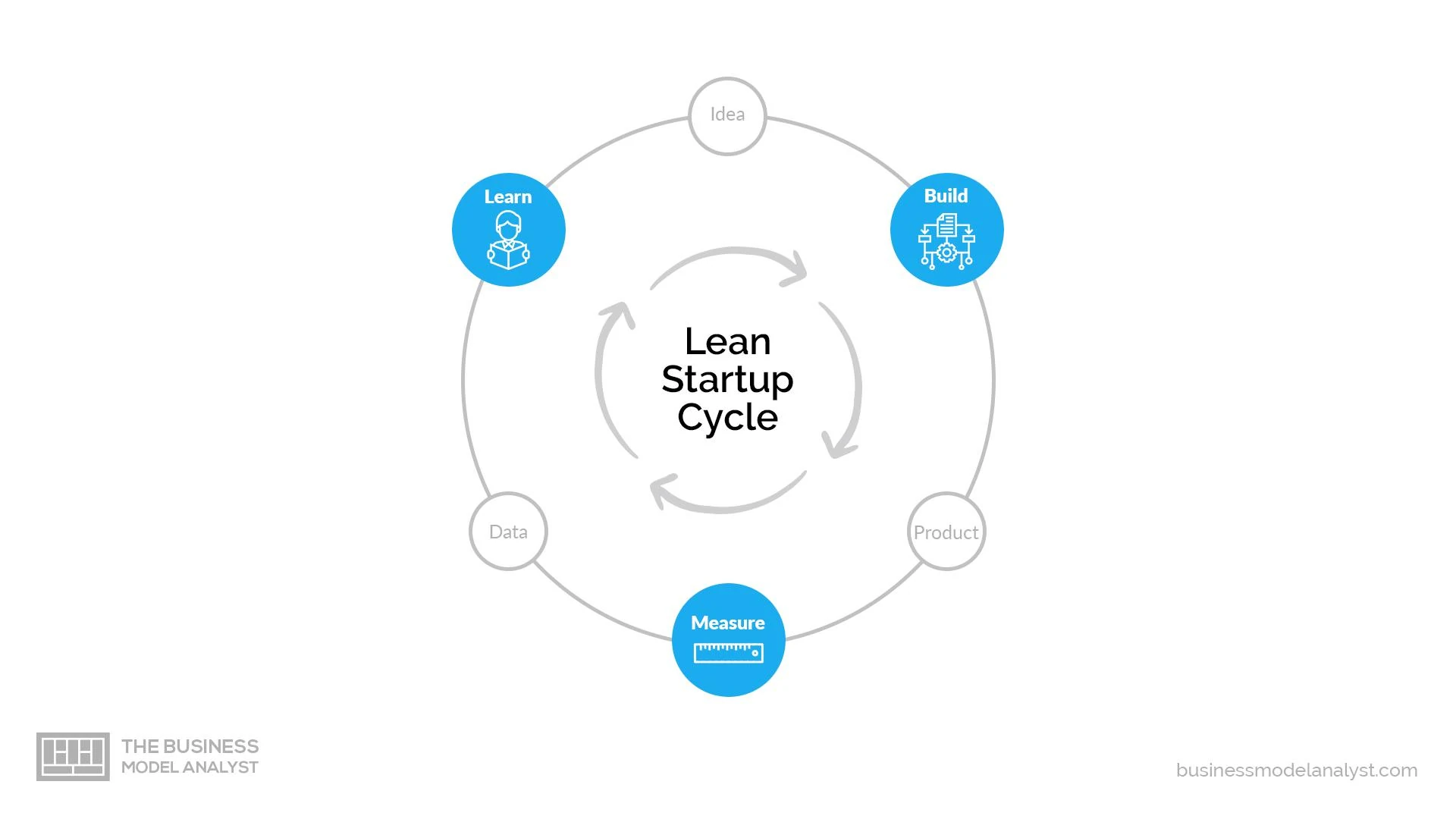
What is Lean Startup?
The Lean Startup core idea is to avoid waste of time and resources when developing [...]
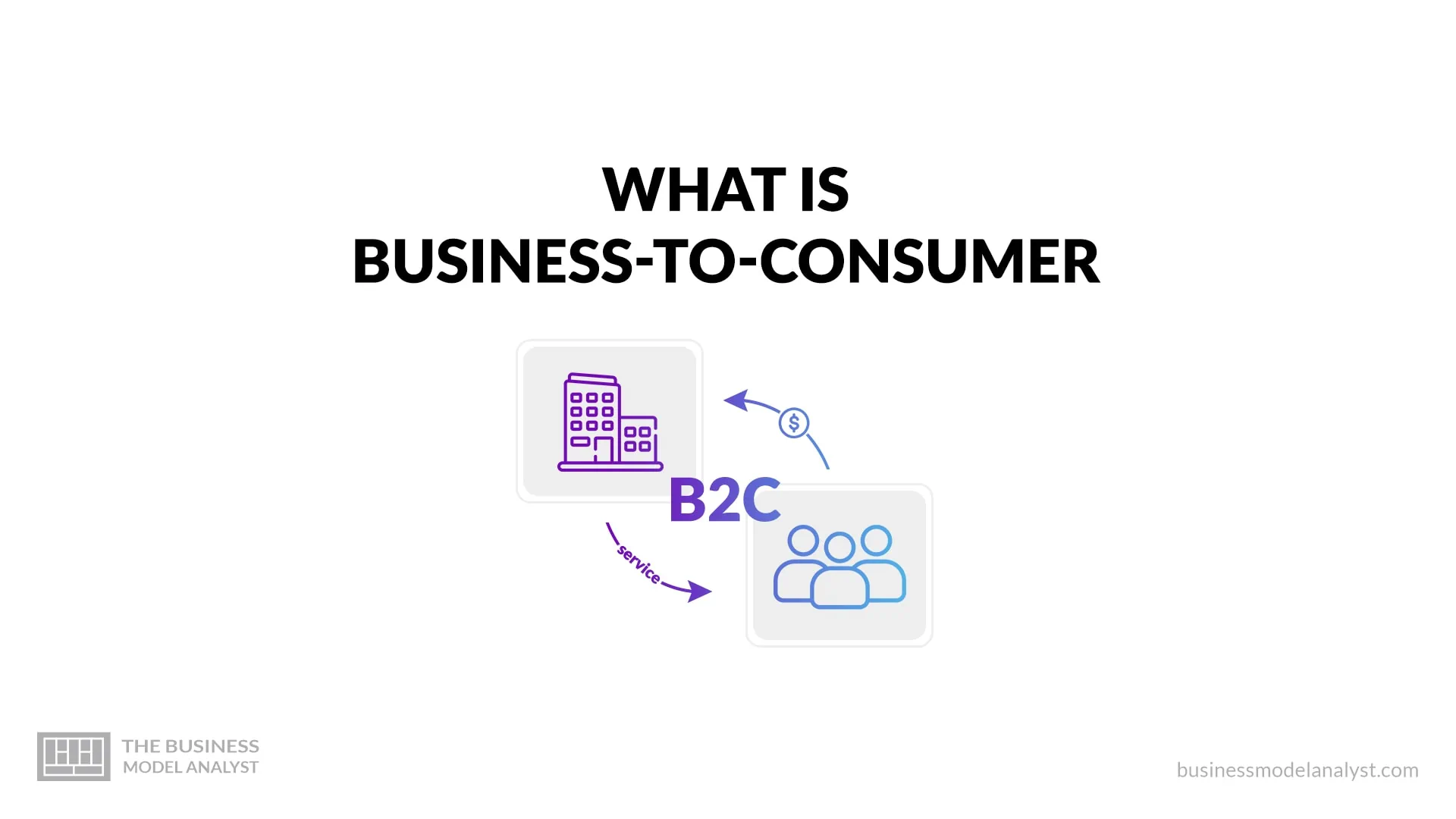
What Is Business-to-Consumer (B2C)? Types and Examples
Business-to-Consumer (B2C) refers to the transactions between a business and individual consumers. In other words, [...]

Network Effects
Some of the greatest current brands, such as Facebook and Amazon have their businesses built [...]

Revolutionize Your Startup Journey with ChatGPT: An Innovative Online Course
In a world where the boundaries between technology and business are becoming increasingly blurred, artificial [...]

Key Partners
The penultimate component – Key Partners – deals with the network of partners that put [...]

Business Model Generation: the book
Let’s get straight to the point: it is fair to say that the book Business [...]

Customer Relationship
The Customer Relationship block of a Business Model is intrinsically dependent on the first block [...]
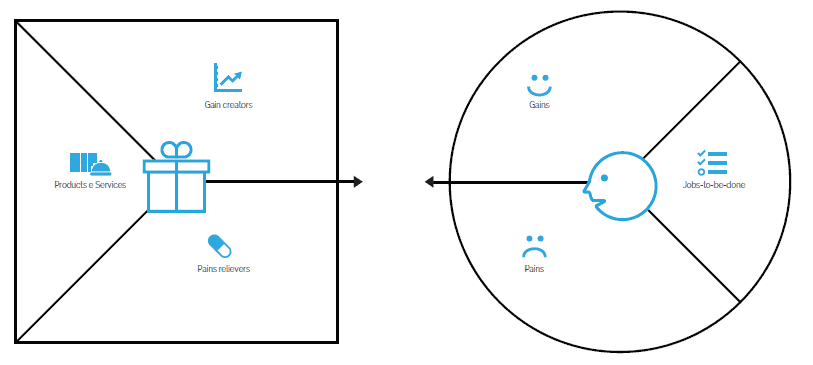
What is the Value Proposition Canvas?
Value Proposition Canvas is a business model tool that helps you make sure that a [...]
RECEIVE OUR UPDATES
Username or email address *
Password *
Remember me Log in
Lost your password?
What Is a SWOT Analysis?
SWOT analysis stands for strengths, weaknesses, opportunities and threats. This exercise helps teams develop strategic plans for innovation and investment.
A SWOT (strengths, weaknesses, opportunities, threats) analysis is a visual framework used for strategic planning across all types of businesses and organizations. SWOT analyses are made up of four components that will help you determine the output of your team’s analysis.
What Does SWOT Analysis Stand For?
Opportunities, how do i do a swot analysis.
A SWOT analysis is a qualitative assessment of a company’s SWOT components. Individuals responsible for the assessment fill out a visual template similar to the figure above, which is usually laid out in a two-by-two matrix. This template helps visualize all the SWOT elements together in their entirety.
To understand in more detail the elements of this template, let’s dive into each component individually.
More From Built In Experts How Competitive Analysis Helps You Shine Over Your Rivals
What Are the 4 Components of a SWOT Analysis?
Your strengths are organizational features that provide a competitive and strategic advantage relative to the market and competition.
Weaknesses
Your weaknesses include organizational features that are lacking relative to market competition, or that hinder the organization’s overall effectiveness to compete, grow, and strive for optimal business performance.
These are favorable market conditions or external developments that represent an opportunity for unlocking or improving the organization’s competitive positioning and business performance. Opportunities can be related to present market conditions, but can also be forward-looking.
These are unfavorable market conditions or external developments that pose a risk to the organization’s performance or the entire viability of the current market. Threats can be related to present market conditions, but can also be forward-looking. (e.g. near-term competitive threats or geopolitical risks would be good examples to feature in this bucket)
- Strengths and weaknesses are factors that are owned (and thus controlled) by the organization. As a result, the organization and its team can directly influence strengths and weaknesses.
- Opportunities and threats are factors that cannot be controlled by the organization. For example, a near-term innovation trend or advantageous legal ruling that may come into play are considered opportunities, whereas near-term competitive innovation or geopolitical risks fall within the threats bucket. In either instance, your organization may prepare for these events, but it cannot control them.
During the process of filling in this template, you’ll consider all four elements individually. Once you complete the template, through brainstorming sessions and workshops, you can start putting together an actionable plan to capitalize on your strengths and opportunities while countering your weaknesses and threats.
More From Edoardo Romani DataCamp: What I Learned After 44 Courses and 308 Hours
SWOT Analysis Example
Let’s take, for example, a smartphone-producing company in the technology industry. Your example SWOT table may include the following.
Strengths :
- Strong brand positioning
- Loyal customer base
- High barriers to entry for the competition due to recent patent filings
Weaknesses:
- Recently departed CEO who led the company for the previous 15 years
- Production bottlenecks in key geographical regions
- Leaked PR documents
Opportunities:
- Customer trends indicating a shift towards higher-end smartphones in emerging markets
- Weakened competition due to a key competitor recently filing for bankruptcy
- Increased regulatory scrutiny
- Global chip shortage
As a result and potential plan of action, the company in question may decide to focus on mitigating the risks caused by its weaknesses (for example by increasing production in key regions close to the ones suffering bottlenecks in addition to selecting an experienced interim CEO as soon as possible) while seizing market opportunities that may not come about again (i.e. gaining market share in the short term by exploiting the competitor’s bankruptcy).
Overall, resource allocation should flow to:
- Seizing market opportunities
- Developing mitigation plans for market threats and investing in limiting potential damage or performance slowdowns caused by internal weaknesses
Why Use a SWOT Analysis?
The results of a SWOT analysis inform your company’s strategic plan and help you make decisions about how to allocate future resources. As a result of a SWOT analysis your team might decide on the following:
- investment/divestments related to a given product line
- international market entry or market expansions
- changes to the company’s position relative to its competition (based on factors such as price, target customers and barriers to entry among others)
- adjustments to external macroeconomic trends (raise in interest rates) or market-related dynamics (global supply chain constraints)
SWOT Analysis Advantages and Disadvantages
The SWOT analysis as a framework for strategic planning has received its fair share of critique and scrutiny. Let’s review some of the pros and cons.
SWOT Analysis Advantages
- 10,000-Foot View : A SWOT allows you to consider multiple factors that you might not normally associate together all at once (departing CEO and macro-trends, for example). This process can invite management to identify creative solutions to company issues that may have previously been hard to identify; having this combination of different sources of data, from internal balance-sheet metrics to market data points to press releases may enable your organization to find more comprehensive and representative patterns.
- Cross-Team Collaboration : SWOT analyses create space for the representation of multiple viewpoints within the organization. The exercise invites people from different departments of the organization to contribute and collaborate across departments, thereby enriching the overall quality of the SWOT analysis and enabling better communication across company silos.
- Simplicity: A SWOT is a simple framework that allows you to consider and break down complex problems that are usually considered and tackled separately but without a link to the bigger picture offered by a SWOT exercise.
- Simultaneous Consideration of Internal and External Factors : A SWOT allows us to relate internal factors with external factors, which is important since these two sides are usually considered separately from one another and only more broadly considered at the executive level. For this reason, conducting a SWOT exercise at the department level allows internal teams to understand how external forces influence and relate to their day-to-day operations.
More on Group and Organizational Analyses 7 Ways to Use Mind Mapping in Your Work
SWOT Analysis Disadvantages
- Groupthink and Bias: The generation of a SWOT chart is heavily influenced by the individuals tasked with the exercise. If the group isn’t diverse or made up of representatives from around the organization, the analysis will result in biased outcomes and lopsided strategies.
- Short Shelf Life : A SWOT analysis is a spot exercise, which means we typically perform them as a one-off planning effort. In fast-changing markets, its results (and, thus, its overall relevance) can go out of date quickly.
- Research shows a weak link between the SWOT exercise and actual strategic decision-making and organization follow-through. As a result, we’ve seen alternative frameworks emerge, most notably Porter's five forces analysis .
Recent Operations Articles

How to Do a SWOT Analysis for Better Strategic Planning

6 min. read
Updated October 27, 2023

Conducting a SWOT analysis of your business is a lot more fun than it sounds. It won’t take much time, and doing it forces you to think about your business in a whole new way.
The point of a SWOT analysis is to help you develop a strong business strategy by making sure you’ve considered all of your business’s strengths and weaknesses, as well as the opportunities and threats it faces in the marketplace.

- What is a SWOT analysis?
S.W.O.T. is an acronym that stands for Strengths, Weaknesses, Opportunities, and Threats. A SWOT analysis is an organized list of your business’s greatest strengths, weaknesses, opportunities, and threats.
Strengths and weaknesses are internal to the company (think: reputation, patents, location). You can change them over time but not without some work. Opportunities and threats are external (think: suppliers, competitors, prices)—they are out there in the market, happening whether you like it or not. You can’t change them.
Existing businesses can use a SWOT analysis, at any time, to assess a changing environment and respond proactively. In fact, I recommend conducting a strategy review meeting at least once a year that begins with a SWOT analysis.
New businesses should use a SWOT analysis as a part of their planning process. There is no “one size fits all” plan for your business, and thinking about your new business in terms of its unique “SWOTs” will put you on the right track right away, and save you from a lot of headaches later on.
Looking to get started right away? Download our free SWOT Analysis template.
In this article, I will cover the following:
- How to conduct a SWOT analysis
- Questions to ask during a SWOT analysis
- Example of a SWOT analysis
- TOWS analysis: Developing strategies for your SWOT analysis
To get the most complete, objective results, a SWOT analysis is best conducted by a group of people with different perspectives and stakes in your company. Management, sales, customer service, and even customers can all contribute valid insight. Moreover, the SWOT analysis process is an opportunity to bring your team together and encourage their participation in and adherence to your company’s resulting strategy.
A SWOT analysis is typically conducted using a four-square SWOT analysis template, but you could also just make lists for each category. Use the method that makes it easiest for you to organize and understand the results.
I recommend holding a brainstorming session to identify the factors in each of the four categories. Alternatively, you could ask team members to individually complete our free SWOT analysis template, and then meet to discuss and compile the results. As you work through each category, don’t be too concerned about elaborating at first; bullet points may be the best way to begin. Just capture the factors you believe are relevant in each of the four areas.
Once you are finished brainstorming, create a final, prioritized version of your SWOT analysis, listing the factors in each category in order of highest priority at the top to lowest priority at the bottom.
Brought to you by
Create a professional business plan
Using ai and step-by-step instructions.
Secure funding
Validate ideas
Build a strategy
I’ve compiled some questions below to help you develop each section of your SWOT analysis. There are certainly other questions you could ask; these are just meant to get you started.
Strengths (internal, positive factors)
Strengths describe the positive attributes, tangible and intangible, internal to your organization. They are within your control.
- What do you do well?
- Positive attributes of people , such as knowledge, background, education, credentials, network, reputation, or skills.
- Tangible assets of the company , such as capital, credit, existing customers or distribution channels, patents, or technology.
- What advantages do you have over your competition?
- Do you have strong research and development capabilities? Manufacturing facilities?
- What other positive aspects, internal to your business, add value or offer you a competitive advantage?
Weaknesses (internal, negative factors)
Weaknesses are aspects of your business that detract from the value you offer or place you at a competitive disadvantage. You need to enhance these areas in order to compete with your best competitor.
- What factors that are within your control detract from your ability to obtain or maintain a competitive edge?
- What areas need improvement to accomplish your objectives or compete with your strongest competitor?
- What does your business lack (for example, expertise or access to skills or technology)?
- Does your business have limited resources?
- Is your business in a poor location?
Opportunities (external, positive factors)
Opportunities are external attractive factors that represent reasons your business is likely to prosper.
- What opportunities exist in your market or the environment that you can benefit from?
- Is the perception of your business positive?
- Has there been recent market growth or have there been other changes in the market the create an opportunity?
- Is the opportunity ongoing, or is there just a window for it? In other words, how critical is your timing?
Threats (external, negative factors)
Threats include external factors beyond your control that could place your strategy, or the business itself, at risk. You have no control over these, but you may benefit by having contingency plans to address them if they should occur.
- Who are your existing or potential competitors?
- What factors beyond your control could place your business at risk?
- Are there challenges created by an unfavorable trend or development that may lead to deteriorating revenues or profits?
- What situations might threaten your marketing efforts?
- Has there been a significant change in supplier prices or the availability of raw materials?
- What about shifts in consumer behavior, the economy, or government regulations that could reduce your sales?
- Has a new product or technology been introduced that makes your products, equipment, or services obsolete?
- Examples of a SWOT analysis
For illustration, here’s a brief SWOT example from a hypothetical, medium-sized computer store in the United States:

See our SWOT analysis examples article for in-depth examples of SWOT analyses for several different industries and business types or download our free SWOT analysis template .
- TOWS analysis: Developing strategies from your SWOT analysis
Once you have identified and prioritized your SWOT results, you can use them to develop short-term and long-term strategies for your business. After all, the true value of this exercise is in using the results to maximize the positive influences on your business and minimize the negative ones.
But how do you turn your SWOT results into strategies? One way to do this is to consider how your company’s strengths, weaknesses, opportunities, and threats overlap with each other. This is sometimes called a TOWS analysis.
For example, look at the strengths you identified, and then come up with ways to use those strengths to maximize the opportunities (these are strength-opportunity strategies). Then, look at how those same strengths can be used to minimize the threats you identified (these are strength-threats strategies).
Continuing this process, use the opportunities you identified to develop strategies that will minimize the weaknesses (weakness-opportunity strategies) or avoid the threats (weakness-threats strategies).
The following table might help you organize the strategies in each area:

Once you’ve developed strategies and included them in your strategic plan, be sure to schedule regular review meetings. Use these meetings to talk about why the results of your strategies are different from what you’d planned (because they always will be) and decide what your team will do going forward.
Tim Berry is the founder and chairman of Palo Alto Software , a co-founder of Borland International, and a recognized expert in business planning. He has an MBA from Stanford and degrees with honors from the University of Oregon and the University of Notre Dame. Today, Tim dedicates most of his time to blogging, teaching and evangelizing for business planning.

Table of Contents
Related Articles

3 Min. Read
How to Write an Effective Marketing Plan

9 Min. Read
How to Create a Sales Plan for Your Business

4 Min. Read
How to Develop a Positioning Statement for Your Business

8 Min. Read
How to Create A Digital Marketing Plan and Strategy
The Bplans Newsletter
The Bplans Weekly
Subscribe now for weekly advice and free downloadable resources to help start and grow your business.
We care about your privacy. See our privacy policy .

The quickest way to turn a business idea into a business plan
Fill-in-the-blanks and automatic financials make it easy.
No thanks, I prefer writing 40-page documents.

Discover the world’s #1 plan building software
14 Free SWOT Analysis Templates
By Joe Weller | July 25, 2016
- Share on Facebook
- Share on LinkedIn
Link copied
In this article, we’ve compiled the most comprehensive list of downloadable SWOT analysis templates offered in Excel, Word, and Powerpoint formats.
Included on this page, you’ll find a basic SWOT matrix Excel template , SWOT competitor analysis template , SWOT analysis strategy template , and more for any given business, project, or personal objective.
We've researched the top SWOT analysis templates and provided them here for you in Excel, Powerpoint, and Word formats. Additionally, we’ve included SWOT analysis templates in Smartsheet, a collaborative, real-time work execution platform that empowers you to better plan, manage, and report on project details.
SWOT Analysis Templates for Excel
Basic swot matrix excel template.
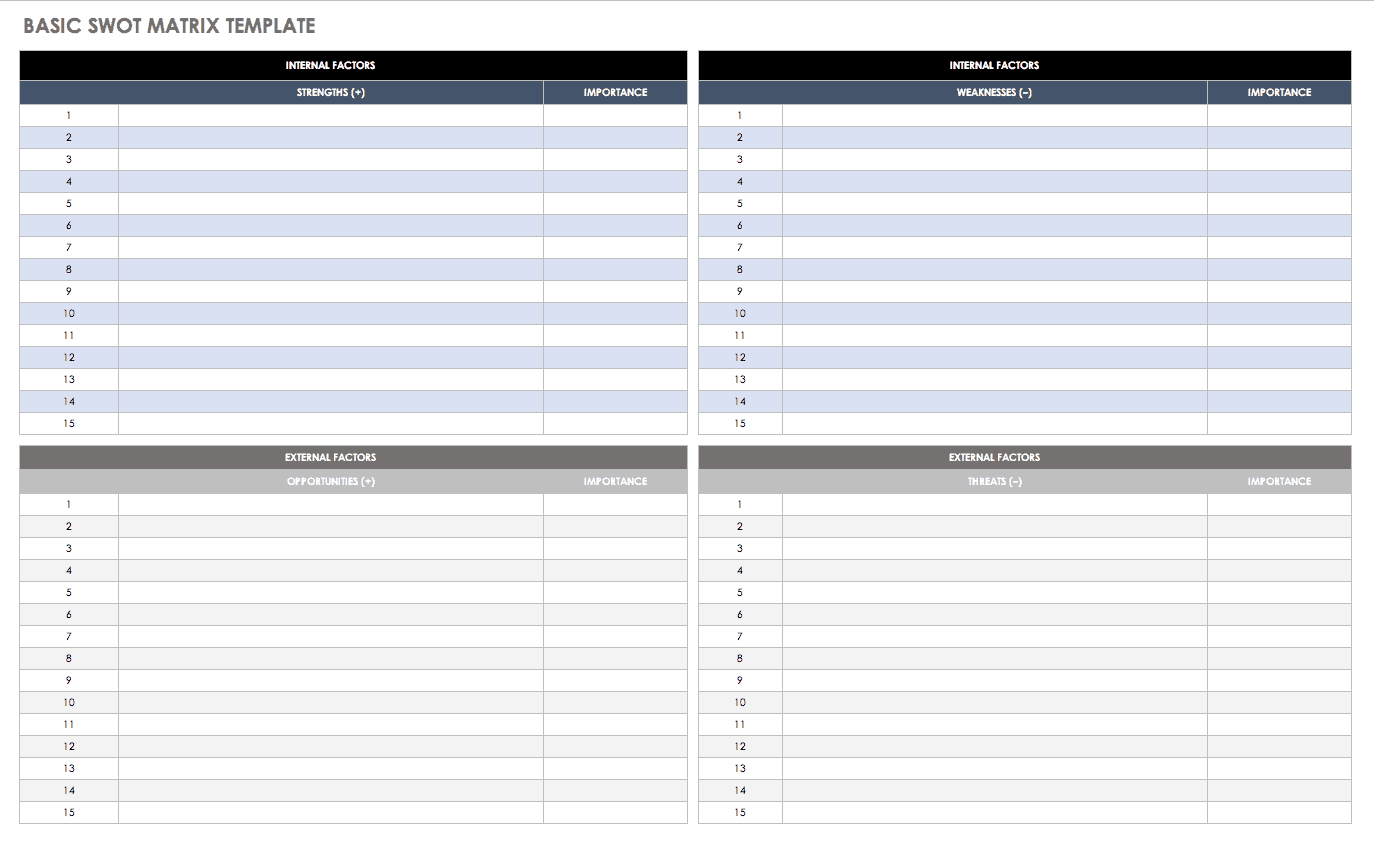
Download Basic SWOT Matrix Template
Excel | Smartsheet
This SWOT matrix template provides the basic 2x2 layout for an easy-to-read view of your analysis. It also includes a column for measuring the significance of each item in your SWOT categories. This is important for understanding how the different elements in your analysis measure up to each other and which areas require the most attention. Take advantage of the fact that this is an Excel template by using additional worksheets for supporting data or other analyses. You get the simplicity of a SWOT matrix with the functionality of Excel.
SWOT Competitor Analysis Template
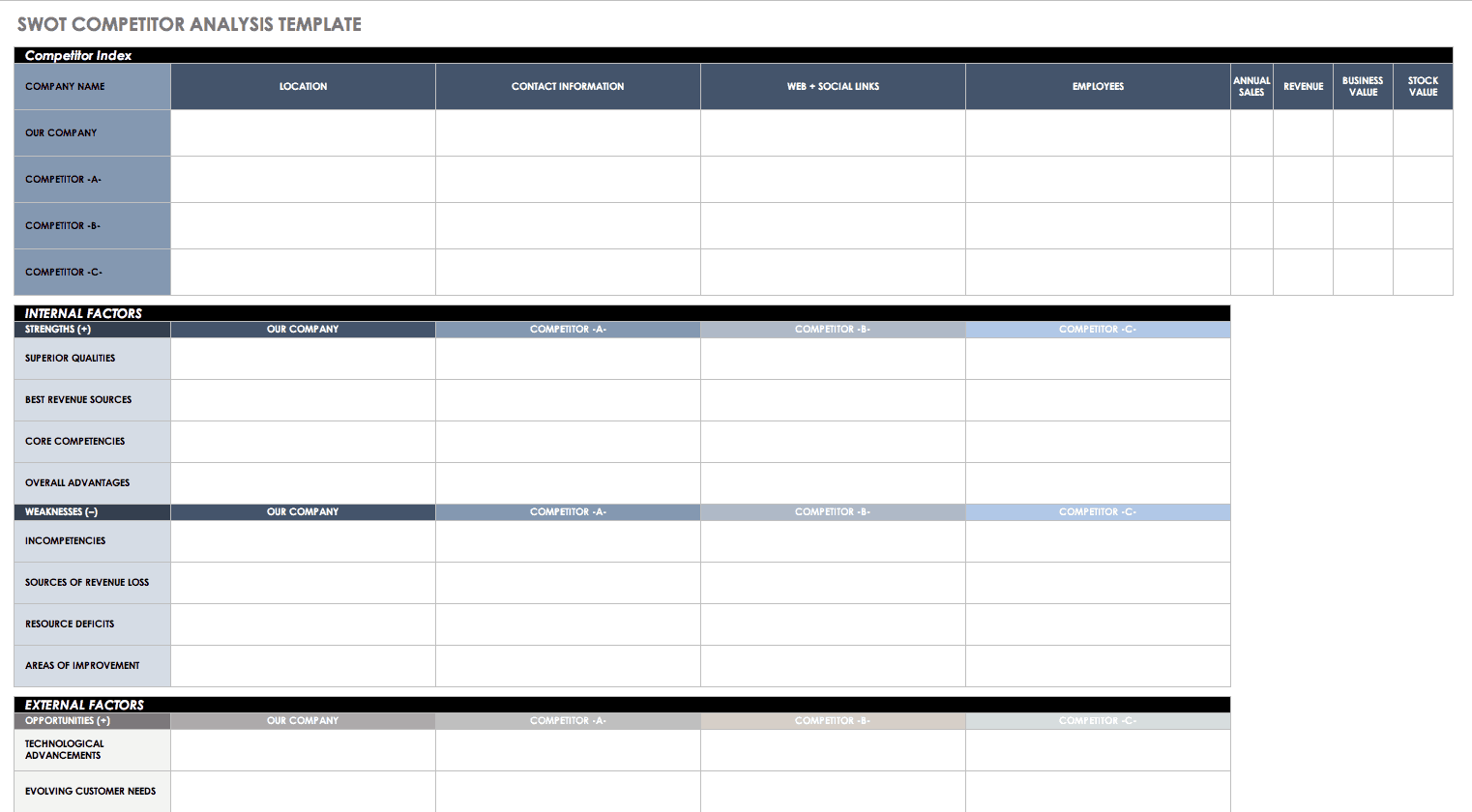
Download SWOT Competitor Analysis Template
This template applies the SWOT process to a competitor analysis, allowing you to compare your business with other companies. Rather than the matrix layout, this template utilizes a simple spreadsheet format with columns for each competitor. This allows you to create a detailed analysis of the competition with the structure of the SWOT framework. See how the strengths and weaknesses of your business measure up, identify which competitors represent threats, see what opportunities others might be missing, and much more.
SWOT Analysis Arrows Template
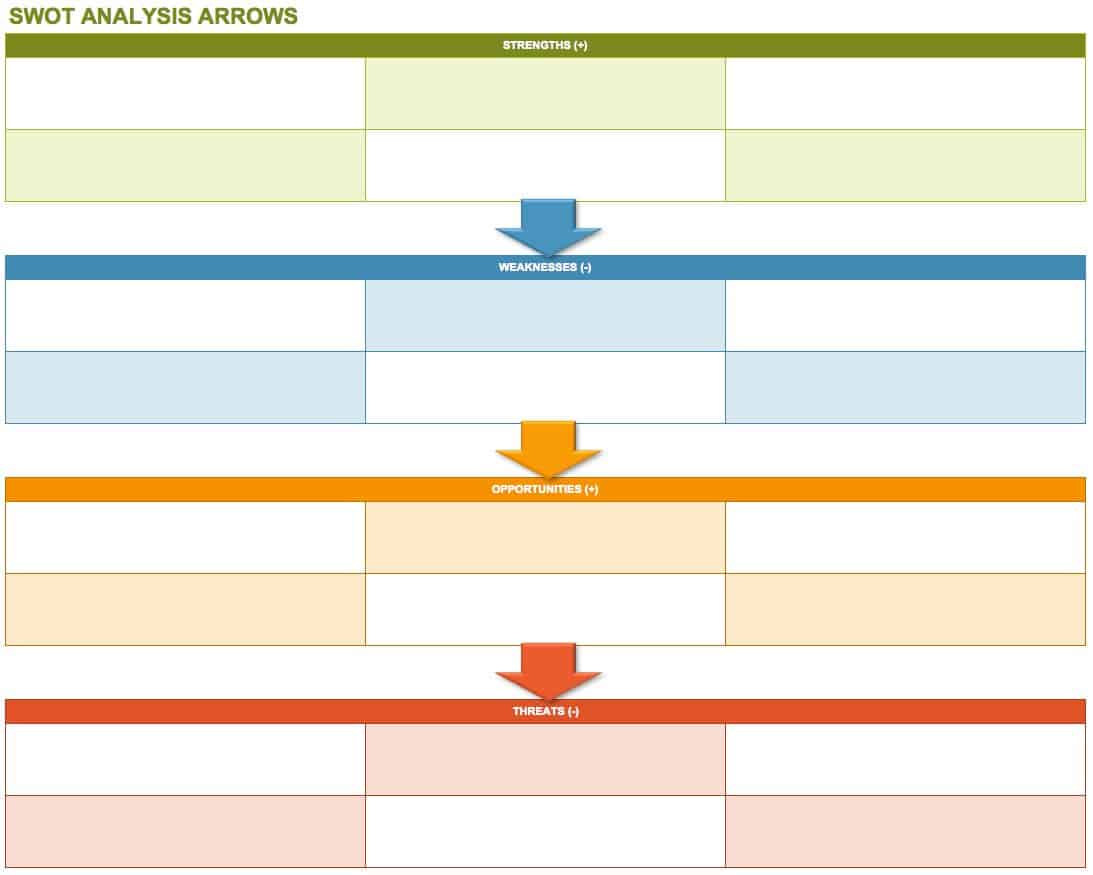
Download SWOT Analysis Arrows Template
If you want to use Excel but also want to create an eye-catching SWOT analysis for a presentation, this template offers a bold layout with arrows for each SWOT category. Just add text to each arrow and you’ll have a colorful, graphical display. The template is preformatted for you, so it’s easy to use, and the colors can be adjusted as desired.
SWOT Analysis Strategy Template
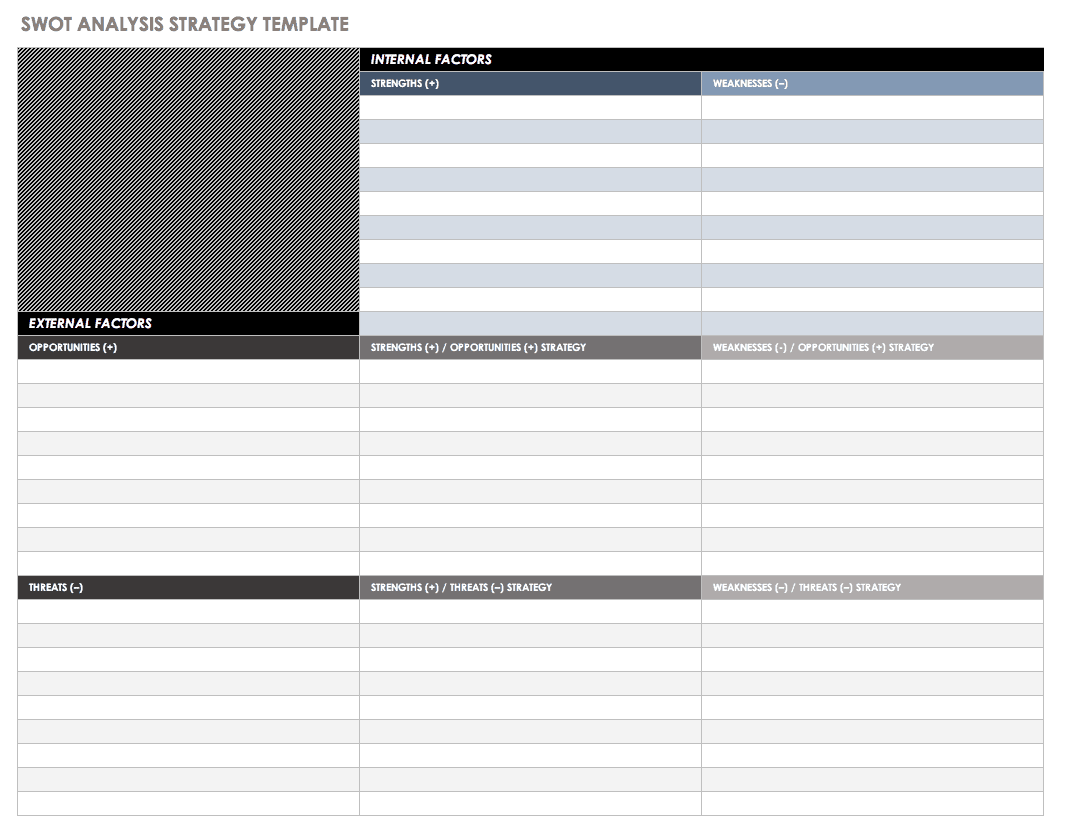
Download SWOT Analysis Strategy Template
This SWOT analysis template offers a slightly different layout from the traditional 2x2 matrix, with sections included for strategizing. This lets you view the relationships between internal and external factors along with strategies for addressing different elements. If you want to emphasize action items alongside the results of your SWOT analysis and within a spreadsheet format, this template offers a solution.
SWOT Analysis PowerPoint Templates
Simple swot matrix ppt template.
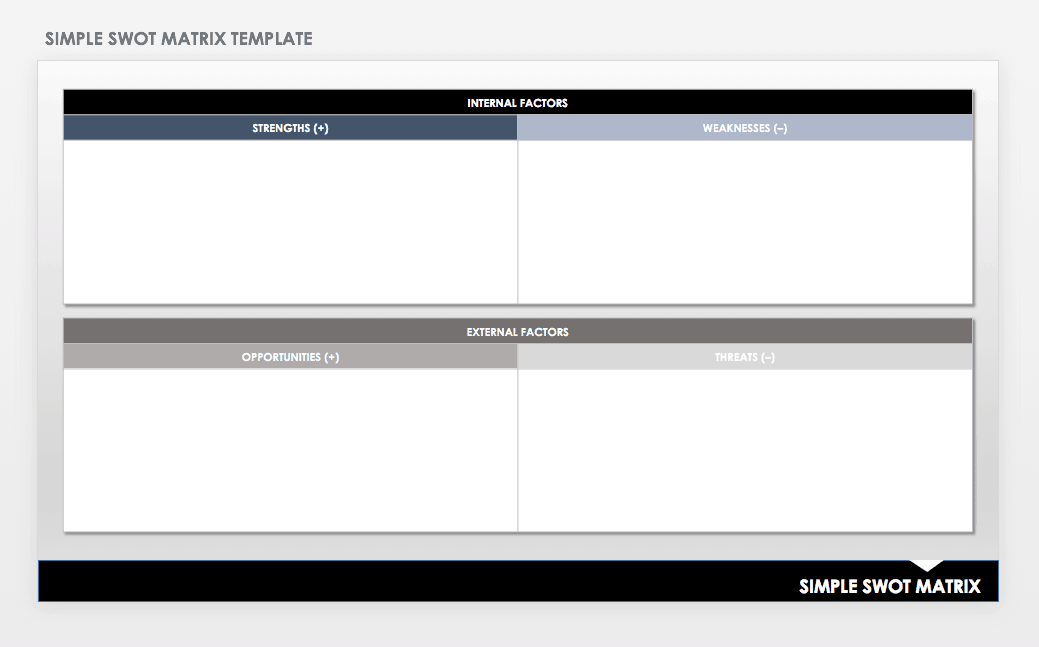
Download Simple SWOT Matrix Template
PowerPoint | Smartsheet
This SWOT PowerPoint template has a straightforward matrix design with bright colors for readability and visual interest. The simple matrix format makes it easy to see the correlations between the internal and external factors so you can identify the risks quickly. This template works well for PPT presentations, because it’s attention grabbing but also looks professional.
3D SWOT Analysis Template
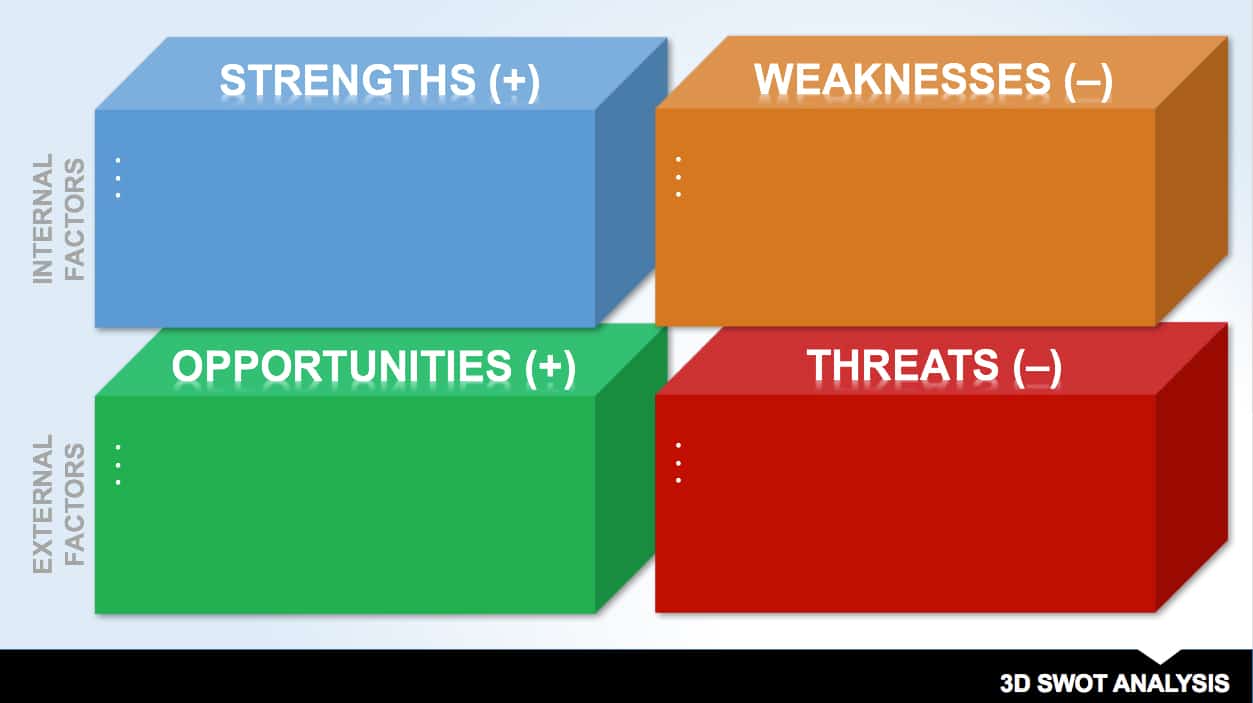
Download 3D SWOT Analysis Template
With this template you get the 2x2 matrix layout in 3D perspective, creating a PPT slide that is creative without being distracting. Adjust the colors for a different look, or use the template as is. Simply add your text for each SWOT category and you’re ready to go.
Colorful Leaves SWOT Analysis Template
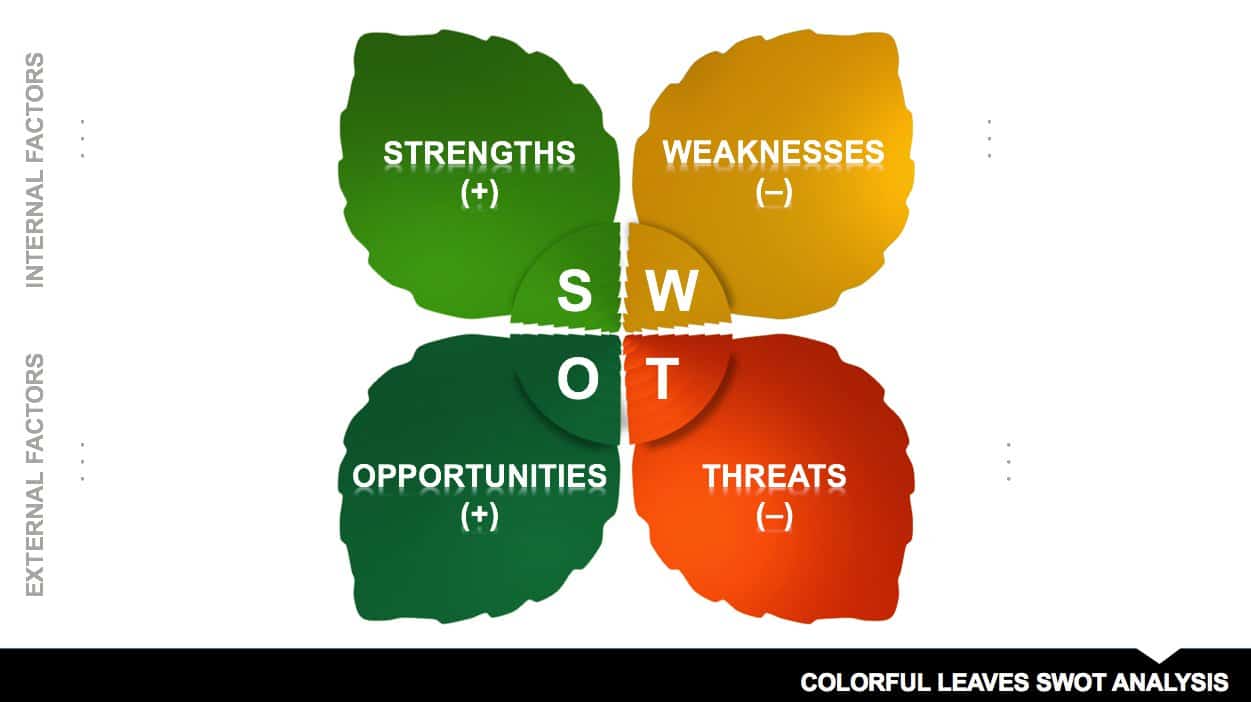
Download Colorful Leaves SWOT Analysis Template
Take your PowerPoint presentation to the next level with this SWOT analysis template. Colorful leaf shapes represent the four SWOT categories and point to your text, which can be added in each corner. The strong visual aspect of this template helps keep viewers engaged, and also makes your job a little more fun.
SWOT Puzzle Template

Download SWOT Puzzle Template
Doing a SWOT analysis can be a little like piecing together a puzzle. How do strengths and opportunities fit together? How do strengths and weaknesses cancel each other out? This PPT template offers a puzzle design with plenty of room for text. Whether you’re doing a marketing SWOT analysis, evaluating operations, or planning a new project, use this template to create a distinctive PowerPoint slide.
Diamond SWOT Analysis Template
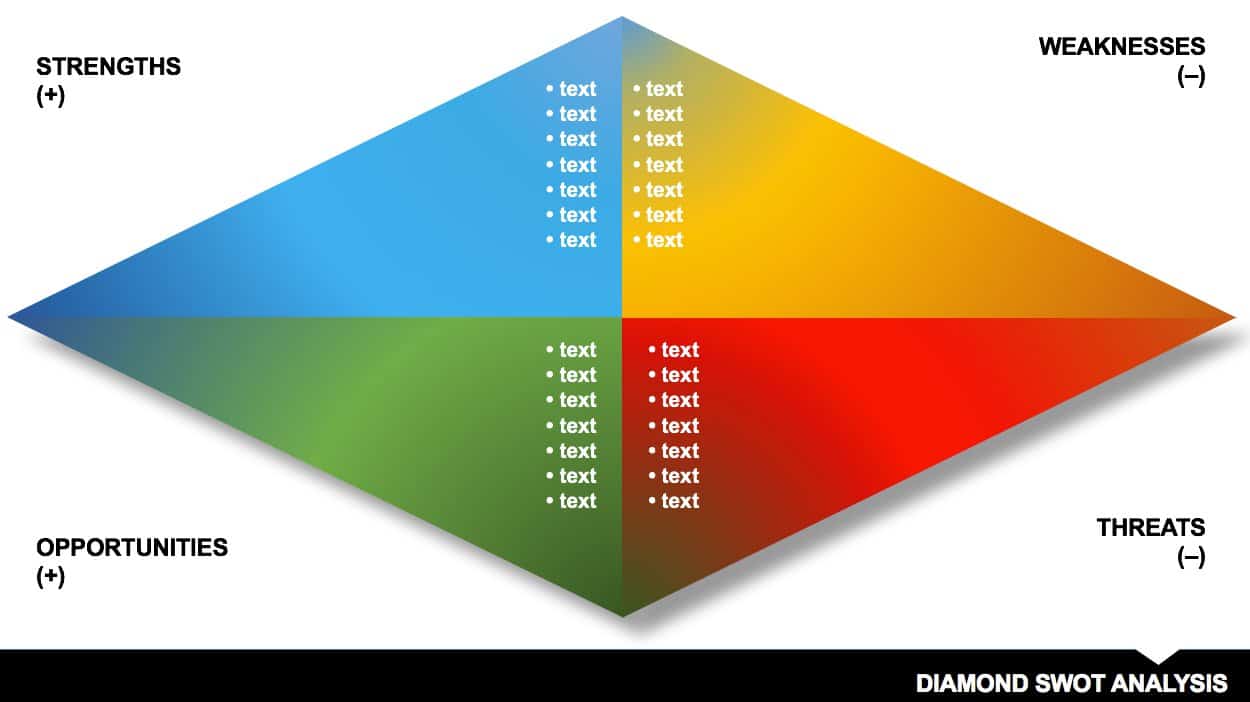
Download Diamond SWOT Analysis Template
For a variation on the 2x2 matrix, this SWOT analysis template puts the categories into a diamond shape divided into four sections. The different colors help each section to stand out, creating a vibrant PPT template. You get a unique layout while still maintaining internal and external factors displayed side-by-side.
Career Change SWOT Analysis Template
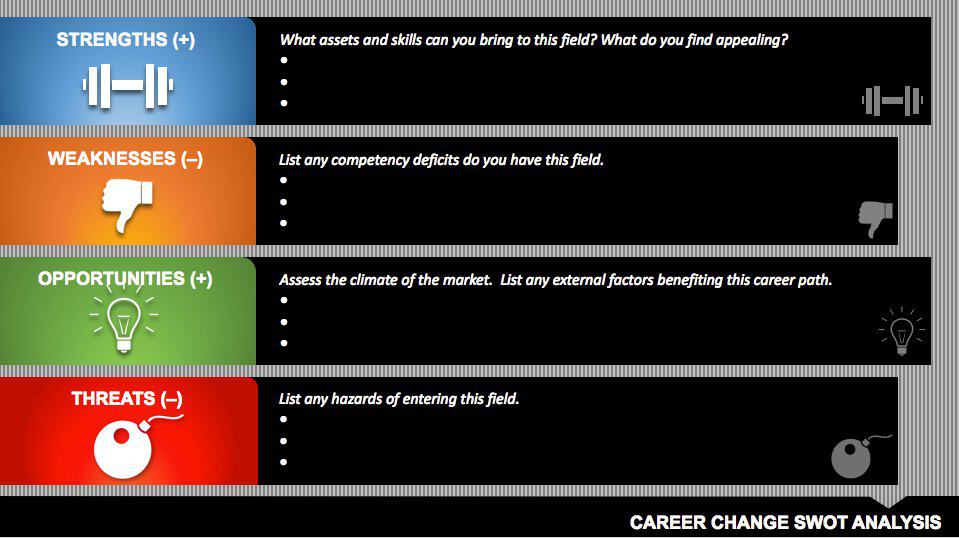
Download Career Change SWOT Analysis Template
Use this template to create a personal SWOT analysis in PowerPoint format focusing on career change. Examine your professional strengths as well as any weaknesses that may need to be addressed before switching careers. Take into account external factors such as networking opportunities, new market trends, quality of life issues, and your competitors. Weighing key factors can help clarify what steps you need to take in order to successfully transition to a new career.
SWOT Analysis Templates for Word
Simple swot matrix template.
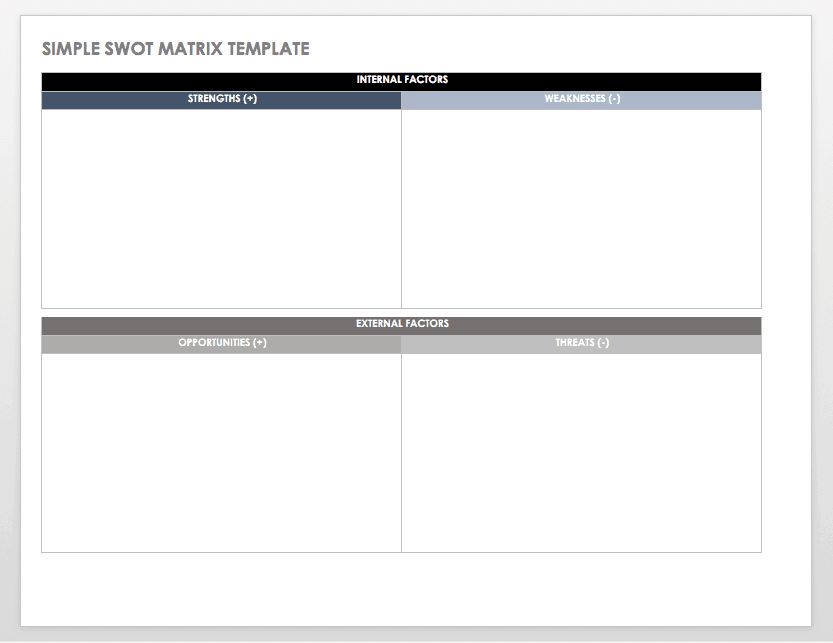
Word | Smartsheet
This template offers a colorful SWOT matrix in Word format. While most SWOT templates for Word are black and white, the added color here provides an interesting design element while keeping the layout simple. The template can also be easily modified to suit your needs.
Business Planning SWOT Template
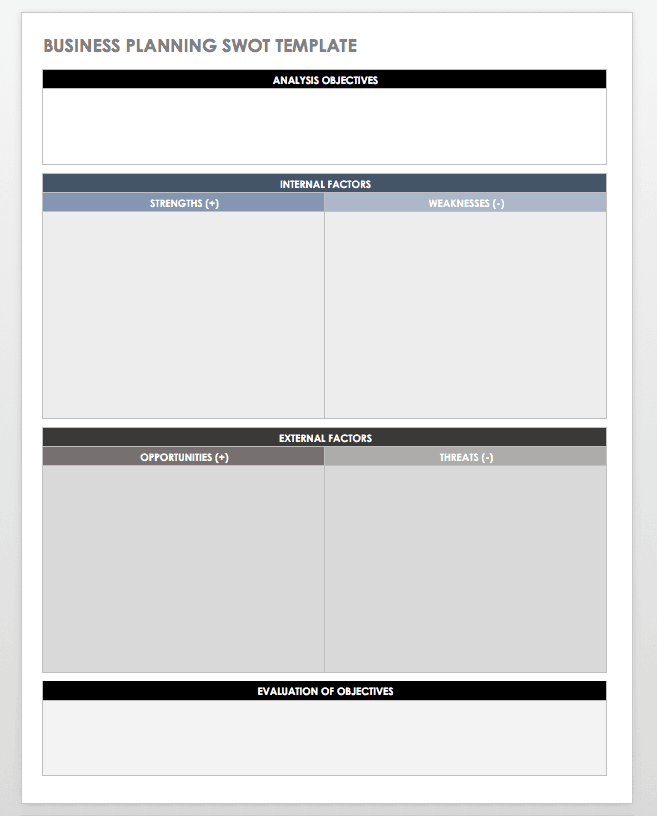
Download Business Planning SWOT Template - Word
With sections for a clearly defined objective, internal and external factors, and evaluation, moving from goal to strategy is the focus of this SWOT analysis template. Word templates offer easy printing and sharing for brainstorming sessions or a group process. Use this template to analyze and plan for your next product launch or business objective.
SWOT Analysis Template With Summary
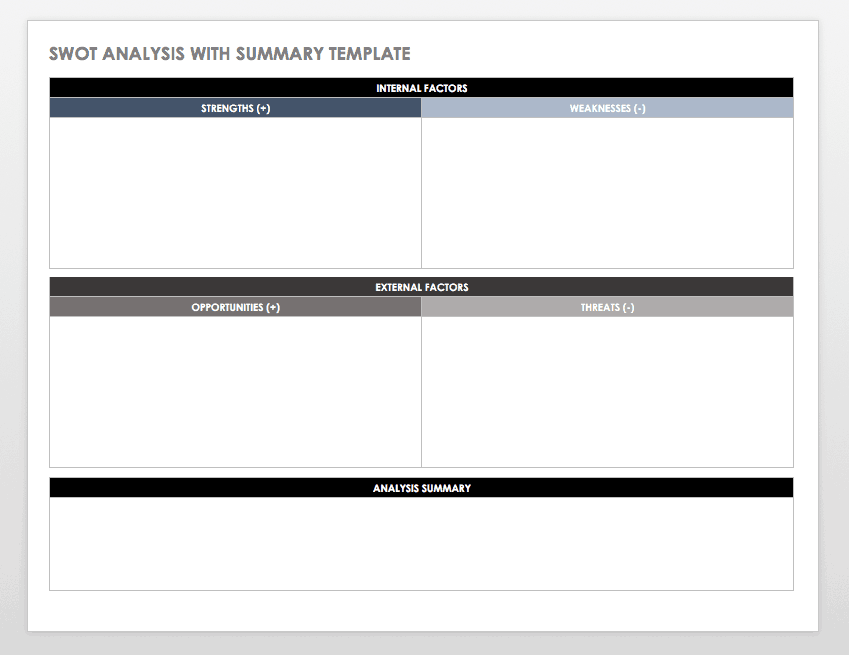
Download SWOT Analysis Template with Summary - Word
This SWOT template includes a section for providing a written summary of the analysis. Use this section to present strategies based on the findings of your analysis, or for brainstorming, outlining an action plan, or proposing a revised objective. The template offers a straightforward layout that is easy to read and use.
Personal SWOT Analysis Template
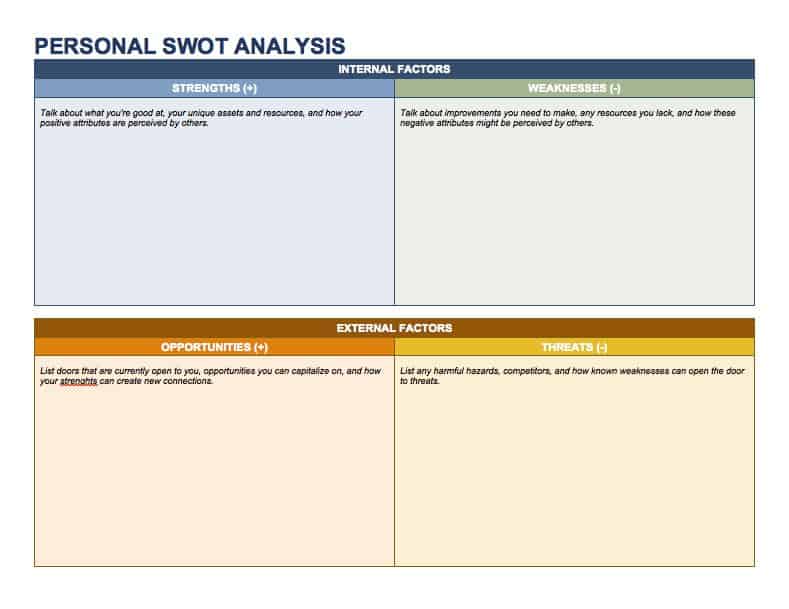
Download Personal SWOT Analysis Template
A personal SWOT analysis can be useful for reaching a personal goal, improving performance at work, applying for a new job, or other situations requiring an honest and detailed look at what factors may be supporting you or holding you back. Your strengths may lead you to opportunities, while your weaknesses could make you vulnerable to certain threats. Use this personal SWOT template to identify your internal and external resources as well as weak spots and areas for improvement. Save the analysis as a Word doc or PDF and print for reference.
Understanding SWOT Analysis
Why use swot analysis.
A SWOT analysis can be used as part of business planning, market analysis, project management, organizational change, individual development (such as a career change or evaluation), or any situation requiring strategic planning to reach an objective. It is sometimes done in combination with a PEST analysis, which looks at the broader political, economic, social and technological factors, and provides a macro-environmental view. This broader external analysis may be relevant depending on the size of the business and type or scope of project under consideration, but a simple SWOT analysis can be helpful for any size of business. And since the analysis considers both internal and external factors, it’s an opportunity for businesses to take an honest look at what they can handle and which strategies or operations need to change.
While you can create a SWOT analysis using a list format to document strengths, weaknesses, opportunities and threats, it is common for these categories to be represented in a 2x2 matrix. The matrix is essentially a table with four columns, showing internal factors on top and external below. This format puts the categories side-by-side, making it easier to see correlations among them. The SWOT templates provided below include the matrix format as well as other options. You’ll find templates for Microsoft Word, Excel and PowerPoint. All of the templates are free to download and can be customized to fit your project’s needs. A SWOT template in Word offers simplicity, while Excel allows you to include additional data sheets in your analysis, and PowerPoint templates provide a visual display to enhance presentations. We’ve also included a Smartsheet SWOT template, which provides the benefits of a spreadsheet format with enhanced collaboration and additional features.
Internal and External Factors in SWOT Analysis
No matter which template you choose, your analysis will include the four SWOT categories. Let’s take a closer look at what constitutes strengths, weaknesses, opportunities and threats.
- Strengths and Weaknesses - These are internal factors, which in a business context may include financial resources, human resources, facilities, equipment, processes and systems. They may include elements such as business culture, certifications, reputation, and leadership. It’s important to remember that what constitutes a strength or weakness will depend on the objective you are assessing. An element of your business could be a strength in one instance and a weakness in another context depending on how it affects your objectives. In general, you are looking for what characteristics give your business an advantage or disadvantage over others in achieving the objective.
- Opportunities and Threats - The external elements influencing your business may include market trends, outside funding, customer demographics, suppliers, the economic climate, political and environmental issues, and other factors. The analysis can help identify new business opportunities and areas for growth as well as issues that could hinder a project or business endeavor. External factors are typically outside of your control - even weather and seasonal changes can influence business goals. Anticipating these factors early can help your team plan ahead and stay flexible when they occur. Part of the analysis is to examine how external opportunities and threats relate to internal strengths and weaknesses in order to determine whether an objective is even attainable and create a strategy for moving forward.
The SWOT framework is effective for analyzing and creating a simplified picture of a complex situation. But it’s possible for it to be an oversimplification, which is one of the limitations of SWOT analysis. Another is that it is primarily a summary tool and doesn’t provide a clear plan of action. Taking SWOT issues and translating them into actions is a critical part of the process, but it relies on the ability of whoever is conducting the analysis to identify key factors and use them to develop an effective strategy. This is a subjective process with inherent limitations, but there is no question that SWOT analysis can provide valuable insight for any business, project or individual.
Take Action on Your SWOT Analysis with Effective Project Management in Smartsheet
Determining the strengths, weaknesses, opportunities, and threats related to your project or organization is a key first step in managing and implementing a successful plan of action. Once you’ve completed your SWOT analysis, it’s essential that you have the right tools in place to plan, manage, automate, and report on your project plan.
Smartsheet is a work execution platform that enables enterprises and teams to get from idea to impact - fast. Top project management leaders rely on Smartsheet to help align the right people, resources, and schedules to get work done.
Use Smartsheet to create consistent project elements, increase speed, and improve collaboration with scalable options that fit individual work preferences. Hold yourself and your team accountable, improve visibility into team priorities, and ensure nothing slips through the cracks.
Try Smartsheet to discover why project managers around the world use it to deliver projects on time and on budget.
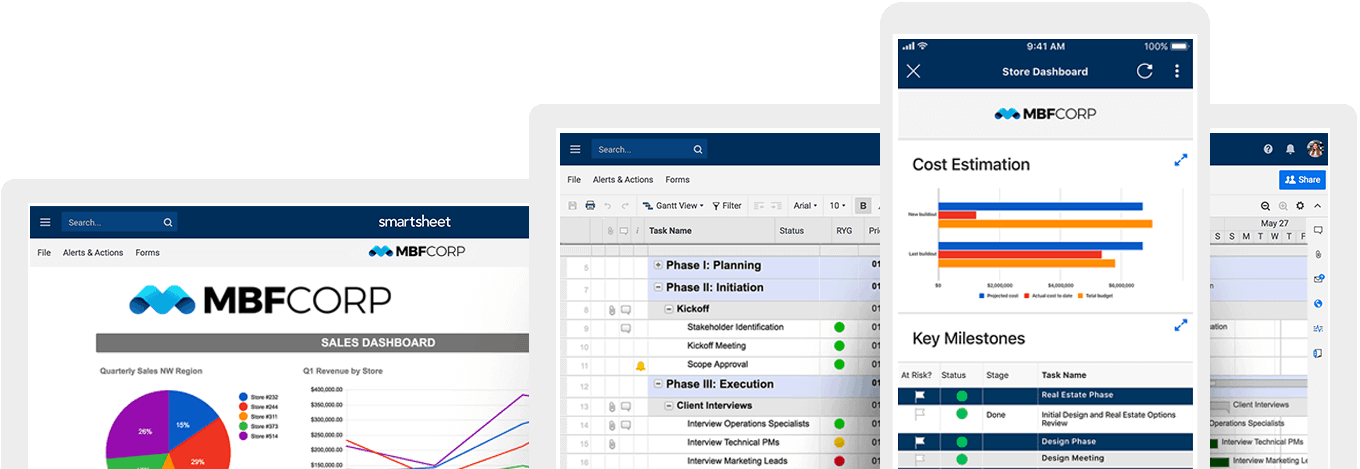
Additional Resources
Project management
The Top Project Plan Templates
Discover an easier, more collaborative way to create project plans.
Apr 3, 2024 16 min read
Deliver on SWOT analysis findings with real-time project management.

- Certifications
- Associate Business Strategy Professional
- Senior Business Strategy Professional
- Examination
- Partnership
- For Academic Affiliation
- For Training Companies
- For Corporates
- Help Center
- Associate Business Strategy Professional (ABSP™)
- Senior Business Strategy Professional (SBSP™)
- Certification Process
- TSI Certification Examination
- Get your Institution TSI Affiliated
- Become a Corporate Education Partner
- Become a Strategy Educator
Frequently Asked Questions
Swot analysis: how to strengthen your business plan.

Introduction
Every business, big or small needs a solid plan to succeed. A well-constructed business plan takes into account the strengths and weaknesses of a company and the opportunities and threats present in the marketplace. One of the most useful tools for assessing these factors is the SWOT analysis as it provides a comprehensive overview of a company's current situation and potential for growth. In this article, we will discuss what a SWOT analysis is, why it is important for businesses, who should conduct it, and how to conduct it effectively.
What is a SWOT analysis?
Have you ever wondered how businesses manage to evaluate all the internal and external factors that could affect their success? Welcome to the SWOT analysis. It's a strategic planning tool that helps businesses identify their Strengths, Weaknesses, Opportunities, and Threats.
Strengths refer to internal factors that give a company an edge over its competitors. Think of a strong brand, loyal customer base, experienced employees, or efficient operations. Weaknesses, on the other hand, are internal factors that put a company at a disadvantage. These could be a weak brand, lack of funding, inexperienced employees, or outdated technology .
But what about external factors that could impact a business's success? That's where Opportunities and Threats come in. Opportunities are external factors that could help a company grow and succeed. This could include a growing market, new trends, technological advancements, or changes in regulations. Threats, on the other hand, are external factors that could harm a company's growth and success. Examples of threats could be economic downturns, increased competition, changes in consumer behavior, or natural disasters.
By conducting a SWOT analysis, businesses can make informed decisions about their strategic initiatives. By focusing their resources on areas with the greatest potential for growth and competitive advantage, businesses can increase their profitability, market share, and long-term success. So, whether you're a business strategist, executive, manager, or consultant, SWOT analysis can provide a fresh perspective on your company's current situation and potential for growth .
Why is a SWOT analysis important for businesses?
A SWOT analysis is essential for developing a business plan that maximizes a company's strengths, minimizes its weaknesses, and takes advantage of opportunities while mitigating threats.
Here are some of the reasons why a SWOT analysis is important for businesses:
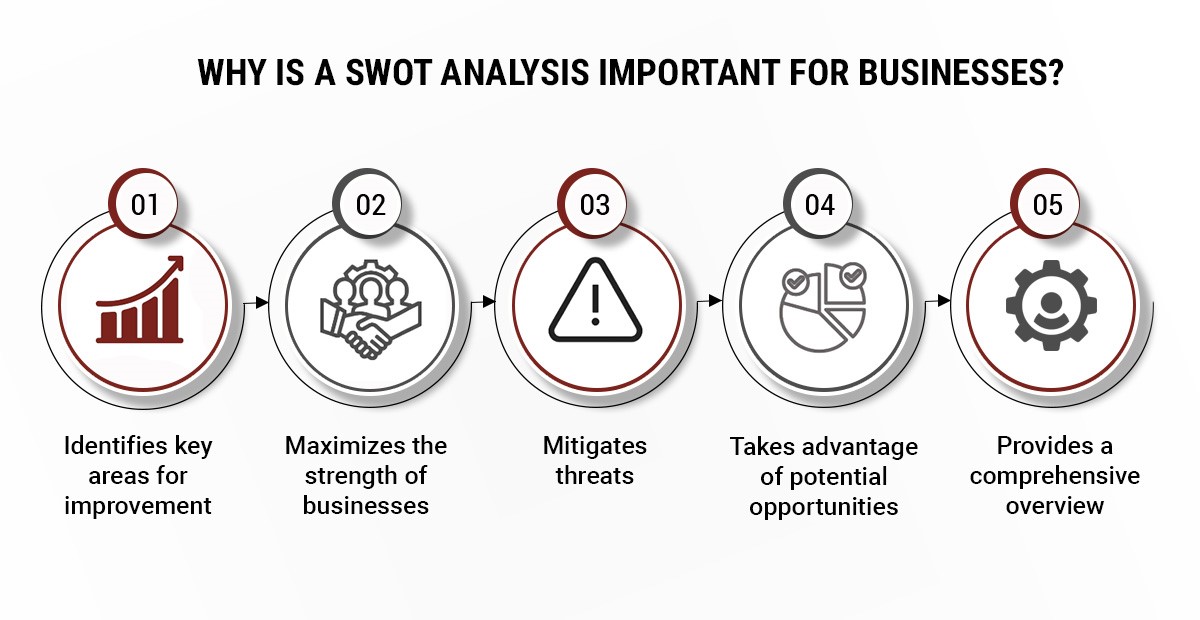
- Identifies key areas for improvement By conducting the SWOT analysis, businesses can gain a better understanding of their internal weaknesses and external threats, which enables them to prioritize areas for improvement. They can then focus their resources and efforts on those areas, which can help them become more competitive and improve their overall performance.
- Maximizes the strength of businesses In addition to identifying areas for improvement, SWOT analysis also helps businesses identify their strengths. By leveraging these strengths, businesses can differentiate themselves from their competitors and take advantage of their competitive advantages. This can lead to increased market share, improved profitability, and overall success.
- Mitigates threats SWOT analysis can help businesses identify potential threats to their operations and take proactive measures to mitigate them. This could include diversifying their product or service offerings, investing in risk management strategies, or developing contingency plans to minimize the impact of unforeseen events.
- Takes advantage of potential opportunities In addition to mitigating threats, SWOT analysis can also help businesses identify potential opportunities for growth and success. By capitalizing on these opportunities, businesses can increase their market share, expand their customer base, and improve their overall performance.
- Provides a comprehensive overview Finally, SWOT analysis provides a comprehensive overview of a company's internal and external factors. This can help businesses develop a well-informed business plan that takes into account their current situation and potential for growth. By developing a strategic plan based on the SWOT analysis, businesses can increase their chances of success and achieve their long-term goals.
How to conduct a SWOT analysis?
Now that we know what a SWOT analysis is and why it is important for businesses, let's discuss how to conduct a SWOT analysis effectively. Here are the steps involved:
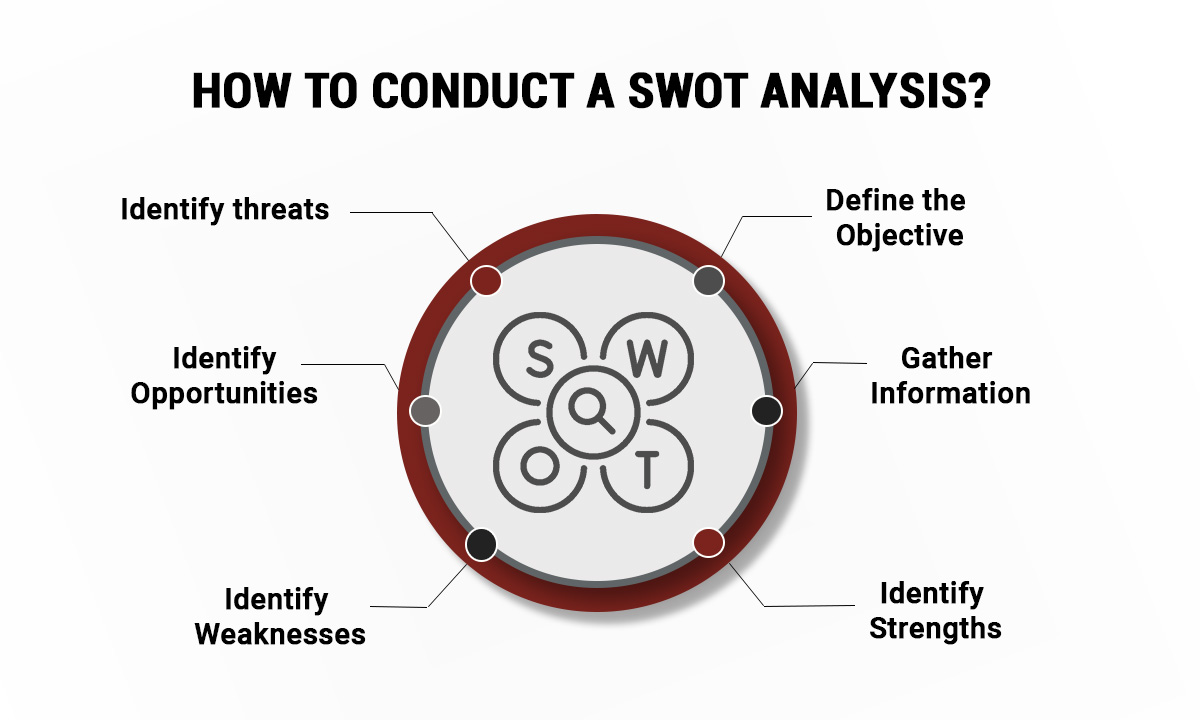
- Define the objective: The first step in conducting a SWOT analysis is to define the objective. What is the purpose of the analysis? What are the specific goals that the analysis aims to achieve? Defining the objective will help focus the analysis and ensure that it is relevant to the specific needs of the business.
- Gather information: Once you have defined the objective, the next step is to gather information about the business, its industry, and its competitors. This can include things like financial reports, customer feedback, market research, and competitor analysis.
- Identify strengths: What are the things that the business does well? What advantages does it have over its competitors? This can include things like a strong brand, loyal customer base, experienced employees, and efficient operations.
- Identify weaknesses: The next step is to identify the weaknesses of the business. What are the areas that need improvement? What disadvantages does it have compared to its competitors? This can include things like a weak brand, lack of funding, inexperienced employees, and outdated technology.
- Identify opportunities: To identify the opportunities available to the business , you need to address questions such as, What are the trends in the industry? What changes in regulations could benefit the business? What new technologies are emerging? This can include things like a growing market, new trends, technological advancements, and changes in regulations.
- Identify threats: The final step is to identify the threats to the business. What are the economic, social, and environmental factors that could impact the business negatively? What are the risks associated with the current situation and potential growth opportunities? This can include things like economic downturns, increased competition, changes in consumer behavior, and natural disasters.
Once the SWOT analysis is complete, the next step is to use the information to develop a strategic plan that maximizes the strengths of the business, minimizes its weaknesses, takes advantage of opportunities, and mitigates threats.
Who should conduct a SWOT analysis and what are the benefits?
A SWOT analysis can be conducted by anyone involved in the strategic planning process of a business. This can include business strategists , executives, managers, and consultants. Here are some of the benefits of conducting a SWOT analysis:
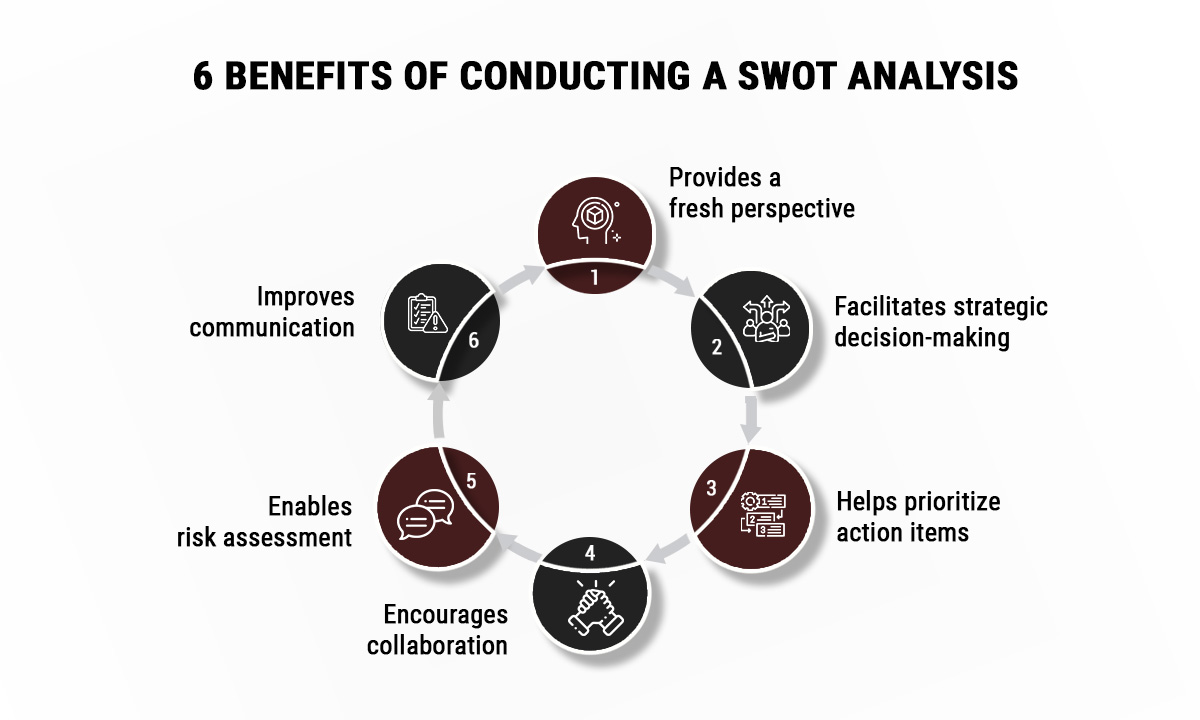
- Provides a fresh perspective on a company's strengths, weaknesses, opportunities, and threats, allowing for a more objective view of the situation.
- Facilitates strategic decision-making that enables businesses to make informed strategic decisions based on their current situation and potential for growth.
- Helps prioritize action items based on their importance and potential impact to the business.
- Encourages collaboration among team members, allowing for a more comprehensive analysis of the situation.
- Enables risk assessment associated with their current situation and potential growth opportunities.
- Improves communication among team members, ensuring that everyone is on the same page regarding the current situation and potential for growth.
This information helps businesses to prioritize their key strategic initiatives, focus their resources on areas with the greatest potential for growth and competitive advantage, and develop a strategic plan that aligns with their goals and objectives. Ultimately, a SWOT analysis helps businesses to make more effective strategic decisions that can lead to increased profitability, market share, and long-term success.
Example of a SWOT analysis
To help illustrate the SWOT analysis process, let's take a look at an example of a SWOT analysis for a company in the fashion industry:
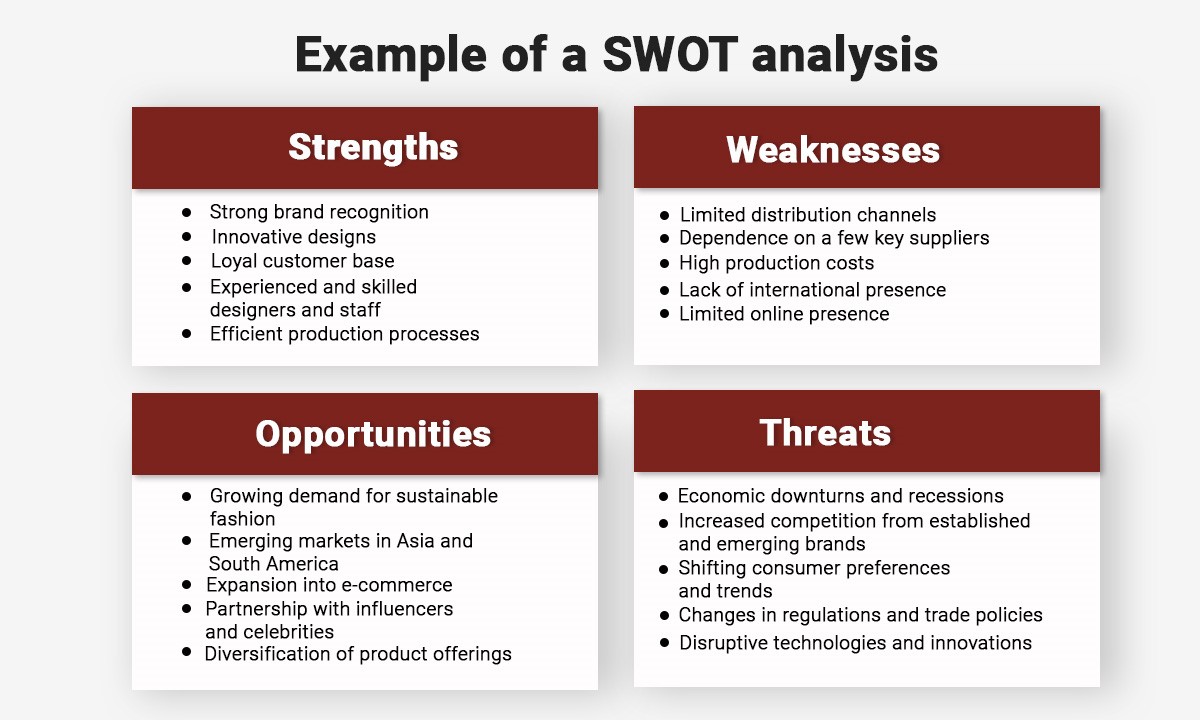
- Strong brand recognition
- Innovative designs
- Loyal customer base
- Experienced and skilled designers and staff
- Efficient production processes
- Limited distribution channels
- Dependence on a few key suppliers
- High production costs
- Lack of international presence
- Limited online presence
Opportunities
- Growing demand for sustainable fashion
- Emerging markets in Asia and South America
- Expansion into e-commerce
- Partnership with influencers and celebrities
- Diversification of product offerings
- Economic downturns and recessions
- Increased competition from established and emerging brands
- Shifting consumer preferences and trends
- Changes in regulations and trade policies
- Disruptive technologies and innovations
Using this SWOT analysis, the company could focus on expanding its distribution channels and international presence, reducing production costs, and investing in sustainable and diverse product offerings.
Q: Is a SWOT analysis only for large businesses? A: No, a SWOT analysis is beneficial for businesses of all sizes, including small businesses.
Q: Can a SWOT analysis be conducted for a specific project or product? A: Yes, a SWOT analysis can be conducted for a specific project or product to evaluate its strengths, weaknesses, opportunities, and threats.
Q: How often should a SWOT analysis be conducted? A: It is recommended to conduct a SWOT analysis at least once a year or whenever there are significant changes in the industry, competition, or business environment.
Q: What should I do with the information gathered from a SWOT analysis? A: The information gathered from a SWOT analysis should be used to develop a strategic plan that maximizes strengths, minimizes weaknesses, takes advantage of opportunities, and mitigates threats.
In conclusion, a SWOT analysis is an important tool that can help businesses of all sizes and industries to identify their strengths, weaknesses, opportunities, and threats. By conducting a SWOT analysis, businesses can gain a better understanding of their current situation and potential growth opportunities, enabling them to make informed business decisions and develop effective business strategies. As a strategic leader or business strategist, it is important to conduct a SWOT analysis regularly to stay up-to-date with changes in the industry and competition, and ensure that your business plan is relevant and effective in achieving your business goals.

Recent Posts

How Data Analytics Can Revolutionize Your Business - A Strategist's Guide
Download this Strategist's Guide to empower yourself with resourceful insights:
- Roadblocks to Data Usage
- Advantages that Data Analytics offer for businesses
- Elements of a Data Analytics Strategy
- Top reasons why businesses must adopt a Data Analytics Strategy
- Case studies, Scenarios, and more

CredBadge™ is a proprietary, secure, digital badging platform that provides for seamless authentication and verification of credentials across digital media worldwide.
CredBadge™ powered credentials ensure that professionals can showcase and verify their qualifications and credentials across all digital platforms, and at any time, across the planet.

Verify A Credential
Please enter the License Number/Unique Credential Code of the certificant. Results will be displayed if the person holds an active credential from TSI.
Stay Informed!
Keep yourself informed on the latest updates and information about business strategy by subscribing to our newsletter.
Start Your Journey with The Strategy Institute by Creating Your myTSI Account Today.
- Manage your professional profile conveniently.
- Manage your credentials anytime.
- Share your experiences and ideas with The Strategy Institute.
Account Login
- Remember Password
- Forgot Password?
Forgot Password
PIATTAFORMA
- Panoramica del prodotto
- Tutte le funzionalità
- Integrazioni app
FUNZIONALITÀ
- project icon Gestione dei progetti
- Viste di progetto
- Campi personalizzati
- Aggiornamenti di stato
- goal icon Obiettivi e resoconti
- Dashboard dei resoconti
- workflow icon Flussi di lavoro e automazione
- Aggregazioni
- portfolio icon Gestione delle risorse
- Gestione delle risorse
- Monitoraggio del tempo
- my-task icon Amministrazione e sicurezza
- Console di amministrazione
- asana-intelligence icon IA di Asana
TUTTI I PIANI
- list icon Personal
- premium icon Starter
- briefcase icon Advanced
- Gestione degli obiettivi
- Pianificazione dell’organizzazione
- Gestione delle campagne
- Produzione di creatività
- Calendari dei contenuti
- Pianificazione strategica di marketing
- Pianificazione delle risorse
- Proposte di progetto
- Lancio di prodotti
- Onboarding dei dipendenti
- Visualizza tutti gli usi arrow-right icon
- Piani di progetto
- Obiettivi del team
- Continuità del team
- Ordine del giorno della riunione
- Visualizza tutti i modelli arrow-right icon
- Risorse per la gestione del lavoro Scopri le best practice, guarda i webinar, ottieni approfondimenti
- Novità Scopri le ultime novità di Asana
- Storie del cliente Scopri come le migliori organizzazioni del mondo promuovono l’innovazione del lavoro con Asana
- Centro assistenza Suggerimenti, trucchi e consigli per ottenere il massimo da Asana
- Asana Academy Iscriviti a corsi interattivi e webinar per imparare a utilizzare Asana
- Sviluppatori Scopri di più sulla creazione di app sulla piattaforma Asana
- Programmi della community Entra in contatto con i clienti di Asana in tutto il mondo e impara da loro
Entra in contatto
- Eventi Scopri gli eventi in programma vicino a te
- Partner Scopri di più sui nostri programmi partner
- Assistenza Hai bisogno di aiuto? Contatta il servizio di assistenza di Asana
- Asana per le organizzazioni non-profit Ottieni maggiori informazioni sul nostro programma di sconti per le organizzazioni non-profit e fai domanda.
Articoli in primo piano

- Gestione dei progetti |
- Analisi SWOT: cos'è e come si usa (con ...
Analisi SWOT: cos'è e come si usa (con esempi)

L'analisi SWOT permette di identificare i punti di forza, di debolezza, le opportunità e le minacce di un progetto specifico o del tuo piano aziendale globale. È uno strumento che può aiutare il tuo team a pianificare in modo strategico e a stare al passo con le tendenze del mercato. In questo articolo descriviamo gli aspetti della matrice SWOT e forniamo istruzioni dettagliate per aiutarti a condurre la tua analisi.
Che tu stia cercando opportunità esterne o punti di forza interni, ti illustreremo come eseguire l'analisi SWOT, con utili esempi lungo il percorso.
Che cos'è l'analisi SWOT?
L'analisi SWOT è una tecnica utilizzata per identificare i punti di forza, di debolezza, opportunità e minacce della tua azienda o anche di un progetto specifico. Sebbene sia ampiamente usata da molte organizzazioni, dalle piccole imprese agli enti non-profit fino alle grandi imprese, l'analisi SWOT può essere utilizzata sia per scopi personali che professionali.
Per quanto semplice, l'analisi SWOT è un potente strumento che aiuta a identificare opportunità competitive di miglioramento. In questo modo, puoi migliorare il tuo team e il tuo business, rimanendo al passo con le tendenze del mercato.
Che cosa significa SWOT?
In poche parole, SWOT sta per Strengths (punti di forza), Weaknesses (punti di debolezza), Opportunities (opportunità) e Threats (minacce). Ciascuno di questi fattori va esaminato attentamente per pianificare adeguatamente la crescita dell'organizzazione. È qui che entra in gioco l'analisi.

Se analizzato insieme, il framework SWOT presenta un quadro più ampio della tua condizione attuale e come arrivare alla fase successiva. Analizziamo un po' più a fondo ciascuno di questi termini e come possono contribuire a identificare le aree di miglioramento.
Punti di forza
I punti di forza nell'analisi SWOT sono quelle iniziative interne che danno buoni risultati. Li puoi confrontare con altre iniziative o un vantaggio competitivo esterno. Questa valutazione ti aiuta a capire cosa funziona, e, una volta individuati i tuoi punti di forza li potrai applicare in altri ambiti, ad esempio per migliorare l' efficienza del team .
Quando esamini i punti di forza della tua organizzazione, poniti le seguenti domande per iniziare:
Cosa facciamo bene?
Cosa ha di unico la nostra organizzazione?
Cosa apprezza della nostra organizzazione il nostro pubblico di destinazione?
Ecco un esempio di punto di forza per aiutarti a iniziare.
Servizio clienti: il nostro servizio clienti è di prim'ordine rispetto alla concorrenza, visto che abbiamo un punteggio NPS di 90.
Punti di debolezza
I punti deboli nell'analisi SWOT si riferiscono a iniziative interne che non rendono quanto dovrebbero. È una buona idea analizzare i punti di forza prima di quelli di debolezza per tracciare una linea tra il successo e il fallimento. Identificare i punti deboli interni fornisce un punto di partenza per migliorare tali progetti.
Come per i punti di forza, puoi porti diverse domande per iniziare a identificare i tuoi punti deboli:
Quali iniziative sono poco performanti e perché?
Cosa può essere migliorato?
Quali risorse potrebbero migliorare le nostre prestazioni?
Ecco un esempio di punto debole.
Visibilità dell'e-commerce: la visibilità del nostro sito web è bassa a causa della mancanza di fondi per il marketing e le transazioni delle app per dispositivi mobili continuano a diminuire.
Opportunità
Le opportunità nell'analisi SWOT sono il risultato dei tuoi attuali punti di forza e debolezza, insieme a qualsiasi iniziativa esterna che ti metterà in una posizione competitiva più forte. Potrebbe trattarsi di punti deboli che vorresti migliorare o aree che non sono state identificate nelle prime due fasi della tua analisi.
Poiché ci sono vari modi per trovare delle opportunità, è utile considerare queste domande prima di iniziare:
Quali risorse possiamo utilizzare per migliorare i punti deboli?
Ci sono aspetti del mercato non coperti dai nostri servizi?
Quali sono i nostri obiettivi per l'anno?
Ecco un esempio di un'opportunità basata sui punti di forza e debolezza di cui sopra.
Campagna di marketing: per migliorare la visibilità dell'e-commerce, promuoveremo campagne pubblicitarie su YouTube, Facebook e Instagram.
Le minacce nell'analisi SWOT si riferiscono ad aree che potenzialmente potrebbero creare problemi. Sono diverse dai punti deboli, in quanto sono esterne e generalmente fuori dal tuo controllo. Possono essere di tutto, da una pandemia globale a un cambiamento nel panorama competitivo.
Ecco alcune domande che dovresti porti per identificare le minacce esterne:
Quali cambiamenti nel settore sono motivo di preoccupazione?
Quali sono le nuove tendenze di mercato all'orizzonte?
Dove la concorrenza fa meglio di noi?
Ecco un esempio di una minaccia che potrebbe esporre la tua azienda a problemi.
Nuovo concorrente : con un nuovo concorrente di e-commerce che inizierà a operare entro il prossimo mese, potremmo assistere a un calo dei clienti.
Esempio di analisi SWOT
Uno dei modi più popolari per creare l'analisi SWOT è rappresentare visivamente punti di forza, punti di debolezza, opportunità e minacce. Questo formato è chiamato matrice SWOT. Di solito, è organizzata in quattro quadrati separati, che si uniscono per creare un quadrato più grande.
La matrice SWOT è perfetta per raccogliere informazioni e documentare le domande che ti hanno portato a prendere le tue decisioni. Non solo sarà utile come riferimento in un secondo momento, ma è anche ottima per visualizzare eventuali tendenze che emergono.
Ecco un esempio per darti un'idea di come iniziare.
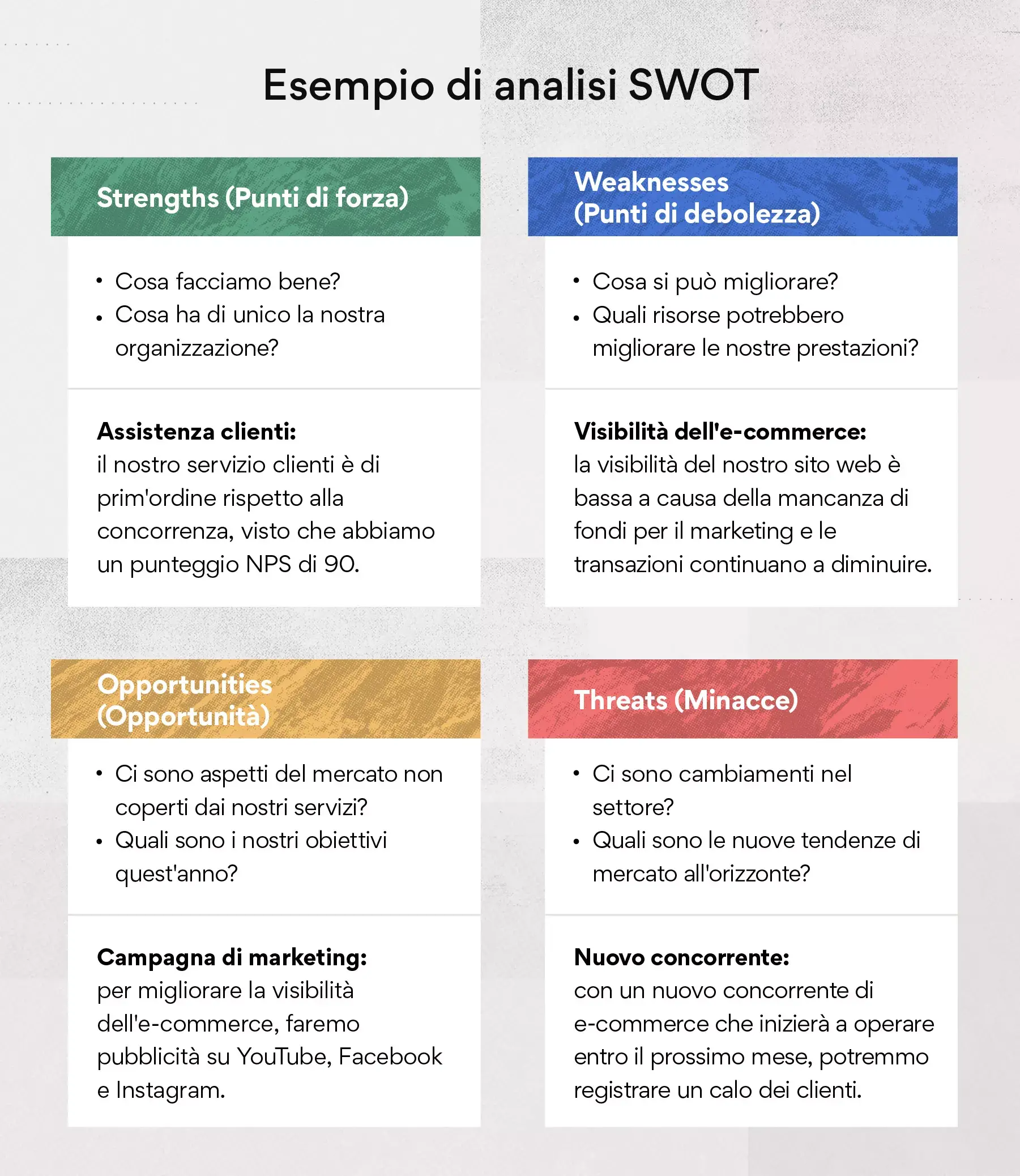
Se utilizzata correttamente ed efficacemente, la matrice può essere un ottimo strumento per valutare i punti di forza e di debolezza della tua organizzazione. Una volta creata la matrice, puoi concentrarti su come implementare effettivamente le opportunità che hai identificato.
Come fare l'analisi SWOT
L'analisi SWOT può essere condotta in vari modi. Mentre ad alcuni team piace riunirsi e raccogliere le idee su una lavagna, altri preferiscono creare una matrice SWOT formale. Qualunque modo tu scelga, usare l'immaginazione per il tuo processo di pianificazione consente di trovare nuove idee e soluzioni più innovative.
Esistono alcuni modi per garantire che l'analisi SWOT sia approfondita ed eseguita correttamente, ad esempio riunire il tuo team in un modo che favorisca il lavoro di squadra, prepararsi in anticipo al fine di utilizzare il tempo al meglio e lasciar spazio alla creatività nella scelta delle idee. Diamo un'occhiata più da vicino ad alcuni suggerimenti per aiutarti a iniziare.
Suggerimento 1: considera i fattori interni
I fattori interni sono punti di forza e di debolezza che derivano da processi interni. Questi tendono a essere più facili da risolvere se hai i mezzi, poiché hai un maggiore controllo sul risultato.
Quando ti imbatti nei fattori interni, puoi iniziare a implementare miglioramenti in un paio di modi diversi.
Incontra le parti interessate del dipartimento per creare un piano aziendale su come migliorare la situazione attuale.
Ricerca e implementa nuovi strumenti, come uno per la gestione dei progetti , che possono aiutarti a semplificare questi processi.
Il modo in cui affronterai i fattori interni dipenderà dal tipo di problema. Potrebbe anche essere necessario utilizzare una combinazione di entrambi i modi, se si tratta di un piano di miglioramento complesso.
Suggerimento 2: valuta i fattori esterni
I fattori esterni derivano da processi al di fuori del tuo controllo e includono la concorrenza, le tendenze di mercato e qualsiasi altro aspetto che condizioni l'organizzazione dall'esterno.
I fattori esterni sono più difficili da gestire, in quanto non puoi controllare direttamente il risultato. Quello che puoi fare è adattare i tuoi processi, in modo da mitigare i fattori esterni negativi. Puoi risolvere questi problemi:
cercando di competere con le tendenze del mercato
prevedendo le tendenze del mercato prima che si verifichino
Sebbene non sia possibile controllare l'ambiente esterno, puoi controllare il modo in cui la tua organizzazione reagisce.
Ipotizziamo che tu voglia far concorrenza a un trend di mercato, ad esempio a un concorrente che introduce un nuovo prodotto migliore del tuo. Non puoi certo eliminare quel prodotto, ma puoi adoperarti per lanciarne uno ancora migliore e cercare di frenare il calo delle vendite. In alternativa, puoi provare a prevedere le tendenze del mercato, in modo da reagire prontamente agli eventi esterni.
Suggerimento 3: il lavoro di squadra fa avverare i sogni
Potrebbe essere un detto antico, ma il lavoro di squadra è incredibilmente efficace per il brainstorming e per trovare idee nuove e innovative. Invita membri dei team di vari reparti per raccogliere le idee da ogni dipartimento dell'azienda. Stabilisci il numero di persone da invitare, poiché troppi invitati potrebbero minare la concentrazione o la partecipazione. Il numero giusto per una sessione di brainstorming produttiva è di circa 10 partecipanti.
Suggerimento 4: usa l'immaginazione
Per generare idee creative, devi prima incoraggiarle, ovvero immaginare modi divertenti per trovare opportunità. Puoi, ad esempio, scegliere casualmente idee anonime, presentare esempi chiaramente inappropriati o organizzare attività di team building per motivare il tuo team.
Suggerimento 5: identifica le idee migliori
Una volta che il divertimento è finito, è il momento di identificare le opportunità migliori e assegnare un punteggio. Lo si può fare in team o con un gruppo più piccolo di leader. Il modo migliore per farlo è discutere ciascuna idea e classificarla su una scala da 1 a 10. Una volta concordate le idee migliori in base alle capacità del team e all'impatto complessivo, puoi lavorare sulla loro implementazione, iniziando con un business case .
Perché un'analisi SWOT è importante?
L'analisi SWOT può aiutarti a migliorare i processi e pianificare la crescita. Sebbene sia simile all' analisi competitiva , si differenzia poiché valuta sia i fattori interni che esterni. L'analisi delle aree chiave legate alle opportunità e alle minacce ti fornirà le informazioni per preparare il tuo team al successo.
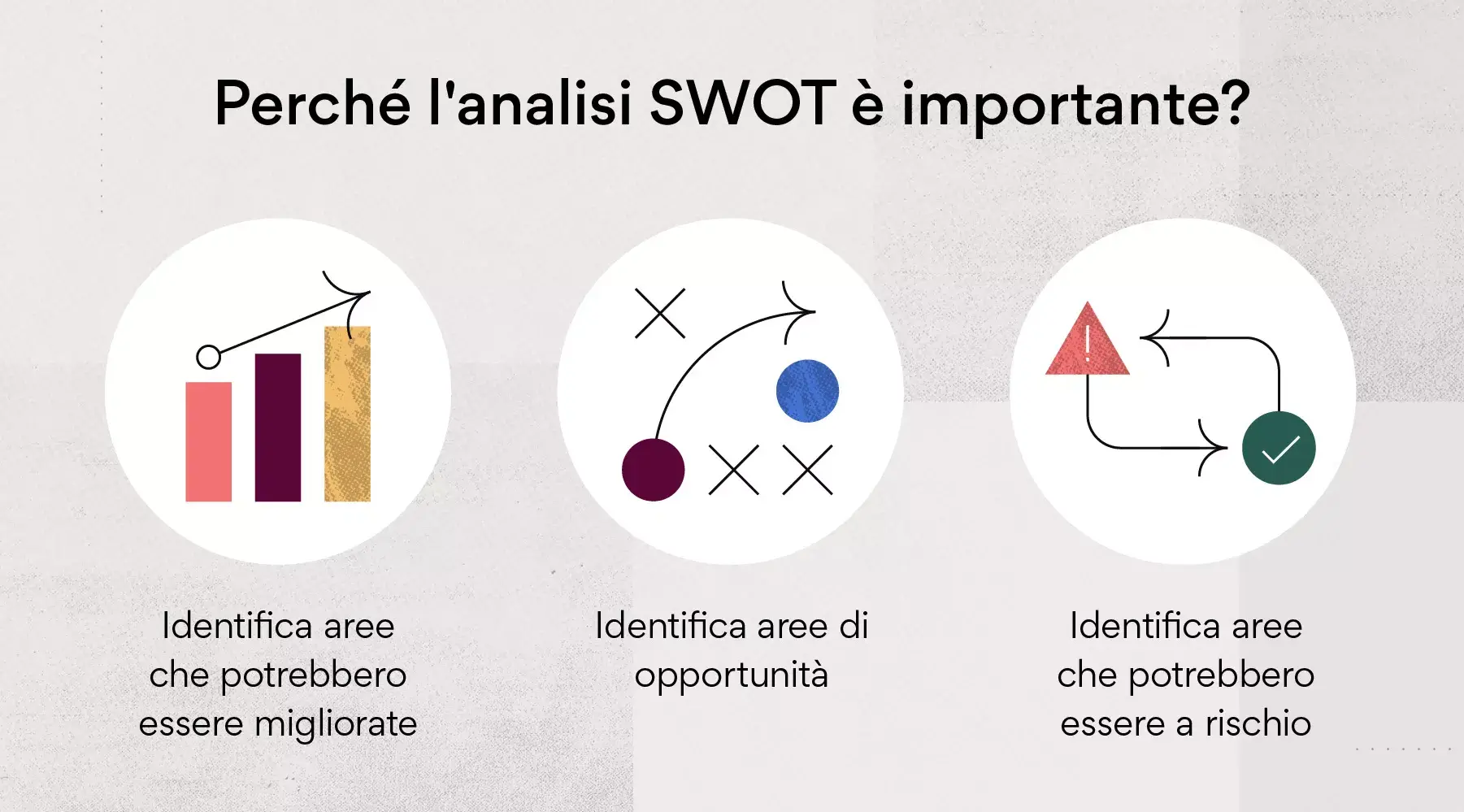
L'analisi SWOT non si rivela utile solo per le organizzazioni. Se applicata a livello personale, ti aiuta a esaminare le aree della tua vita che potrebbero trarre vantaggio da un miglioramento, dal tuo stile di leadership alle tue capacità comunicative. Indipendentemente dal modo in cui la userai, l'analisi SWOT è importante per questi tre motivi.
1. Identifica le aree di opportunità
Uno dei maggiori vantaggi di condurre l'analisi è determinare le opportunità di crescita. È un ottimo punto di partenza per start-up e team che sanno di voler migliorare, ma non sanno esattamente da dove iniziare.
Le opportunità possono presentarsi da ogni dove, come fattori esterni quali la diversificazione dei prodotti per un vantaggio competitivo o fattori interni quali il miglioramento del flusso di lavoro del tuo team. In ogni caso, sfruttare le opportunità è un ottimo modo per crescere come gruppo.
2. Identifica le aree che potrebbero essere migliorate
Migliorare i progetti esistenti è un altro modo infallibile per continuare a crescere. Identificare punti deboli e minacce durante l'analisi SWOT può aprire la strada a una migliore strategia aziendale.
In definitiva, imparare dai propri errori è il modo migliore per eccellere. Una volta individuate le aree che possono essere semplificate, puoi lavorare con i membri del team per elaborare un piano d'azione. Ciò significherà utilizzare quello che funziona e sfruttare i punti di forza della tua azienda.
3. Identifica le aree che potrebbero essere a rischio
Che tu disponga o meno di un registro dei rischi , è sempre fondamentale identificarli prima che diventino motivo di preoccupazione. L'analisi SWOT può aiutarti a rimanere aggiornato su tutti gli elementi utilizzabili che possono entrare in gioco quando devi prendere decisioni in merito ai rischi.
Potrebbe essere utile associare l'analisi SWOT all'analisi PEST, che esamina soluzioni esterne come fattori politici, economici, sociali e tecnologici che possono aiutarti a identificare potenziali rischi in anticipo.
Pianifica la crescita con l'analisi SWOT
L'analisi SWOT è una tecnica efficace per identificare i punti di forza, i punti di debolezza, le opportunità e le minacce principali. Capire a che punto siete e dove volete andare, vi aiuterà a crescere come team e come organizzazione.
Non dimenticare che un po' di creatività e collaborazione possono fare molto. Incoraggia il tuo team a pensare fuori dagli schemi con oltre 100 frasi motivazionali .
Risorse correlate

Work breakdown structure (WBS): cos'è e come si usa

Quindici segreti per creare una lista di cose da fare davvero efficace

Cos'è un risultato finale nella gestione dei progetti?
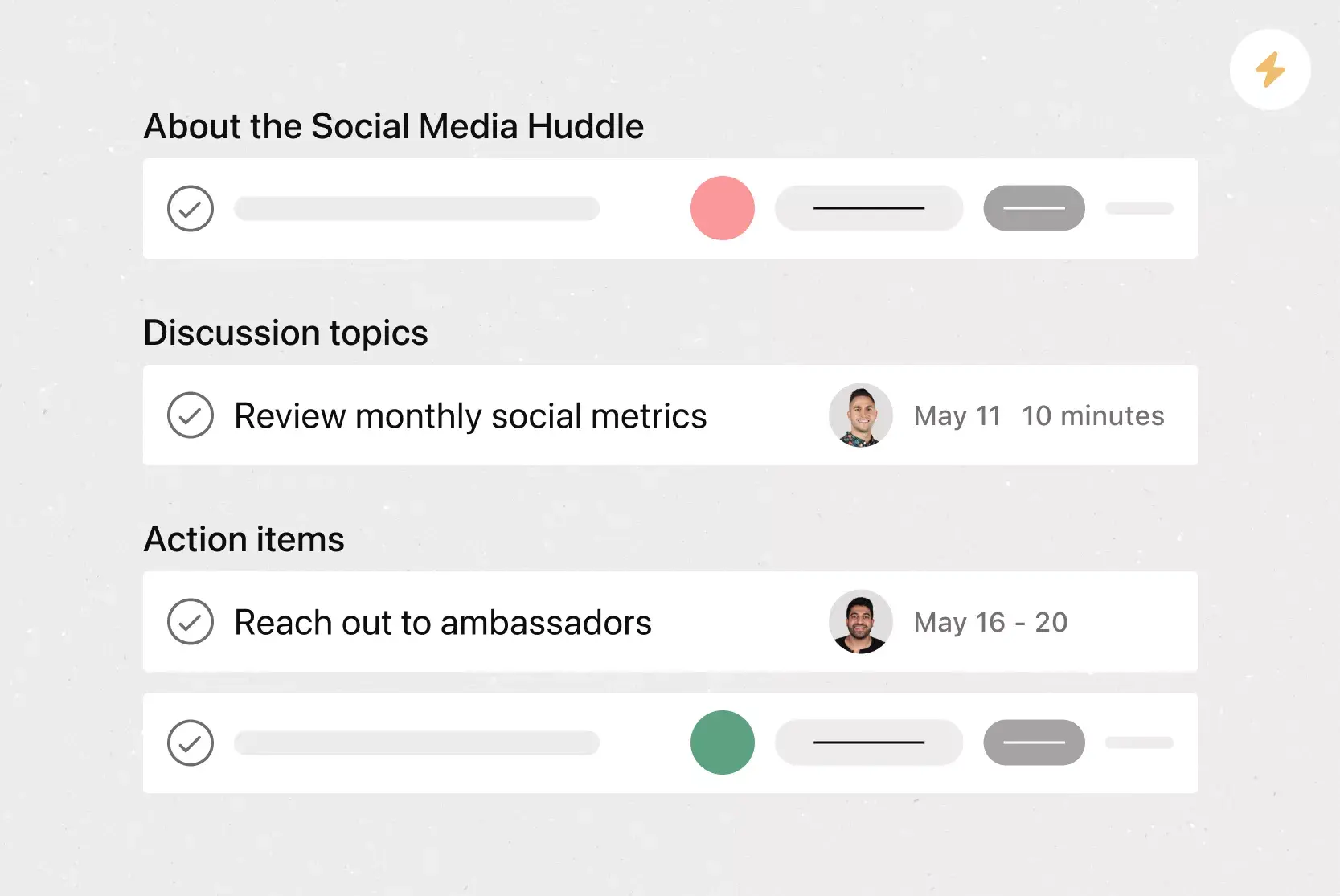
Stride client account management template
In evidenza
Libro di Carta
27,55 € + IVA
34,20 € + IVA
49,40 € + IVA
SCRIVERE UN BUSINESS PLAN CONVINCENTE: L'ANALISI S.W.O.T.
PDF dell'articolo
Salva articolo, sei già utente di fiscoetasse.com, non sei ancora registrato , tool articolo.
- NESSUN ALLEGATO
Scrivere un business plan convincente: l'analisi S.W.O.T.
Ogni business plan richiede l'analisi s.w.o.t., fondamentale per determinare i punti di forza, di debolezza, le opportunità e le minacce, ascolta la versione audio dell'articolo.
Ogni business plan che si rispetti, o anche piano di marketing, sia relativo a start up sia per aziende già avviate, richiede l’analisi S.W.O.T. ovvero l’analisi dei propri punti di forza e di debolezza e delle minacce e opportunità, analisi determinante per poter individuare le strategie di miglioramento più opportune. In questo speciale esamineremo la tecnica dell’analisi S.W.O.T. e, nel caso pratico, come utilizzare tale analisi per ottenere efficaci strategie di differenziazione rispetto ai competitors.
La S.W.O.T. ANALYSIS è una tecnica ideata dall’americano Albert Humphrey ed è l’acronimo di Strenghts (punti di forza), Weaknesses (punti di debolezza), Opportunities (opportunità), Threats (minacce).
L’Obiettivo di questa tecnica consiste nell’analizzare l’impatto dei principali fattori interni e esterni dell’impresa che influenzano il posizionamento rispetto alla concorrenza con lo scopo di elaborare una strategia competitiva e di differenziazione. Occorre quindi distinguere due tipologie di analisi:
- Analisi interna
- Analisi esterna
Circa l’ Analisi interna , l’impresa deve individuare con precisione i suoi punti di forza e anche i punti di debolezza. Questo perché le strategie si devono concentrare sulla possibilità di rafforzare i punti di forza ed eliminare, o quantomeno mitigare, l’effetto negativo dei punti di debolezza. Invece con l’ Analisi esterna l’impresa deve individuare tutti quei fattori che provengono dall’ambiente esterno che possono essere considerate opportunità oppure minacce per il proprio business.
L'articolo continua dopo la pubblicità
Ti potrebbe interessare l'ebook: Business Plan: pacchetto completo
Segui tutto gli approfondimenti nel Dossier dedicato alle PMI
1) Analisi dei fattori interni
I Punti di forza sono tutte quelle capacità e competenze che differenziano l’azienda dai suoi concorrenti e che sono percepiti nettamente anche dai consumatori. Far leva su tali punti comporta il consolidamento del posizionamento dell’impresa con l’ottenimento di buone performance. Per individuare i punti di forza occorre rispondere alle seguenti domande:
- Che cosa so fare meglio?
- Quali conoscenze di know how ho che i concorrenti non hanno?
- Quali sono le risorse di cui posso disporre?
- Quali vantaggi mi attribuiscono i miei clienti?
I Punti di debolezza invece sono quelle caratteristiche dell’azienda che limitano il conseguimento del successo e che devono essere attentamente analizzate al fine di eliminarle o mitigarne gli effetti. Per individuare i punti di debolezza occorre rispondere alle seguenti domande:
- Cosa non so fare?
- Quali sono le conoscenze di know how che mi mancano?
- Quali risorse mi mancano?
- In cosa la concorrenza è migliore?
Facciamo ora un elenco, anche se non esaustivo, di ambiti in cui è possibile individuare i propri punti di forza e di debolezza.
|
|
|
|
|
|
|
|
|
|
|
|
|
|
|
|
|
|
|
|
|
|
Ti potrebbero interessare:
- "Controllo di gestione imprese alberghiere eBook + Excel"
- Management della finanza strategica (eBook 2023)
- Circolare gratuita Gestione finanziaria delle PMI e rischio di revisione
- Prevenzione della crisi di impresa - (Pacchetto Excel)
- Il Budget e la pianificazione strategica (eBook 2022)
- Business Plan (Pacchetto completo)
- Valutazione merito creditizio Fondo garanzia
- MonitorAzienda BUDGET - Pianificazione e Monitoraggio
- Analisi di bilancio per la gestione efficiente (eBook)
Scopri "Finalyst" il Software di Analisi Finanziaria e Corporate Performance Management - RICHIEDI DEMO GRATUITA
2) Analisi di fattori esterni
Le Minacce sono tutte quelle tendenze dell’ambiente esterno che influiscono in modo negativo sul successo dell’impresa. Tali fattori devono essere previsti al fine di evitarli o mitigarne gli effetti. Per individuare le minacce esterne occorre rispondere alle seguenti domande:
- Il trend del mio mercato sta cambiando?
- I concorrenti stanno attuando strategie che mi danneggiano?
- L’avanzare delle nuove tecnologie minaccia il mio prodotto?
- Il costo del denaro e dei finanziamenti è aumentato?
Le Opportunità invece sono tutte quelle tendenze dell’ambiente esterno che possono portare dei vantaggi all’impresa, come ad esempio l’introduzione di una nuova normativa, mutamenti sociali e dei gusti del consumatore, fasi positivi del ciclo economico, sviluppo di nuove tecnologie, eventi locali a noi vantaggiosi.
Per individuare le opportunità occorre rispondere alle seguenti domande:
- Sono in atto nuove tendenze sociali?
- Il reddito disponibile sta aumentando?
- Sono state emanate leggi per me vantaggiose?
- La tecnologia mi apre nuove frontiere?
Facciamo ora un elenco, non esaustivo, di ambiti in cui è possibile individuare minacce e opportunità.
|
|
|
|
|
|
|
|
|
|
|
|
Dopo aver individuato i propri punti di forza e di debolezza e le minacce e opportunità, occorre rappresentarli in una matrice al fine di ragionarci su e individuare le opportune strategia da attuare. La matrice più appropriata è quella TOWS .
3) Caso pratico
Una azienda agrituristica decide di individuare delle strategie per migliorare i risultati e incrementare il flusso di ospiti. Procede quindi alla compilazione della matrice dell’analisi S.W.O.T., rappresentata di seguito.
|
· Prodotti tutti a chilometro zero; · Camere con un arredamento molto accogliente e caldo; · Conduzione esclusivamente familiare; · Ambienti esterni molto curati; · Vicinanza ad una città d’arte; · Vicinanza autostrada. |
· Gestione poco manageriale; · Poca dimestichezza con i social network per fidelizzare i clienti; · Strada di accesso non asfaltata; · Immagine da migliorare con un sito internet più adeguato |
|
· Mercato del turismo in crescita; · Maggiore interesse per alimentazione sana; · Campagna pubblicitaria della Regione per le città d’arte. |
· Prossima apertura di altri due agriturismi in zona; · Difficoltà nel raggiungere il segmento giovani; · Alta competitività degli alberghi in città. |
Osservando la matrice S.W.O.T. va precisato che se letta in verticale PUNTI DI FORZA/OPPORTUNITA’ si evidenziano gli aspetti positivi , mentre l’abbinata PUNTI DI DEBOLEZZA/MINACCE rappresentano gli aspetti negativi .
Inoltre i PUNTI DI FORZA e i PUNTI DI DEBOLEZZA rappresentano il presente e il passato, mentre le OPPORTUNITA’ e le MINACCE rappresentano il futuro.
4) Strategie
Dopo queste considerazioni è possibile individuare ad esempio le seguenti strategie :
- FORZA / OPPORTUNITA’ : fare leva sui punti di forza interni e sfruttare le opportunità esterne. Ad esempio si può fare una campagna pubblicitaria con il richiamo a quella istituzionale della Regione.
- FORZA / MINACCE : utilizzare i punti di forza per difendersi dalle minacce. Ad esempio creare delle offerte sotto forma di pacchetti comprensivi della visita turistica della città d’arte visitando luoghi fuori dal circuito del turismo di massa.
- DEBOLEZZE / OPPORTUNITA’ : eliminare le debolezze interne e sfruttare le opportunità esterne. Ad esempio investire sui social e pagina internet per inserirsi in gruppi appassionati di storia e città d’arte.
- DEBOLEZZE / MINACCE : attivare strategie di difesa al fine di evitare che minacce esterne aggravino i punti di debolezza interni. Ad esempio migliorare la viabilità di accesso e realizzare pacchetti ad hoc per il segmento giovani.
La tua opinione ci interessa
Accedi per poter inserire un commento
Registrarsi, conviene.
Tanti vantaggi subito accessibili..
Download gratuito dei tuoi articoli preferiti in formato pdf
Possibilità di scaricare tutti i prodotti gratuiti, modulistica compresa
Possibilità di sospendere la pubblicità dagli articoli del portale
Iscrizione al network dei professionisti di Fisco e Tasse
Ricevi le newsletter con le nostre Rassegne fiscali
Ultimi 5 Articoli
Acquisto con riserva di proprietà da parte di un’aps, isa periodo d'imposta 2023: pubblicata la circolare annuale dell'agenzia, safeguarding: la nomina del responsabile prorogata al 31.12.2024, commissario liquidatore coop: via alle domande dal 1 luglio, plusvalenze da cessione su immobile a10: quando è esclusa, i nostri podcast.
Le novità della settimana in formato audio. Un approfondimento indispensabile per commercialisti e professionisti del fisco
Spotify Podcast
Apple Podcast
Leggi anche
Si diffonde lo strumento delle carte di famiglia per autoregolamentare i criteri di dirigenza e passaggio generazionale. Uno studio AUB AIDAF Bocconi sulle imprese familiari
In data 2 maggio pubblicato sul sito della Missione ZES il fac simile di business plan da allegare alle domande di autorizzazione unica
Il coordinatore di progetto o team leader: come si diventa project manager tra competenze richieste, attività da svolgere e professionalità da certificare
L'abbonamento adatto alla tua professione
Fisco e Tasse ti offre una vasta scelta di abbonamenti, pensati per figure professionali diverse, subito accessibili e facili da consultare per ottimizzare i tempi di ricerca ed essere sempre aggiornati.
We use essential cookies to make Venngage work. By clicking “Accept All Cookies”, you agree to the storing of cookies on your device to enhance site navigation, analyze site usage, and assist in our marketing efforts.
Manage Cookies
Cookies and similar technologies collect certain information about how you’re using our website. Some of them are essential, and without them you wouldn’t be able to use Venngage. But others are optional, and you get to choose whether we use them or not.
Strictly Necessary Cookies
These cookies are always on, as they’re essential for making Venngage work, and making it safe. Without these cookies, services you’ve asked for can’t be provided.
Show cookie providers
- Google Login
Functionality Cookies
These cookies help us provide enhanced functionality and personalisation, and remember your settings. They may be set by us or by third party providers.
Performance Cookies
These cookies help us analyze how many people are using Venngage, where they come from and how they're using it. If you opt out of these cookies, we can’t get feedback to make Venngage better for you and all our users.
- Google Analytics
Targeting Cookies
These cookies are set by our advertising partners to track your activity and show you relevant Venngage ads on other sites as you browse the internet.
- Google Tag Manager
- Caso di studio
- Disegno Grafico
- Formazione e Sviluppo
- Grafici e Tabelle
- Guide per Principianti
- Infografica
- Presentazioni
- Risorse Umane
- Visualizzazione dei Dati
Blog Business
Perché è importante un’analisi SWOT [+ Esempi]
By Cristian Oana , Aug 22, 2022

Perché un’analisi SWOT è importante quando si crea una strategia aziendale? È uno strumento potente per valutare i fattori interni ed esterni che danno a un’azienda un chiaro vantaggio e la aiutano a stare al passo con le tendenze dei consumatori.
In questa guida, condivideremo come le analisi SWOT aiutano gli imprenditori a identificare le aree di miglioramento e a trovare vantaggi competitivi nel settore.
Non avete mai condotto un’analisi SWOT? Venngage rende facile la creazione di un report di analisi SWOT con numerosi modelli e opzioni di personalizzazione.
INIZIA A CREARE GRATIS
Cliccare per saltare avanti:
Quali sono i quattro elementi di un’analisi swot, quali domande fare per un’analisi swot, qual è l’importanza dell’analisi swot per le imprese, come fare un’analisi swot per il vostro business.
Un’analisi SWOT esamina la posizione di un’azienda sul mercato, la sua crescita potenziale e i fattori che rendono l’azienda vulnerabile.
Il quadro SWOT prende in considerazione le preoccupazioni interne di un’azienda, così come i fattori esterni negativi, come si può vedere nell’esempio qui sotto.

CREA QUESTO MODELLO
Ecco perché un’analisi SWOT è anche chiamata analisi interna-esterna. Traccia i punti di forza interni e le debolezze interne dell’azienda mentre valuta le opportunità e le minacce esterne.
Ritorna al Sommario
Tutte le imprese dovrebbero condurre regolarmente un’analisi SWOT per valutare le loro forze, debolezze, opportunità e minacce in relazione ai loro concorrenti.
Per farlo, è importante avere una lista di controllo di domande per ciascuno dei quattro quadranti in modo da poter creare un diagramma interno di analisi SWOT come quello qui sotto.

Come identificare i punti di forza
Per determinare i punti di forza della vostra azienda, iniziate a sfruttare questi fattori interni:
- Qual è il vantaggio competitivo della mia azienda nel settore?
- Qual è la nostra proposta di vendita unica?
- I nostri dipendenti hanno abilità o competenze tecniche che mancano ai dipendenti del nostro concorrente?
- Quanto è ben finanziato il nostro business?
- Cosa distingue la nostra linea di prodotti sul mercato?
- Abbiamo una tecnologia unica che i nostri concorrenti non hanno?
Come trovare le debolezze
Per trovare i possibili punti deboli della vostra organizzazione, fate queste domande:
- Quali lamentele sentiamo comunemente dai clienti?
- La tecnologia, le attrezzature e i macchinari dell’azienda sono obsoleti?
- L’azienda ha personale adeguato?
- L’azienda soffre di problemi di flusso di cassa?
- L’azienda soffre di problemi nella catena di approvvigionamento?
- L’azienda ha un debito eccessivo?
Come scoprire opportunità di business
Trovate e create opportunità per la vostra organizzazione esaminando i seguenti fattori esterni:
- Ci sono esigenze di mercato che l’azienda sta attualmente ignorando?
- Quali opportunità di espansione geografica esistono?
- L’organizzazione sta capitalizzando le tendenze attuali del mercato?
- Ci sono potenziali nuove fonti di finanziamento che potrebbero aiutare il business?
- I concorrenti hanno qualche punto debole che potrebbe avvantaggiare l’azienda?
Come anticipare le minacce che si trovano di fronte al vostro business o ai vostri progetti
Riconoscere e prepararsi alle minacce considerando questi punti:
- Quali possibili nuove tendenze del settore potrebbero danneggiare l’azienda?
- In che modo i progressi tecnologici potrebbero influenzare negativamente il business?
- La nostra fedele base di clienti si sta riducendo?
- Il business dipende troppo da un solo grande cliente?
- I possibili cambiamenti sociali potrebbero avere un impatto negativo sulla domanda del nostro prodotto e servizio?
Potete vedere come fare queste domande può aiutarvi a costruire una matrice SWOT, come quella qui sotto.

Progettate facilmente un’analisi SWOT di marca con la funzione My Brand Kit di Venngage. Inserite il vostro sito web quando richiesto e il nostro editor aggiungerà automaticamente il logo del vostro marchio, i colori e i caratteri ai vostri disegni.
Affinché le aziende rispondano proattivamente alle dinamiche mutevoli del settore (specialmente alla luce della pandemia globale), i dirigenti devono capire l’importanza di usare un’analisi SWOT.
Un’analisi SWOT migliora l’adattabilità del vostro business
Quando si è consapevoli delle possibilità che la propria azienda può raggiungere, è più facile adattarsi alle tendenze del mercato.
Conoscere i propri punti di forza e i propri limiti può aiutarvi a penetrare il mercato e a raggiungere i vostri obiettivi. Per esempio, l’analisi SWOT qui sotto entra più in dettaglio sui punti di forza e le opportunità dell’organizzazione.

Inoltre, se la vostra organizzazione è consapevole dei suoi punti deboli e delle potenziali aree di miglioramento, diventa più facile mitigare i futuri blocchi e assicurare una crescita a lungo termine.
Un’analisi SWOT porta a un migliore utilizzo delle risorse
Indipendentemente dalle sue dimensioni, ogni azienda ha risorse finite, come le risorse umane e il capitale.
Valutare i punti di forza della vostra azienda vi permetterà di determinare come allocare le vostre risorse in modo efficiente. Questo vi aiuterà a raggiungere la crescita delle entrate e la redditività.
Condividete la vostra analisi SWOT con potenziali partner con Venngage. Generate un link privato da condividere online o passate a un piano a pagamento per scaricare la vostra analisi SWOT come PNG, PNG HD, PDF, PDF interattivo o presentazione PowerPoint.
Un’analisi SWOT migliora le operazioni aziendali
Valutare le debolezze di un’azienda non significa cercare qualcuno da incolpare per le mancanze del passato.
Invece, questo esercizio identificherà le aree più vulnerabili che devono essere migliorate in modo che l’organizzazione sia meglio in grado di competere all’interno del mercato.
Questo è uno dei punti principali di questo esempio di analisi SWOT.

Il miglioramento continuo delle operazioni di un’azienda in tutti gli aspetti è estremamente importante per poter stare davanti alla concorrenza.
Un’analisi SWOT porta alla scoperta di nuove opportunità
Un’azienda che non cerca nuove opportunità è destinata a fallire, in un modo o nell’altro. Un’analisi SWOT funziona meglio quando un’azienda sta valutando nuove idee.
Questi includono il raggiungimento di una nuova base di clienti, una più ampia distribuzione dei prodotti, lo sviluppo di nuovi prodotti e servizi e l’espansione geografica.
Migliorate la pianificazione strategica aggiungendo grafici alla vostra analisi SWOT. Con i modelli di Venngage, potete creare una varietà di grafici che danno una rapida panoramica di come la vostra azienda sta rimanendo davanti alla concorrenza.
Importate i dati direttamente da un foglio di calcolo di Google, CSV, o file XLSX, e il nostro editor popola automaticamente il grafico con i vostri dati.
Un’analisi SWOT aiuta il vostro business ad affrontare i rischi
Le minacce in una matrice SWOT sono generalmente fattori esterni che possono avere un impatto negativo sulla performance di un’azienda. Questi includono cambiamenti improvvisi nella politica del governo o anche la proprietà intellettuale.
Tali minacce possono accadere improvvisamente. Ma con un’analisi SWOT, come quella che segue, un’azienda può prepararsi al peggio.

Quando la vostra organizzazione si prende il tempo per sviluppare piani di emergenza che sono rapidamente implementati quando le minacce diventano una realtà, i rischi diventano meno di una minaccia.
Ecco come un’analisi SWOT può aiutare la vostra azienda a prepararsi meglio per qualsiasi cosa possa incontrare nell’ambiente esterno.
Un’analisi SWOT dà alle imprese un vantaggio competitivo
Un’analisi SWOT aiuta a determinare la posizione di un’azienda in relazione al settore. Un’analisi come l’esempio qui sotto mostra anche le aree che funzionano bene e dove si trova il vantaggio competitivo dell’organizzazione.
La vostra organizzazione può continuare a crescere se esaminate regolarmente le notizie commerciali per trovare nuovi modi per costruire sui vostri punti di forza.
Raggiungete gli scopi e gli obiettivi della vostra organizzazione con le informazioni raccolte dalla vostra analisi SWOT. Usate i seguenti passi per condurre una SWOT efficace.
Passo 1. Stabilire gli obiettivi di business
Dall’inizio, dovete avere un obiettivo o un problema chiaro che l’analisi SWOT risolverà.
Per esempio, in preparazione al lancio di un nuovo prodotto o servizio. O quando state pianificando di espandere il vostro team e non sapete se quei fattori interni andranno a beneficio del vostro marchio, come in questo esempio.

Passo 2. Condurre la ricerca
Capire dove si trova la vostra azienda in relazione al settore a cui appartiene prima di iniziare l’analisi SWOT. Questo è fondamentale per la pianificazione strategica di un’azienda di qualsiasi dimensione.
Organizzate una sessione di brainstorming con il vostro team, i partner, gli investitori e i clienti per ottenere una gamma diversificata di prospettive. Non dimenticate di prendere in considerazione i concorrenti, quindi trovate il tempo per fare delle ricerche su di loro.
Passo 3. Elencate i punti di forza e di debolezza della vostra azienda
Identificate ed elencate i punti di forza e di debolezza della vostra azienda. I vostri punti di forza potrebbero essere fattori interni, come la vostra forza lavoro, le risorse finanziarie, la competitività o anche la vostra posizione. Le debolezze potrebbero essere la mancanza di prodotti innovativi o l’assenteismo dei dipendenti.

Il vostro obiettivo dovrebbe essere quello di guardare indietro alla vostra analisi SWOT e scoprire che le vostre debolezze sono già state risolte.
Nonostante l’emergere di nuove debolezze nel corso del tempo, il fatto di aver già affrontato quelle vecchie è un buon indicatore.
Passo 4. Esaminare le potenziali opportunità e minacce della vostra azienda
Identificate tutti i possibili fattori interni ed esterni che creeranno opportunità o minacce per la vostra organizzazione.
Le opportunità potrebbero includere tecnologie innovative, potenziali investitori e partnership, programmi di formazione e un mercato diversificato, come in questo esempio di analisi SWOT.

Le minacce possono includere la crescita della disoccupazione, l’emergere di concorrenti e l’incertezza nei mercati globali.
Passo 5. Determinare la gerarchia dei professionisti del business
Determinate la gerarchia dei problemi che avete elencato in tutti e quattro i quadranti, dal più importante al meno importante.
Passo 6. Sviluppare strategie per il vostro marchio
Esaminate la lista delle priorità chiedendovi come, con i vostri punti di forza e di debolezza, potete migliorare i fattori interni per creare più opportunità e contrastare le potenziali minacce.
Usate modelli personalizzabili per la vostra analisi SWOT
Le analisi SWOT sono un esercizio necessario per analizzare e capire la salute di un’organizzazione.
Non solo un’analisi SWOT permette ai decisori e ai leader aziendali di determinare dove si trova l’azienda, ma identifica anche le aree che devono essere migliorate.
Queste informazioni aiuteranno l’azienda a fare piani strategici per raggiungere il suo pubblico di riferimento e rimanere competitiva.
Fate la vostra analisi SWOT con i modelli personalizzabili di Venngage e migliorate i vostri processi interni, la vostra posizione sul mercato e aumentate le opportunità di business.

IMAGES
VIDEO
COMMENTS
Here's how to effectively write a strength in a SWOT analysis: Identify Internal Positive Attributes: Focus on internal factors that are within the control of the business. These can include resources, skills, or other advantages relative to competitors. Consider areas like strong brand reputation, proprietary technology, skilled workforce ...
SWOT Analysis: How To Do One [With Template & Examples] As your business grows, you need a roadmap to help navigate the obstacles, challenges, opportunities, and projects that come your way. Enter: the SWOT analysis. This framework can help you develop a plan to determine your priorities, maximize opportunities, and minimize roadblocks as you ...
A SWOT analysis is a technique used to identify strengths, weaknesses, opportunities, and threats in order to develop a strategic plan or roadmap for your business. While it may sound difficult, it's actually quite simple. Whether you're looking for external opportunities or internal strengths, we'll walk you through how to perform your ...
Step 1: Gather Data. The first step in conducting a SWOT Analysis is to gather internal and external data about you or your company. Internal data includes financial statements, customer feedback surveys, and employee reviews, while external data may include industry trends and news reports from around the world.
A SWOT analysis is a framework used in a business's strategic planning to evaluate its competitive positioning in the marketplace. The analysis looks at four key characteristics that are ...
Key Takeaways: SWOT stands for S trengths, W eaknesses, O pportunities, and T hreats. A "SWOT analysis" involves carefully assessing these four factors in order to make clear and effective plans. A SWOT analysis can help you to challenge risky assumptions, uncover dangerous blindspots, and reveal important new insights.
SWOT analysis is a process that identifies an organization's strengths, weaknesses, opportunities and threats. Specifically, SWOT is a basic, analytical framework that assesses what an entity ...
A SWOT analysis can help a small business owner or business assess a company's position to determine the most optimal strategy going forward. This business practice can help you identify what you're doing well, what you want to do better, and what kinds of obstacles you might encounter along the way. This guide will walk you through ...
SWOT stands for Strengths, Weaknesses, Opportunities, and Threats. Strengths and weaknesses are internal to your company—things that you have some control over and can change. Examples include who is on your team, your patents and intellectual property, and your location. Opportunities and threats are external—things that are going on ...
Step 6: Draw the SWOT Analysis Table. The final step is crafting a swot analysis table. This involves creating a matrix and dividing it into four sections. The internal factors (strengths and weaknesses) are listed above, with the strengths on the left and the weaknesses on the right. On the other hand, the external factors (opportunities and ...
Published on Dec. 13, 2022. Image: Shutterstock / Built In. A SWOT (strengths, weaknesses, opportunities, threats) analysis is a visual framework used for strategic planning across all types of businesses and organizations. SWOT analyses are made up of four components that will help you determine the output of your team's analysis.
To perform a SWOT (strength, weakness, opportunities, and threats) analysis, assemble a matrix and take an objective look at your business. Write down your observations, summarize your findings, and plan your next steps together with your team. "A SWOT analysis is designed to shed light on four separate aspects of your business and help in ...
One way to do this is to consider how your company's strengths, weaknesses, opportunities, and threats overlap with each other. This is sometimes called a TOWS analysis. For example, look at the strengths you identified, and then come up with ways to use those strengths to maximize the opportunities (these are strength-opportunity strategies ...
A SWOT analysis is a technique that visualizes, organizes, and categorizes internal and external factors that may affect a business, brand project, initiative, or campaign. SWOT stands for its four primary categories: strengths, weaknesses, opportunities, and threats. A SWOT analysis is often done before changing an ongoing plan or implementing ...
Regardless of your business niche, a SWOT analysis can make a difference in your project. You can develop a SWOT analysis for restaurants, startups, e-commerce, travel agencies, ... If you plan to present your SWOT analysis to an executive at your company, make sure it is clear to understand, and presented in a way that makes it easy to take in ...
This SWOT matrix template provides the basic 2x2 layout for an easy-to-read view of your analysis. It also includes a column for measuring the significance of each item in your SWOT categories. This is important for understanding how the different elements in your analysis measure up to each other and which areas require the most attention.
You create a SWOT analysis before you plan a new strategy, whether for marketing, product, or sales. It's as simple as drawing a 2x2 grid and assigning each square to your strengths, weaknesses, opportunities, and threats. There are free SWOT analysis templates you can use right away with your team in our online whiteboard tool.
A SWOT analysis is essential for developing a business plan that maximizes a company's strengths, minimizes its weaknesses, and takes advantage of opportunities while mitigating threats. Here are some of the reasons why a SWOT analysis is important for businesses: Identifies key areas for improvement. By conducting the SWOT analysis, businesses ...
The SWOT framework is designed to provide helpful insights into the internal and external factors affecting the competitive positioning of an organization or business venture. Throughout this article, you'll learn about the SWOT analysis as a strategic management tool for businesses, startups, nonprofits, and even individuals like solo ...
L'analisi SWOT è una tecnica utilizzata per identificare i punti di forza, di debolezza, opportunità e minacce della tua azienda o anche di un progetto specifico. Sebbene sia ampiamente usata da molte organizzazioni, dalle piccole imprese agli enti non-profit fino alle grandi imprese, l'analisi SWOT può essere utilizzata sia per scopi ...
SWOT analysis (or SWOT matrix) is a strategic planning and strategic management technique used to help a person or organization identify Strengths, Weaknesses, Opportunities, and Threats related to business competition or project planning.It is sometimes called situational assessment or situational analysis. Additional acronyms using the same components include TOWS and WOTS-UP.
Ogni business plan richiede l'analisi S.W.O.T., fondamentale per determinare i punti di forza, di debolezza, le opportunità e le minacce
Un'analisi SWOT esamina la posizione di un'azienda sul mercato, la sua crescita potenziale e i fattori che rendono l'azienda vulnerabile. Il quadro SWOT prende in considerazione le preoccupazioni interne di un'azienda, così come i fattori esterni negativi, come si può vedere nell'esempio qui sotto. CREA QUESTO MODELLO.